
- Private tours

Iceland in January: A Guide to Visiting Iceland in Winter
Ring in the new year surrounded by Iceland’s natural beauty and unique culture. January is the perfect time to experience the lingering Christmas and the New Year’s festivities, the snow-covered landscapes, and the elusive Northern Lights. Indulge in delicious local cuisine, soak in hot springs and hot tubs, and explore Iceland’s spectacular natural wonders in all their winter glory. Step inside an ice cave, stand in awe at the base of a frozen waterfall, and take in the crisp winter air.
January is also a less crowded month to visit, allowing for a more intimate and authentic experience. Pack your warm clothing and come discover what Iceland has to offer in the winter season.
January weather and road conditions in Iceland
Iceland’s winter weather is often described as harsh, but the temperatures are not as low as one might expect. Average lows are around freezing point, however, strong winds can make it feel much colder. January is the windiest month in Iceland.
In the capital city of Reykjavik, temperatures typically range from -5°C to 5°C (23°F to 41°F) and can include snow, rain and sleet storms. The northern part of the country is almost certain to have snow, and higher altitude areas will also have significant snowfall in January. In other parts of the country, rainfall is more common. It is important to dress appropriately for the conditions.
Due to Iceland’s northern location, daylight hours are limited in January. In Reykjavik, there are usually around four to six hours of daylight in the beginning of the month, increasing to almost seven hours by the end of the month. In other locations, daylight can range from two hours to none at all, as the sun can be hidden behind mountains.
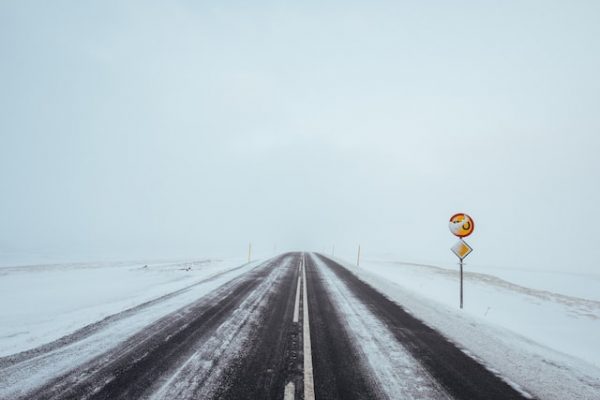
Must-see and must-do activities in Iceland during January
Threttandinn.
If you’re visiting Iceland in January, make sure to attend the Threttandinn party, the end-of-Christmas celebration that marks the final day of the holiday season. Icelanders take their Christmas and New Year’s celebrations very seriously, and Threttandinn is a perfect opportunity to combine all of these holiday traditions and celebrations into one big farewell party.
The Icelandic Yule Lads, a group of mischievous characters that come down from the mountains in the days leading up to Christmas, play a big role in the Christmas traditions in Iceland and are a big part of Threttandinn. The final Yule Lad to leave is the Candle Beggar, “Kertasníkir.”
Threttandinn is also a time of many folktales and strange happenings. There are countless stories about the unusual things that occur on this day, from cows speaking to seals shedding their skin and becoming humans. It’s a truly strange and mysterious time of year when Icelanders come to expect the unexpected.
The party includes lighting bonfires, setting off the last of the New Year’s fireworks, consuming copious amounts of newly cooked food and holiday leftovers, and playing games late into the night. It is also the time when all Christmas decorations must come down, which can be sad but also brings joyful anticipation for the upcoming year.
View this post on Instagram A post shared by Iwona Pietras (@iwona.pietras)
Dark Music Days Festival
Embrace the darkness of winter in Iceland with the illuminating Dark Music Days Festival. Despite its ominous name, this festival is a beacon of entertainment, offering a diverse array of contemporary and experimental music. Founded by the Iceland Composers Society in 1980, the festival aims to showcase Icelandic talent and attract international performers and visitors to Reykjavik.
Held primarily at the stunning Harpa Concert Hall, known for its honey comb like glass panels, the festival also includes performances in smaller venues. The festival is a really varied and dynamic event since it gets hundreds of applications each year from all around the world through its open call.
If you’re visiting Iceland in January, don’t miss the opportunity to escape the cold outdoors and discover new music in a beautiful setting. Visit the Dark Music Days Festival website for the festival program and tickets.
View this post on Instagram A post shared by Dark Music Days Reykjavik (@darkmusicdays)
Don’t miss the opportunity to experience the traditional Þorrablót celebrations. Þorrablót, which takes place from mid-January to mid-February, is a festival that has its roots in the old Norse calendar and is believed to be named after the Norwegian King, Thorri Snaersson, or Thor, the God of Thunder. It was originally a sacrifice to Thorri but over time, it evolved into a celebration of food, drink, and Icelandic culture.
It takes a strong stomach to attend a Þorrablót celebration since the meal is designed to resemble what the Vikings may have had to consume in the middle of the winter. It contains delicacies like congealed sheep blood wrapped in ram’s gut, cooked sheep head, and putrid shark meat. There are generally alternatives available, such mashed or boiled potatoes, smoked lamb, boiling-salted pork, peas, and rye bread, if you’re not feeling adventurous. All of which are accompanied with the potent Icelandic beverage known as Brennivn, sometimes referred to as the “Black Death.
The evenings at Þorrablót are filled with speeches, poems, and a lot of drinking, making it a lively and exciting experience. Though the celebrations are often held among families or coworkers, there are also town-wide Þorrablót festivals that you can join. If you’re unable to secure an invite to a Þorrablót celebration, local restaurants often add Þorrablót-related items to their menus.
So if you find yourself in Iceland in January, don’t miss the chance to experience the unique culture and flavors of Þorrablót. It’s a great opportunity to let loose and have fun, even if it requires a bit of courage to try some of the more unusual foods.”
View this post on Instagram A post shared by National Nordic Museum (@nordicmuseum)
See the Northern Lights in January
Experience the magic of the Northern Lights in Iceland by visiting in January. The long, dark days make it the perfect time to see the elusive light show, which is best viewed between September and April, but peaks in December and January. While the chance of seeing the Northern Lights is high, nature can be unpredictable, and the weather often cloudy. To increase your chances, consider taking a guided tour or renting a car and driving away from city light pollution. Remember that patience is key, and while you may not see the lights on your first try, the experience is worth the effort.
View this post on Instagram A post shared by Michael Uzell (@michaeluzell)
Experience the Beauty of Glaciers in January
See the ethereal beauty of glaciers in January, when fresh ice in electric blue hues adds an otherworldly appeal. Take a tour of Solheimajokull, located just a few hours from Reykjavik and easily accessible for glacial hiking. For a different perspective, visit Svinafellsjokull from Skaftafell Nature Reserve or hike the outlet glacier of Breidamerkurjokull at Vatnajokull glacier in the southeast of Iceland.
View this post on Instagram A post shared by Paul Prim 🤙 (@primpaul)
Geothermal Pools and Hotsprings in January
Visit the hot pots and hot tubs that are scattered throughout the country. From man-made pool complexes to natural hot springs , there are many options to choose from. Enjoy the stunning views of glaciers, snow-capped mountains, and waterfalls while relaxing in the steaming waters of the hot pots. Popular hot pots like Selljavallalaug, Hrunalaug, and Reykjadalur Hot Springs may be crowded, but offer more peace and solitude than the swimming pool complexes. Keep in mind that natural geothermal heated water of the hot pots is less regulated than the swimming pools, so the water temperature may vary. For a more luxurious experience, visit the popular Blue Lagoon or Myvatn Nature Baths, but be prepared for crowds and advanced booking.
View this post on Instagram A post shared by Cameron Hall (@cameronrosshall)
Horseback Riding in January
Experience the beauty of Iceland’s winter landscapes on horseback and get to know the unique characteristics of the Icelandic horse. Known for its small size, curiosity, and intelligence, the Icelandic horse is also known for its five gaits, making it popular for dressage and other events. Additionally, the Icelandic horse is also known for its thick, warm coat, which makes it well-suited for the harsh winter weather. Riding through the snow-covered landscapes of Iceland on one of these hardy horses is a truly unique and unforgettable experience. Not only will you get to take in the stunning natural beauty of Iceland, but you’ll also have the opportunity to learn about and bond with these special animals. Whether you’re an experienced rider or a beginner, you’ll find that an Icelandic horseback tour is a perfect way to explore the winter wonderland of Iceland.
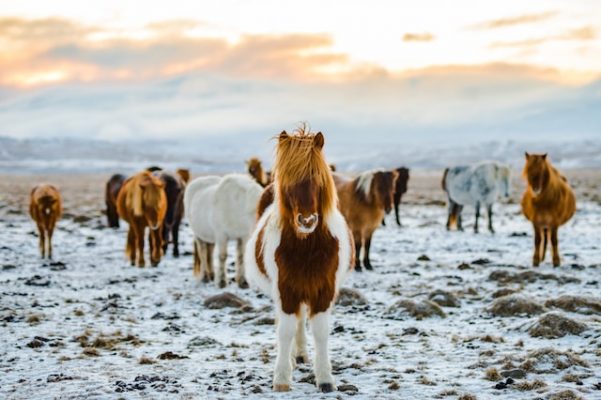
The Golden Circle in January
Discover the natural beauty of Iceland’s Golden Circle during the winter season. Start at Thingvellir National Park, home to the Silfra Fissure and site of one of the world’s oldest parliaments. Next, visit the Geysir Geothermal Area to witness the powerful eruptions of the Strokkur geyser and see the colorful hues of the steaming earth. Lastly, marvel at the frozen Gullfoss Waterfall as it cascades into a rugged gorge. With ice and snow adding to the already breathtaking landscapes, the Golden Circle is a must-see destination in January.
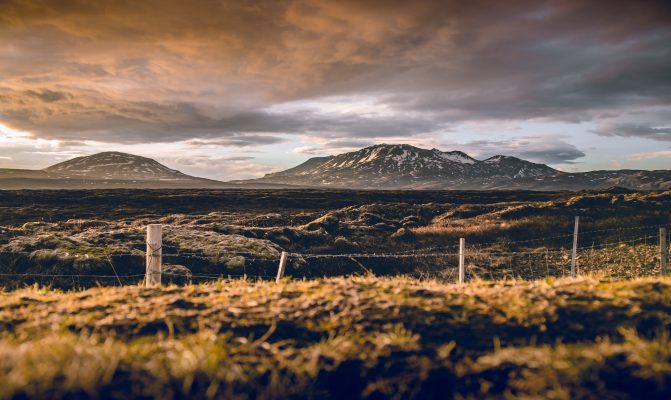
Explore Reykjavik in January
Reykjavik, Iceland’s capital city and cultural hub, offers a variety of attractions to explore all year round. From museums showcasing the country’s history and art, to historic buildings and parks, there is something for everyone to enjoy. Visitors can explore the city center on foot, by rental car, or public transport. Notable attractions include the National Museum of Iceland, Perlan Museum, Arbaer Open Air Museum, Hallgrímskirkja Church, Saga Museum, the Maritime Museum, Harpa, the Settlement Museum, Reykjavik Family Park, Reykjavik Art Museum, and Whales of Iceland. However, operating hours may be reduced during the winter, so it’s important to check in advance. Reykjavik also offers a vibrant street art scene, diverse shops, bars, cafes, and restaurants. Food enthusiasts can also take a food tour and try Iceland’s famous fermented shark dish, hákarl, as well as other local delicacies such as lamb, seafood, and geothermally grown vegetables. The annual Food and Fun Festival is also held in the winter, offering a week-long celebration of Icelandic cuisine.
View this post on Instagram A post shared by Lisa Nevière (@lisaa_pado)
Iceland offers a wide range of activities for visitors to enjoy during the month of January. From exploring the picturesque winter landscapes on horseback to soaking in the warm waters of the Blue Lagoon, there is something for everyone to enjoy. The Northern Lights, a natural phenomenon that can be observed in Iceland during the winter months, is a must-see for all visitors. Whether you’re a thrill-seeker or simply looking to relax and take in the beauty of Iceland, there are plenty of things to do in January that will make your trip truly unforgettable.
So why not pack your bags and head to Iceland this January for an adventure of a lifetime?
Frequently Asked Questions about Iceland in January
What to wear in january.
To stay warm in Iceland’s winter, wear moisture-wicking base layers, insulated mid-layers, and a waterproof outer layer. Bring good insulated boots, warm hat, gloves and scarf, bundle up and enjoy Iceland’s winter wonders!
Here are our top recommendations for what to pack for your January trip to Iceland:
- Insulated pants
- Thermal socks
- Waterproof jacket
- Down jacket
- Base layers
- Thin, long-sleeved shirts
Is January a good time to visit Iceland?
Iceland in January is one of the best months to experience many of the country’s top attractions, such as ice caving, glacier hiking, and aurora hunting. There are many fun tours available that allow visitors to fully experience all that Iceland has to offer.
Can you see northern lights in Iceland in January?
January is considered the absolute best time to visit Iceland for the Northern Lights. Although, there is a good chance of spotting the Aurora borealis in Iceland until April. After that, it’s a long wait until September to see it again.
Do you need a 4×4 in Iceland in January?
Having a 4×4 vehicle is a must in January when visiting areas in Iceland that are prone to winter weather, regardless of the condition of the roads.
Username or email address *
Password *
Remember me Log in
Lost your password?

Pack your bags
Subscribe to my newsletter to get updates in your inbox!
You have successfully joined our subscriber list.
Visiting Iceland in January: 7 Essential Things to Know

This post may contain affiliate links, meaning if you buy or book through one of these links, I may earn a small commission .
January might seem like an unconventional time to visit Iceland. I mean, in winter aren’t most people trying to head south to warmth rather than north to more cold? Perhaps the northern lights are calling your name, and you’re wondering if a trip to Iceland in January is worth it.
There are so many great reasons to visit Iceland in January. In fact, it’s often an overlooked month to visit this Nordic wonderland, due to darkness, cold temps, and high precipitation. January may fall during Iceland’s low season, but this actually brings some great perks.
For one, hotel and flight prices are lower than other times of the year. Second, you won’t be competing with large crowds at popular sights. And this is just the tip of the iceberg!
I’m so glad my husband and I followed our urge to head north instead of south this past January. As we learned, exploring Iceland in January does bring unique adventures and challenges, but it doesn’t have to be intimidating. I’ve compiled the below list of seven essential things to know when planning a trip to Iceland in January, so you too can have an out-of-this-world experience.
What to Know When Visiting Iceland in January
Here is everything you need to know, from practical tips to unique seasonal things to do.
1. January Weather in Iceland

January brings Iceland’s coldest temperatures of the year, with average highs of 35.4 degrees Fahrenheit in Reykjavik. However, this above-freezing average may surprise you, with Iceland sitting just below the Arctic Circle.
Iceland’s milder winter temperatures are thanks to the warming effects of the Gulf Stream ocean current. The Gulf Stream transports warm Caribbean water all the way to western Europe, which keeps countries like Iceland warmer than you’d expect at higher latitudes.
January is also a rather wet month in Iceland, when you will see anything from rain to snow to sleet. Maybe even all three in one day! It’s crucial to bring weather resistant clothing that will keep you warm and dry.
I recommend reviewing this packing list I made for a prior October trip to Iceland. October temperatures are only slightly warmer and conditions are just as rainy, so it’s still perfectly relevant for a January trip.
Travel Savvy Tip
Driving in Iceland can be tricky during winter months like January. With plenty of rain and snow in cold temperatures, roads can covered in snow and ice. If you are not used to driving in winter conditions, a trip to Iceland is not a good time to start.
Experienced and confident winter drivers should book a vehicle with four wheel drive and snow tires. However, less experienced drivers should consider booking tours to let a local handle any difficult road conditions. Regardless of experience, all drivers should always check Iceland road conditions on this website before heading out.
Although road tripping around the entirety of Iceland is quite popular in summer, it’s less so in winter. Weather can make some roads dangerous or impassable. Therefore, for a winter trip, it’s best to choose a home base and do day trips as weather permits.
2. You Might See the Northern Lights

During January in Iceland, northern lights hunting season is in full swing. January is one of Iceland’s darkest months of the year, with only about 4-5 hours of daylight. As darkness is needed to see an aurora, these conditions increase the likelihood of a sighting.
While it’s possible to see the northern lights from Reykjavik, it’s best to go aurora hunting outside the city. To the untrained eye, the lights could be mistaken for a cloud if there is too much light. With more darkness, auroras are much easier to spot.
To make sure you don’t accidentally miss the northern lights, it’s best to join a tour . The guides are experts who will know exactly where to go based on projected cloud cover. They will also teach you how to hunt the lights on your own and give you a better understanding of the night sky.
3. Golden Hour Lasts All Day

The sun doesn’t come out often in Iceland, so its appearance is always a treat. This is especially true in January, when the sun never fully rises. Translation: a sunny day in January means five hours of sunset lighting.
That means all your daytime activities will be done during the backdrop of golden hour. This makes for beautiful photos and adds extra magic to the gorgeous landscapes all around you.
The one drawback to this beauty is that constant golden hour can be a pain for driving. When you are facing towards the sun, its low position on the horizon can be blinding. So bring sunglasses!
4. January in Iceland is Ice Caving Season

In Iceland, ice caving can only be done between November and March, so don’t miss out! Carved out of glaciers, the ice caves range in color and are only accessible when temperatures drop. Therefore, it’s a no-brainer to book a tour during a January trip to experience one of these beauties for yourself.
The most enchanting option is this amazing natural blue ice cave near the Jökulsárlón Glacier Lagoon. To reach it, you must first road trip down Iceland’s scenic South Coast, which is an exciting day trip in itself. The drive takes around five hours, and is a good opportunity to stop and see the famous waterfalls and black sand beaches along the way.
If you are iffy about doing the drive on your own, you can book a bus tour to transport you to the glacier lagoon, while making stops along the South Coast. Even if you self-drive, you will need to book a tour to visit the ice cave. While stunning, ice caves can be dangerous without the instruction of a trained guide.
5. Warm Up from the Cold in a Hot Spring

There is nothing cooler than cozying up in Iceland’s steamy hot springs as you sip bubbly during a gentle snowfall. Iceland has so many fabulous hot springs to choose from, whether rustic or chic, and you don’t even have to go far from Reykjavik.
The two most famous hot springs are the Blue Lagoon and Sky Lagoon. The Blue Lagoon is hard to resist, with its otherworldly milky blue waters and close proximity to Keflavik Airport. Its moonscape is what originally lured me to Iceland in the first place.
On the other hand, the newer Sky Lagoon offers a magical experience of its own. This hot spring is only thirteen minutes from Reykjavik by car and is situated right on the ocean. On a clear day, you can watch the sunset while indulging in “The Ritual” – the Sky Lagoon’s seven-step spa experience.
No matter which hot spring you choose, you have to add at least one to your Iceland itinerary !
6. Keep Your Plans Flexible

There’s no getting around the fact that weather in Iceland is volatile and hard to predict. If the forecast calls for rain, you might get sun and vice versa. It’s hard to rely on any prediction too closely, as conditions can change suddenly.
Obviously, this makes planning a January trip to Iceland quite tricky. How will you know if you can do that day trip or not without an accurate weather prediction?
While I’m typically the type of person who likes to plan ahead, when traveling to Iceland this will only cause undue stress. That’s why on our recent January trip, my husband and I didn’t finalize anything until the day before, or even the morning of, our planned excursions.
The one thing we did book ahead was our Northern Lights Super Jeep tour. This is because we could reschedule or get our money back if the weather precluded the tour from going out.
If you do book a tour in advance, make sure it has a good cancellation policy. For a northern lights tour in particular, it’s good to book a tour operator that won’t go out if weather conditions are not ideal. That way you won’t waste your time and money freezing in the cold for nothing.
7. Consider Bus or Super Jeep Tours

One way to add some certainty into your itinerary is by booking bus or Super Jeep tours for popular day trips, like the Golden Circle or South Coast. That way, if the roads are slicker than you’re comfortable with, a local guide will handle the driving for you.
Booking tours will often make your trip more expensive than self-driving. However, if it’s the only way you can see the Golden Circle during your limited time in Iceland, then it’s worth it.
Be sure to look for bus tours for the Golden Circle or South Coast that add in experiences like northern lights hunting or glacier hiking. It’s a good way to help your time and money go even further!
Who said January wasn’t a magical time to visit Iceland? Whether it’s seeing the northern lights or hiking through a moonscape to an ice cave, Iceland will blow your mind.
Will you be booking a January trip to Iceland soon?

Related Posts
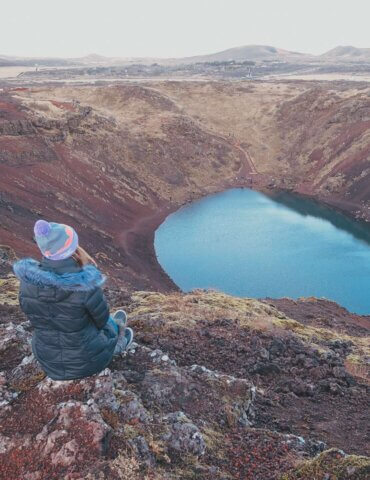
Leave a Reply Cancel reply
Your email address will not be published. Required fields are marked *

Visiting Iceland in January: Pros, Cons, and Tips for 2023

If you’re planning on visiting Iceland in January, you’re in for a treat. The country is blanketed in snow, making it a winter wonderland. But is it the best time to visit Iceland? In this article, we’ll explore the pros and cons of traveling to Iceland in January, including tips on how to make the most of your trip.
We’ll cover everything from the weather and the northern lights to the activities and festivals you can expect to encounter. So, if you’re considering a trip to Iceland in January, keep reading to learn more.
About Iceland in the Winter
Iceland in january: pros, iceland in january: cons, events in iceland in january, visiting in december instead, visiting in february instead, our final thoughts.

Iceland is a land of contrasts, known for its dramatic landscapes, otherworldly natural phenomena, and unique culture. Winter in Iceland brings shorter days, colder temperatures, and the possibility of snow and ice.
While visiting Iceland in the winter may not be for everyone, it can be a magical experience for those willing to brave the elements. In this guide, we’ll explore what to expect during the winter months of December, January, and February in Iceland, as well as some tips to make the most of your trip.
One of the main reasons to visit Iceland in the winter is to witness the stunning Northern Lights, which are most visible from September to April. December, January, and February offer some of the longest nights of the year, making them prime time to try and catch this natural phenomenon.
However, the weather in Iceland in the winter can be unpredictable and challenging, with snowstorms and icy conditions potentially disrupting travel plans. Despite these challenges, winter in Iceland also brings the possibility of unique experiences such as soaking in hot springs under a blanket of snow, exploring ice caves, and seeing frozen waterfalls.
With proper planning and preparation, Iceland in the winter can be a rewarding and unforgettable adventure.
For a deeper dive into the best time to visit Iceland, please see our comprehensive guide to the best time to visit Iceland .
Pros and Cons of Iceland in January
As with any month of the year, there are going to be advantages and potential disadvantages to exploring Iceland in January. Keep in mind, every month is wildly different for Icelandic adventures. January is no exception. Below are some of the pros and potential cons of Iceland in January.

Visiting Iceland in January offers a unique experience that is unmatched during other times of the year. One of the most significant advantages of traveling to Iceland in January is the chance to see the Northern Lights, which are visible almost every night during this time of year.
Additionally, January offers a winter wonderland landscape that is truly breathtaking, with frozen waterfalls, ice caves, and snow-covered landscapes.
Visiting Iceland in January also offers the opportunity to participate in unique winter activities such as glacier hiking, ice caving, snowmobiling, and dog sledding. This is the time of year when the ice caves are at their most stunning and accessible, offering a once-in-a-lifetime experience.
Plus, you can enjoy the hot springs and geothermal pools, which are even more enjoyable in the cold winter months. Finally, January is one of the least crowded times of the year in Iceland, allowing for a more peaceful and intimate experience with the natural beauty of the country.
Overall, visiting Iceland in January offers a unique and unforgettable winter wonderland experience with plenty of opportunities for adventure and relaxation.
One of the main disadvantages of visiting Iceland in January is the extreme cold weather. The average temperature in Reykjavik, the capital city, during January is around -1°C (30°F), but it can often drop to -10°C (14°F) or lower, particularly at night. This can make outdoor activities, such as hiking, sightseeing or even walking around the city, extremely uncomfortable.
Additionally, the shorter days in January mean there are fewer hours of daylight, with sunrise typically occurring around 11 am and sunset around 3:30 pm, which can limit the amount of time you have to explore Iceland’s beautiful landscapes.
Another con of visiting Iceland in January is the potential for hazardous road conditions. The roads in Iceland can be icy and snowy during the winter months, particularly outside of Reykjavik. It is essential to check the weather forecast and road conditions before embarking on a journey, and it is recommended to hire a four-wheel-drive car to ensure safety on the roads.
The weather in January can also be unpredictable, with frequent snowstorms and blizzards, which can disrupt travel plans and cause delays or cancellations in flights or tours.

There are plenty of events taking place throughout Iceland in the month of January. Here are just a few of the events in Iceland in January:
- Reykjavik Winter Lights Festival – This festival celebrates the winter season and takes place over several days. It includes music performances, art installations, and light displays around the city.
- Dark Music Days – This music festival features contemporary classical music and takes place at Harpa Concert Hall in Reykjavik.
- Thorrablot – This traditional Icelandic festival celebrates the midwinter season with traditional food and drink, including fermented shark and sheep’s head.
- Reykjavik International Games – This event brings together athletes from around the world to compete in various winter sports, such as skiing and snowboarding.
- Northern Lights tours – January is a great time to see the Northern Lights in Iceland, and there are many tour operators that offer Northern Lights tours throughout the month.
- Winter hiking and skiing – Many hiking trails and ski resorts are open during the winter season, providing opportunities for outdoor activities and adventure.
- New Year’s celebrations – Icelanders celebrate New Year’s Eve with fireworks and parties, and the festivities continue into January with parades and concerts.
Tips for Visiting Iceland in January
Visiting Iceland in January can be an incredible experience, but it’s important to be well-prepared for the unique challenges that come with the winter season. One of the most important things to keep in mind is the weather. Winter in Iceland can bring extreme conditions, with heavy snowfall, strong winds, and low temperatures. Dressing in warm, waterproof layers is essential, as is investing in sturdy, slip-resistant footwear.
Another important consideration is daylight hours. In January, Iceland has just a few hours of daylight each day, so planning activities accordingly is crucial. This can also mean that driving can be challenging, as roads can be icy and visibility can be limited. It’s important to have experience driving in winter conditions or to hire a local driver.
Despite the challenges, visiting Iceland in January can also offer unique opportunities, such as the chance to see the incredible Northern Lights or to take part in winter activities like ice skating, skiing, and snowmobiling.
To make the most of your trip, it’s important to research and plan ahead, book tours and accommodations well in advance, and be flexible with your itinerary to account for weather conditions. By taking these precautions and preparing accordingly, you can have a safe and unforgettable winter adventure in Iceland.
As always, if you’re looking to get up-to-date information on the unpredictable weather in Iceland, there is one primary source. That source is Vedur.is .

While January may be a popular time to visit Iceland, those looking to experience a winter wonderland may want to consider visiting in December instead. Not only will you get to enjoy Iceland’s stunning winter landscapes, but you’ll also have a chance to experience the country’s festive holiday season.
December is also a great time to catch a glimpse of the Northern Lights, as the longer nights increase your chances of seeing the colorful auroras dancing in the sky.
For a deeper dive, please see our full article on Iceland in December .
For those looking for a bit more daylight and milder weather, visiting Iceland in February may be a better option than January. While still considered the winter season, February brings longer days and slightly warmer temperatures, making it a great time to explore Iceland’s outdoors.
Plus, with fewer crowds than in January, you may have more opportunities to take in the stunning natural scenery without the hustle and bustle of peak tourist season.
For a deeper dive, please see our full article on Iceland in February .
Whether you choose to visit Iceland in January or opt for another month, there are plenty of pros and cons to consider. January may offer prime Northern Lights viewing and unique winter activities, but the shorter days and colder temperatures can be challenging.
Ultimately, the best time to visit Iceland depends on your personal preferences and travel style. No matter when you go, be sure to come prepared with warm clothing, a sense of adventure, and an open mind to experience all that this beautiful country has to offer.
Leave a Comment Cancel reply
Save my name, email, and website in this browser for the next time I comment.
- Skip to right header navigation
- Skip to main content
- Skip to secondary navigation
- Skip to primary sidebar
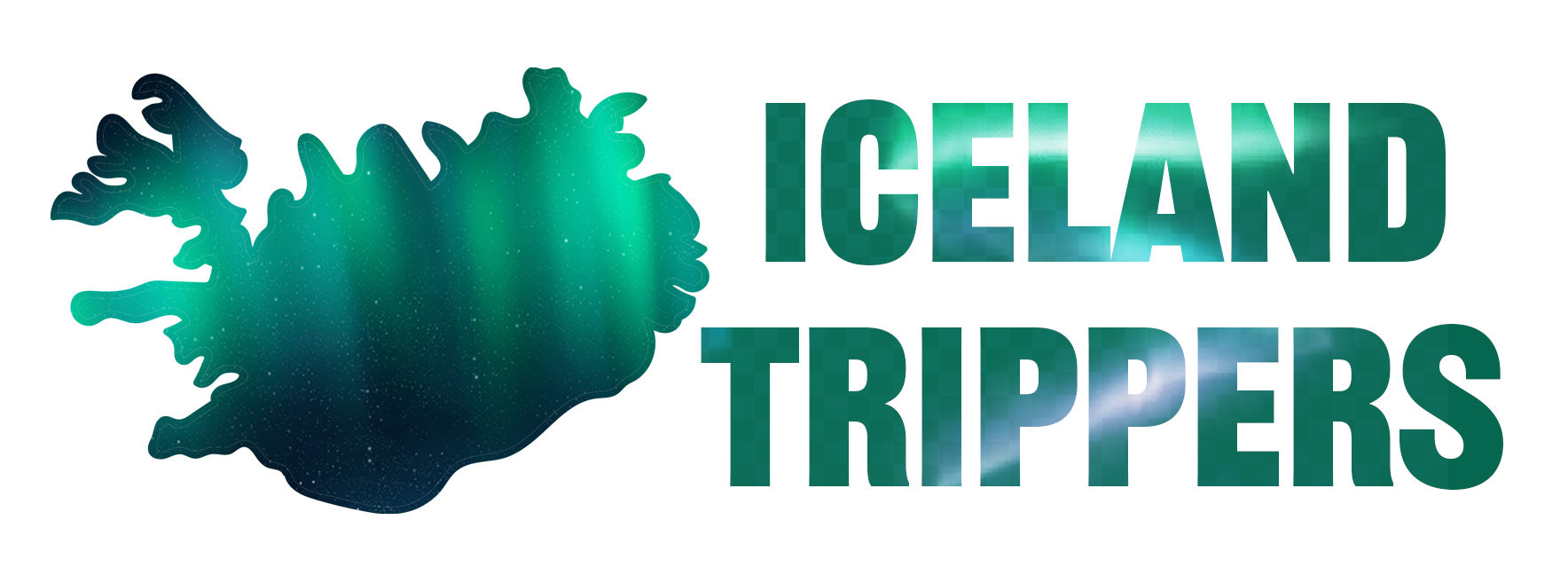
Learn how to easily plan your dream trip to Iceland with helpful guides and tips!
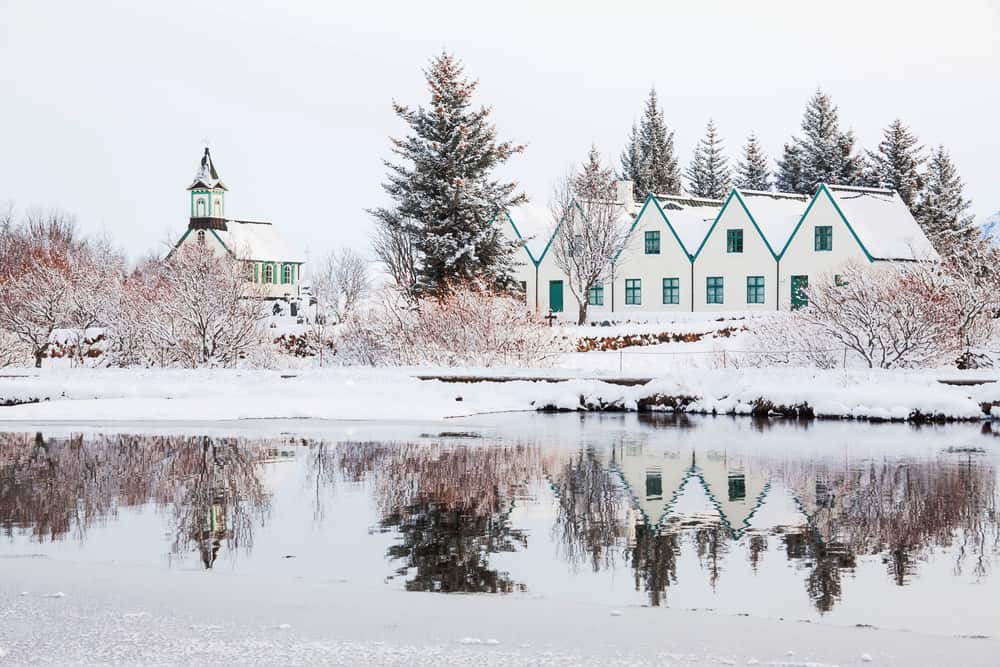
Iceland In January: 6 Things To Know Before You Go
December 18, 2023 // by Iceland Trippers // 4 Comments
Are you traveling to Iceland in January? We’ve got you covered with six things you should know before beginning your adventures. I love Iceland any time of year and have been in all seasons. Let me take you through what to expect! This list will include some of the best Iceland tips for January including how to see the Northern Lights, where to find the best natural hot springs, and how to experience the lingering Christmas and New Year festivities! You’re in for a truly amazing trip.
Planning your trip to Iceland last minute?
Make sure to book your hotels and tours in Iceland in advance to ensure availability! The longer you wait, the more difficult it gets. Here are my top picks for your trip :
Top Experiences And Tours In Iceland:
- Golden Circle Full Day Tour From Reykjavik (Likely to sell out!)
- Silfra Snorkeling Tour (Includes photos + only small group)
- South Of Iceland Full Day Trip (Our pick!)
- Whale Watching In Reykjavik (On a luxury yacht)
- Northern Lights Bus Tour (Great to go with a local)
- Ice Cave Tour And Glacier Hike (Likely to sell out)
Tickets You MUST book in advance:
- Keflavik > Reykjavik Bus Airport Transfer (Skip the line!)
- Sky Lagoon Entrance Ticket (Includes 7-step spa ritual)
- Blue Lagoon Entry Ticket With Drink (Likely to sell out!)
Top picks for places to stay in Iceland:
- Hotel South Coast (Great central location)
- Grandi Reykjavik (Includes free breakfast)
- Hotel Kria (Close to black sand beach)
- Hotel Skaftafell (Mid-range price)
Though the sunlight hours are short, there’s still plenty to do, and so many of Iceland’s spectacular natural wonders to see in all their winter glory. January temperatures in Iceland range from -5°C to 1°C (23°F to 34°F) which is no colder than any other Northern city during this time of year!
Though January in Iceland still attracts many tourists, the numbers are lower than the popular summer months. So take advantage of the smaller crowds, grab your cold-weather gear, and get ready for a remarkable experience.

6 Things To Know Before Visiting Iceland In January
#1. the dark music days festival is a source of light in iceland in january.
Despite its foreboding title, the Dark Music Days Festival (Myrkir Músíkdagar in Icelandic) is actually meant to be a source of light, entertainment, and pure enjoyment in the dark, long days of winter.
The actual music being performed is a collection of all different sorts that you can expect to be contemporary and often experimental It was started in 1980 in an attempt to both showcase Icelandic compositions and performers as well as bring international performances and audiences to Reykjavik.
The main venue for this annual festival is the Harpa Concert Hall IN downtown Reykjavik. Some of the performances however occur at smaller venues in the area.
If you’re visiting Iceland in January towards the end of the month, and you are interested in escaping the dark, cold outdoors by listening to new music in a beautiful venue, check out the Dark Music Days Festival website for a festival program and tickets. Add this to your list of things to do in Reykjavik in January.
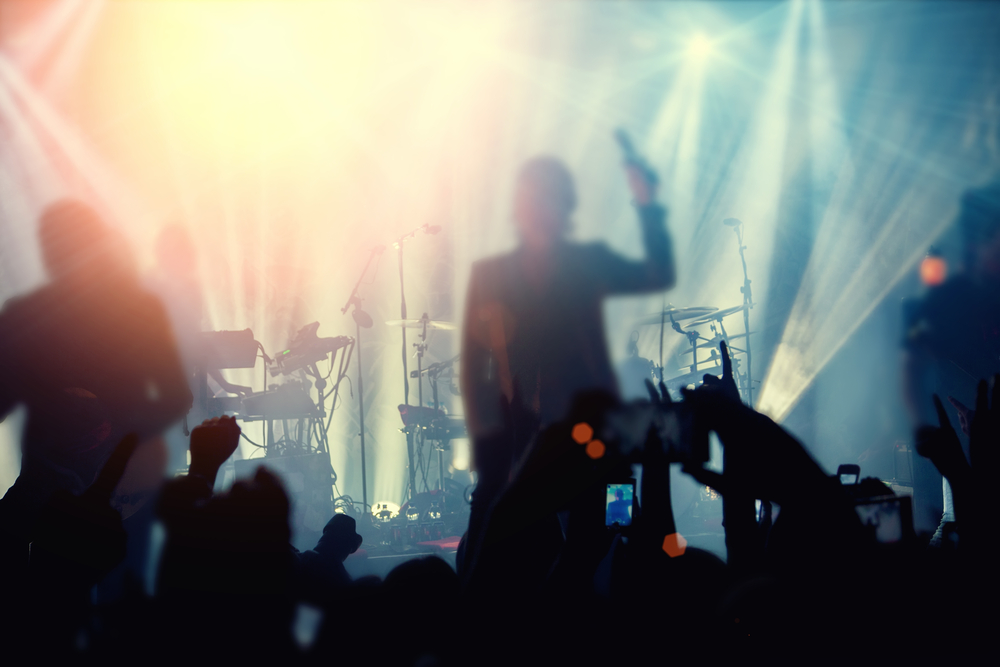
#2. A Thorrablot Party Will Have You Eating And Drinking Like A Viking
Thorrablot refers to the celebrations during the month of Thorri. They occur from mid-January to mid-February and begin on a Friday in the thirteenth week of winter.
This was based off the old Norse calendar. When visiting Iceland in January, you’ll want to try to score an invite to a Thorrablot celebration…that is if you can stomach the food and drink.
Attending a Thorrablot celebration takes a strong stomach. The food menu is meant to replicate what the Vikings might have been forced to eat midwinter and includes rotten shark meat, boiled sheep’s head, and congealed sheep’s blood wrapped in a ram’s stomach.
For those less adventurous souls, the food options usually also include mashed or boiled potatoes, smoked lamb, boiled-salted meat, peas, and rye bread. All of this food is washed down with strong Icelandic liquor called Brennivín, which is commonly referred to as the “Black Death.”
The evenings are also filled with speeches and poems in remembrance of the old times. And as the liquor continues to flow, Icelanders party like Vikings into the early morning hours.
Though Thorrablot is often a feast among families or coworkers, if you ask around, there’s often a town-wide Thorrablot festival that you might be able to join in. Or perhaps you’ll become good enough friends with a local to get an invite to their family affair.
So if you find yourself out in the countryside, expand your palate with a whole host of bizarre foods and maybe burn your clothes to leave the smell behind before you return home. This is by far one of the more unique things to do in Iceland in January

#3. Threttandinn Is The End Of Christmas Party You Won’t Want To Miss
If you are visiting Iceland in January, Threttandinn is a party you won’t want to miss. Threttandinn translates to “the thirteenth” and marks the final day of Christmas and the end of Christmas celebrations. Icelanders take their Christmas and New Year’s celebrations very seriously.
Christmas is full of delicious food, family, and folklore, and New Year’s is an explosion of fireworks and bonfires. Threttandinn combines all of these holiday traditions and celebrations into one big “go out with a bang” party to wrap up the holiday season.
The Icelandic Yule Lads are a big part of the Christmas traditions and in a sense replace the jolly, plump, bearded fellow that Americans know and love. Yule Lads are mischievous characters that come down from the mountains one by one in the days leading up to Christmas, and they slam doors, lick pots, and steal meat among other things.
Icelanders celebrate 13 days of Christmas beginning December 24 th , and during these 13 days, the Yule Lads return to the mountains one by one. On Threttandinn, the final Yule Lad to leave is the Candle Beggar, “Kertasníkir.”
In between storytelling and saying goodbye to the Candle Beggar, Icelanders light bonfires, and the last of the New Year’s fireworks are also lit, as it’s the last day that it’s legal to set them off.
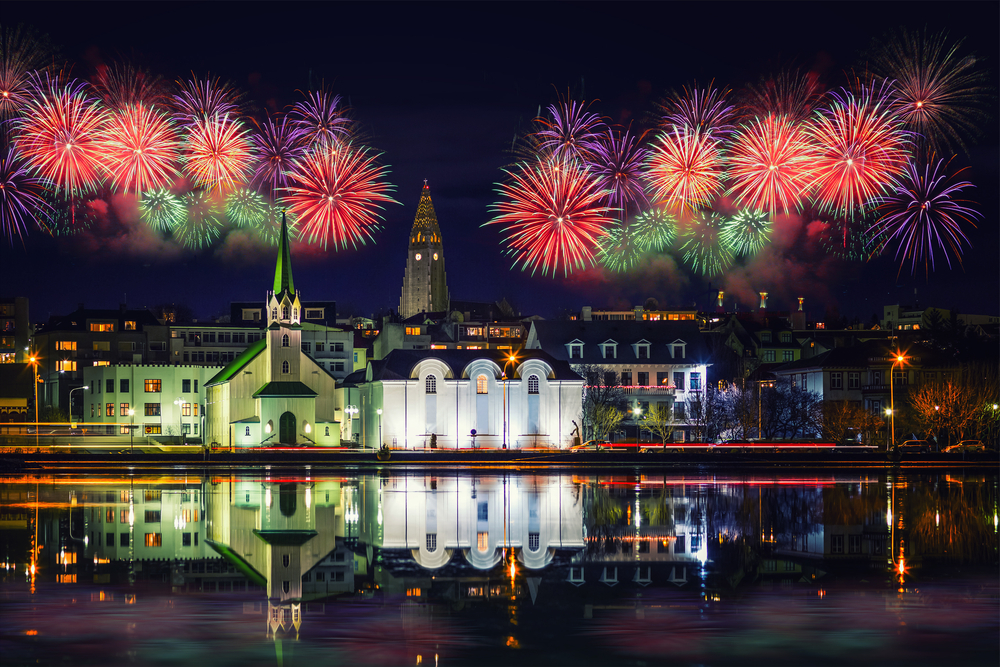
#4. If Conditions Are Favorable, You Might Catch The Elusive Northern Lights
Your chances of seeing the Northern lights in Iceland during January are greatly increased! The brilliant natural light show is strictly a winter phenomenon and is one that people from all over the world flock to Iceland to see. We have an extensive guide on How To See The Northern Lights with tons of tips and tricks!
The long, dark days in January are extremely conducive to spotting the elusive lights. Though they can potentially be seen from September to April, the mid-winter months of December and January are prime viewing times. You can venture out early in the evening without having to wait until the middle of the night for darkness to fall.
If you’ve ever been fortunate enough to see the Northern Lights in person, you know that they are remarkable. Unfortunately, Iceland’s weather is often rainy or snowy, and these conditions do not bode well for Northern Lights viewing.
Patience is key, and perhaps if you wait long enough, you’ll be rewarded with a brilliantly colorful night sky.
Maximize your chances of seeing the Northern Lights, by taking a guided Northern Lights tour . This is a popular option because the tour guides are incredibly knowledgeable and chase the lights for a living.
They know the go-to places to wait and watch. Despite their extensive knowledge and their desire to give you the best possible shot of seeing the lights, they do not control the lights. We have a list of the Best Northern Lights Tours in Iceland!
Most tour companies do allow you to rebook a second trip at no extra charge if the lights were not visible during your tour.
You can also take your own rental car and drive away from the city to search for the lights yourself. The farther you are from the city light pollution, the darker the skies and the better chance you have of seeing anything.
We suggest you track the aurora strength and visibility and continue checking it throughout the night. The forecasts change frequently, sometimes by the hour or minute. Though Northern Lights viewing takes some preparation and a whole lot of luck, it’s a remarkable sight and one worth taking a chance on!
Quick Tips for Seeing the Northern Lights In January
- Ideal Conditions : January is one of the best months to see the Northern Lights in Iceland due to the long, dark nights.
- Check the Forecast : Look up the Aurora forecast to find out the likelihood of Northern Lights activity and cloud cover. The Icelandic Meteorological Office website is a reliable source.
- Escape Light Pollution : Travel away from city lights for the best viewing. Places with clear, dark skies are ideal.
- Guided Tours : Consider a guided Northern Lights tour. Guides are experienced in finding the best spots and times for viewing.

#5. Take Advantage Of Hot Pots and Hot Tubs
Iceland temperature in January drops significantly…but you should still bring your swimsuit! We cannot stress this enough. There is nothing quite like sitting in a steaming hot tub or hot pot in the middle of winter, surrounded by snow while reflecting on the adventures of your day.
It does seem counterintuitive to bring a swimsuit to a country called Iceland during the coldest time of the year, and yet there are so many opportunities to wear it. There are so many Hot Springs in Iceland to visit!
Every town in Iceland has at least one swimming pool complex (Reykjavik has many). These complexes often included a heated lap swimming pool, a heated kiddie pool, and multiple hot tubs of differing temperatures. Laugardalslaug, the main pool in Reykjavik, even has a salt-water hot tub.
If bathing in the middle of nature while gazing at glaciers, snow-capped mountains, or waterfalls is more your style, Iceland has a remarkable number of hot pots throughout the country for your enjoyment.
Though some of the more popular hot pots like Selljavallalaug , Hrunalaug , or the Reykjadalur Hot Springs have the potential to be congested with visitors, you’ll often find the hot pots offer more peace and solitude than the swimming pool complexes.
If you’ve begun planning a trip to Iceland in January, you’ve no doubt heard of the extremely popular Blue Lagoon, or its northern counterpart, the Myvatn Nature Baths. Both of these are great alternatives to hot tubs and hot pots but are much more expensive.
They are both impressive and relaxing, however, the increase in tourism has made them overcrowded. Even in an “off-season” month like January, the Blue Lagoon requires advanced booking and it’s encouraged to arrive at the Myvatn Nature Baths right when they open. Despite their crowds and hefty prices, both experiences are worth a visit at least once.
The Blue Lagoon is in a great area and is actually on our list of Best Places To Stay In Iceland . In this post, we offer suggestions for where to stay around the Ring Road!

#6. Checking Road Conditions Is Critical When Driving In Iceland In January
Iceland’s weather in January can be harsh. You’re likely to experience all that comes with midwinter in a cold country, and that includes snow on the roads. If you’re staying around Reykjavik you won’t need to worry, because the roads around the capital region are very well maintained.
Many of the main tourist attractions are also almost always still accessible. No matter where you drive though it’s important to keep an eye on the road conditions as they’re constantly changing. Use common sense when deciding whether it’s safe to be out driving, and if you don’t have experience with driving in harsh winter conditions, be extra careful and err on the side of caution.
Iceland has search and rescue teams that will come to your aid if you find yourself in a bind. Please use them only as a last resort, and don’t enter into a risky situation purely because you think you have the search and rescue team as a crutch to fall back on.
It’s usually tourists they have to rescue who get themselves into dangerous situations as a result of overconfidence and/or a lack of preparation.
If you choose to rent a car in Iceland in January, your car will come equipped with winter tires that are designed to be safer when driving on ice.
Though they are certainly helpful, they are not fool-proof, so exercise caution and don’t speed. Salt and snowplows are used on the main roads, but the farther you venture from the capital region, the less the roads are maintained.
You should always be careful when driving the highland roads (F roads). Though they will usually be closed in January, if you happen to find yourself driving on one, you should exercise a healthy dose of caution.
F roads are gravel roads and usually result in a rough driving experience. They are not designed for fast driving or winter driving. It’s harder to tell what kind of ice is lying on these unpaved roads, and water puddles may be deeper than you initially think.
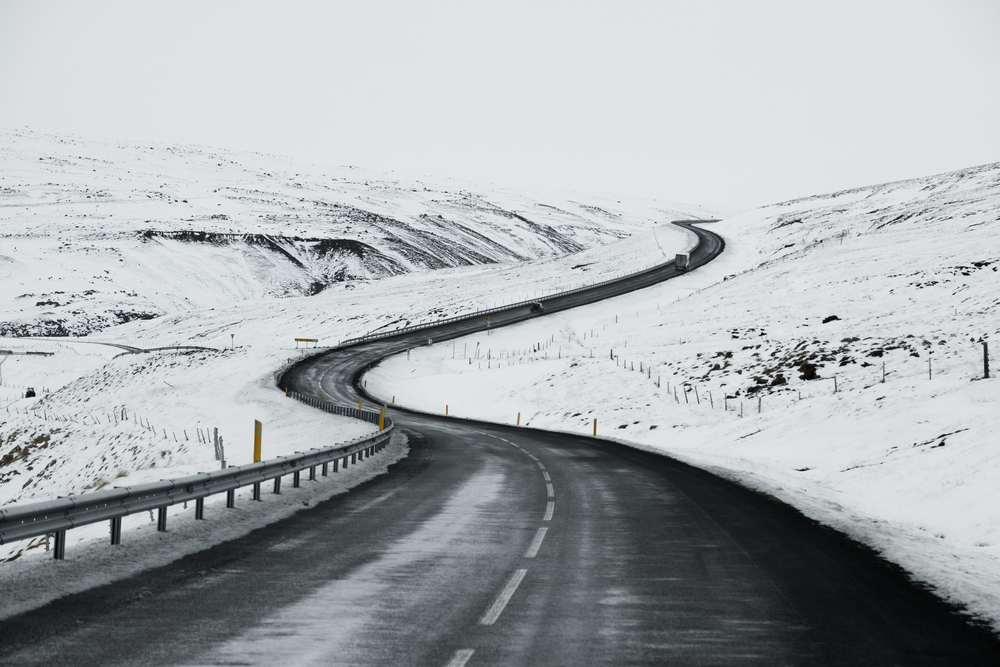
Iceland in January Weather Tips
Traveling to Iceland in January can be a magical experience, offering unique winter landscapes, stunning Northern Lights sightings, and festive activities.
However, winter weather in Iceland is unpredictable and can be challenging, requiring visitors to be well-prepared. I have visited multiple times in January! Here are my tips!
General Iceland Weather in January :
- Temperature : Temperatures in Iceland in January typically range from about -5°C to 1°C (23°F to 34°F). However, temperatures can be lower, especially in northern and inland areas.
- Northern Lights : January is a great month for Northern Lights viewing. Check forecasts and consider guided tours for the best experience.
- Average Snowfall : January is one of the wetter months. Average precipitation ranges from 30mm to 50mm, mostly in the form of snow, especially in northern and inland areas.
- What to wear in Iceland in January : If you’re visiting Iceland during January, wear thermal layers, a windproof and waterproof outer layer, a warm hat, gloves, and insulated, waterproof boots.
Reykjavík Weather in January :
- Temperature: Reykjavik weather in January is milder than the rest of Iceland but still cold, with temperatures around -1°C to 3°C (30°F to 37°F). Snow and rain are common.
- City Walking : The city’s sidewalks are usually well-maintained, but waterproof and slip-resistant footwear is still recommended.
- Average Snowfall : The city experiences a mix of rain and snow in January. Average snowfall in Reykjavik can vary, but expect several snowy days, with snow often accumulating and then melting in variable cycles.
- Indoor Activities : Take advantage of Reykjavik’s museums, galleries, and geothermal pools, which are perfect for cold days.
Weather Tips
- Prepare for Wind : January weather in Iceland can be extremely windy, which makes the cold feel more intense. A windproof jacket is essential.
- Swimwear for Hot Springs : Don’t forget to add your swimsuit to your Iceland packing list for January dips in hot springs or geothermal pools, a must-do in Iceland.
- Check Road Conditions : January driving in Iceland can be challenging. Regularly check the Iceland Road Administration website or app for up-to-date information on road closures and conditions.
- Cold and Dark : January is one of the coldest months in Iceland, with temperatures often below freezing. Daylight is limited, averaging only 4-5 hours.
- Stay Informed : Keep an eye on the weather forecast and listen to local advice, especially regarding aurora borealis sightings, storms, or severe weather warnings.
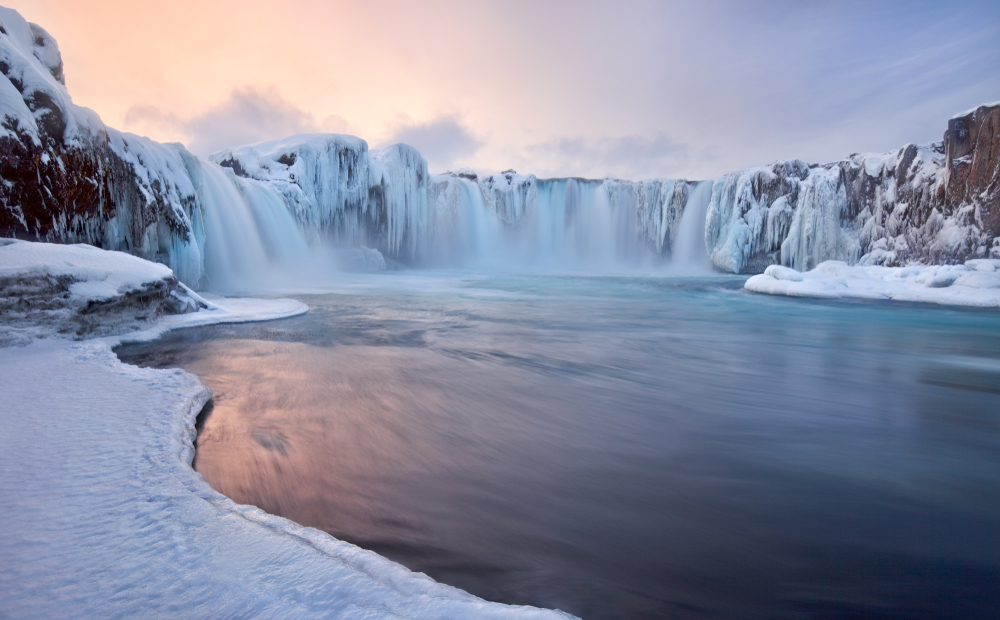
If you’ve been considering traveling to Iceland in January, go ahead and book your trip! It has the potential to be a beautiful time of year with snow and Northern Lights, and Iceland has proved itself to be a country worth exploring any time of year.
Be careful and pay attention to the winter weather conditions, but have fun, listen to inspiring music, and party like a Viking! If you have any questions about how to maximize your trip, please let us know in the comments.

Reader Interactions
December 4, 2022 at 4:19 pm
Thanks for the advice. Myself and my son (70 and42) are coming over on the 19th January and would value your advice on what to see especially as very little daylight. We have already booked a northern lights cruise and I think golden circle tour
Many thanks
Glyn …
December 29, 2022 at 2:27 pm
I also highly recommend Sky Lagoon and the south coast of iceland if you can get down there to see the black sand beach and waterfalls!!! i prefer that to golden circle personally!
December 30, 2022 at 7:31 am
Hello! Thank you so much for the useful advice! I’m planning to visit Iceland on 24-31 January with my husband and we’d like to rent a car to drive through the south. My question is whether there are options to stay around and what things we’ll be able to do at nighttime, apart from chasing the Northern Lights. Thanks in advance!
January 1, 2023 at 8:14 pm
Hello1! Yes in the south there are places to stay along! I like to stay in Airbnb and cook my own food but it is up to you. There isn’t much to do at night it is very rural, beyond going out to dinner. So just cozy up and maximize your daylight!!
Leave a Reply Cancel reply
Your email address will not be published. Required fields are marked *
Save my name, email, and website in this browser for the next time I comment.
ICELAND IN JANUARY 2024
You must be here because you would like to know how Iceland is in January, right?
Well, I can help you with that!
January is usually the coldest month on planet earth. Iceland is an isolated small island – in the middle of the huge Atlantic ocean - so no exception there.
To put it in simpler terms, it might be a little cold at this time – but it might not be as cold as you think!
Despite a little cold (or perhaps because of it), Iceland is incredibly beautiful and I'll show you exactly why January is one of my favourite months of the year!
Keep reading for the best tours and activities, some local tips, average temperature and more for January in Iceland!

ICELAND IN JANURY quick facts:
My opinion is that January can absolutely be our most beautiful month of the year. It's almost impossible to beat the super cold crispy winter days in January.
- Average temperature: 30-33 Fahrenheit
- Sunrise 10:30am / Sunset 4:30pm
- Less crowded / touristy: More availability on tours, hotels etc.
- Good time for Northern Lights: Yes! (Great time actually)
- Best things to do: View our local recommendations of activities below!
January is always wonderful in Reykjavik. If you look at it from a summer vs. winter perspective, the whole country is like two different worlds. In June we have green grass and sun during the night. In January, Iceland turns into an incredibly beautiful winter-wonderland!
Picture this: You're standing outside in the clean, cold winter air and when you look up you see, illuminating the night, the dancing Aurora Borealis - the Northern Lights.
How amazing does that sound?
But now I've made it sound a bit cold, haven't I. How cold is it actually? Let's take a closer look.
WEATHER IN JANUARY
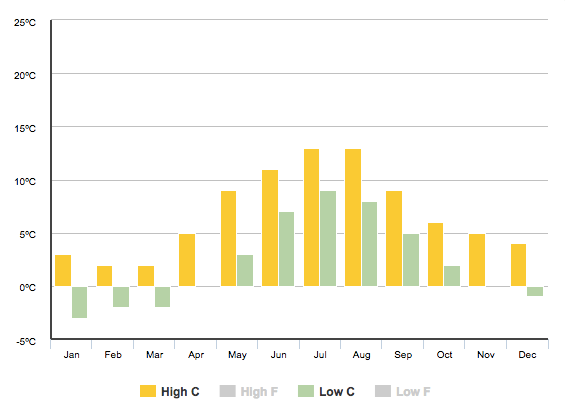
Average temperature in Reykjavik in January ranges from -1 to +1°C (30-33 Fahrenheit).
The temperature might fluctuate anywhere from -10 to +5°C. So, Iceland is definitely not as extremely cold as you might have imagined! Generally in the winter it does snow a lot here, especially in January and February. In Reykjavik however, it snows much less than in the country or especially up north. Sometimes we have almost no snow at all during the winter in the city!
Here is another thing I think you should know: December and January are when we have our shortest days.
In other words... These are our darkest days!
Since our beautiful Iceland is located so close to the arctic circle, the days get super short during the winter … And of course, it’s the opposite during midsummer with 24 hours of daylight!
With that being said, we get somehwere around 4-6 hours of good daylight each day in January! The shortest days are in the beginning of January but by the end of the month day days are almost 7 hours long.
For some people, this might sound a little terrifying, but not only does the snow light up the day – all uncertainty about the daylight flees if you are lucky enough to have the night lit up by the magical northern lights above you!
BEST THINGS TO DO IN ICELAND IN JANUARY
There are so many things that you can do in January, some things that you wouldn't be able to do during other times of the year. At least they might be a bit different. You can do almost all of the same great things in January as you would do during the summer too.
Here are a few suggestions for things to do in Iceland that are especially awesome in January!
1.NORTHERN LIGHTS IN JANUARY
If you’re wondering, "is January a good time to see the Nothern lights in Iceland?" Well, then the answer is YES ! Due to the very early sunset, January is one of the best months of the year to see the northern lights!
Here is a little northern lights motivation before reading any further:
To go hunting for the northern lights, you’ll have two great options to choose from:
OPTION 1: GO ON A NORTHERN LIGHTS HUNT DRIVE YOURSELF
This can be a lot of fun and something I would definitely recommend if you’ve rented a car in Iceland.
I get asked a lot whether it's possible to see the northern lights from the downtown area. Yes, sometimes … But it’s rather uncommon due to the light pollution from the city. You will definitely want to get out of the city for the highest chance of seeing the lights.
It can be a bit tricky to decide on the perfect day of the week, time of night and area to explore. But not to worry! We’ve written a really informational, in-depth guide on how find and see the best northern lights on your own.
You can find the guide here :)
OPTION 2: JOIN A SMALL GROUP NORTHERN LIGHTS TOUR
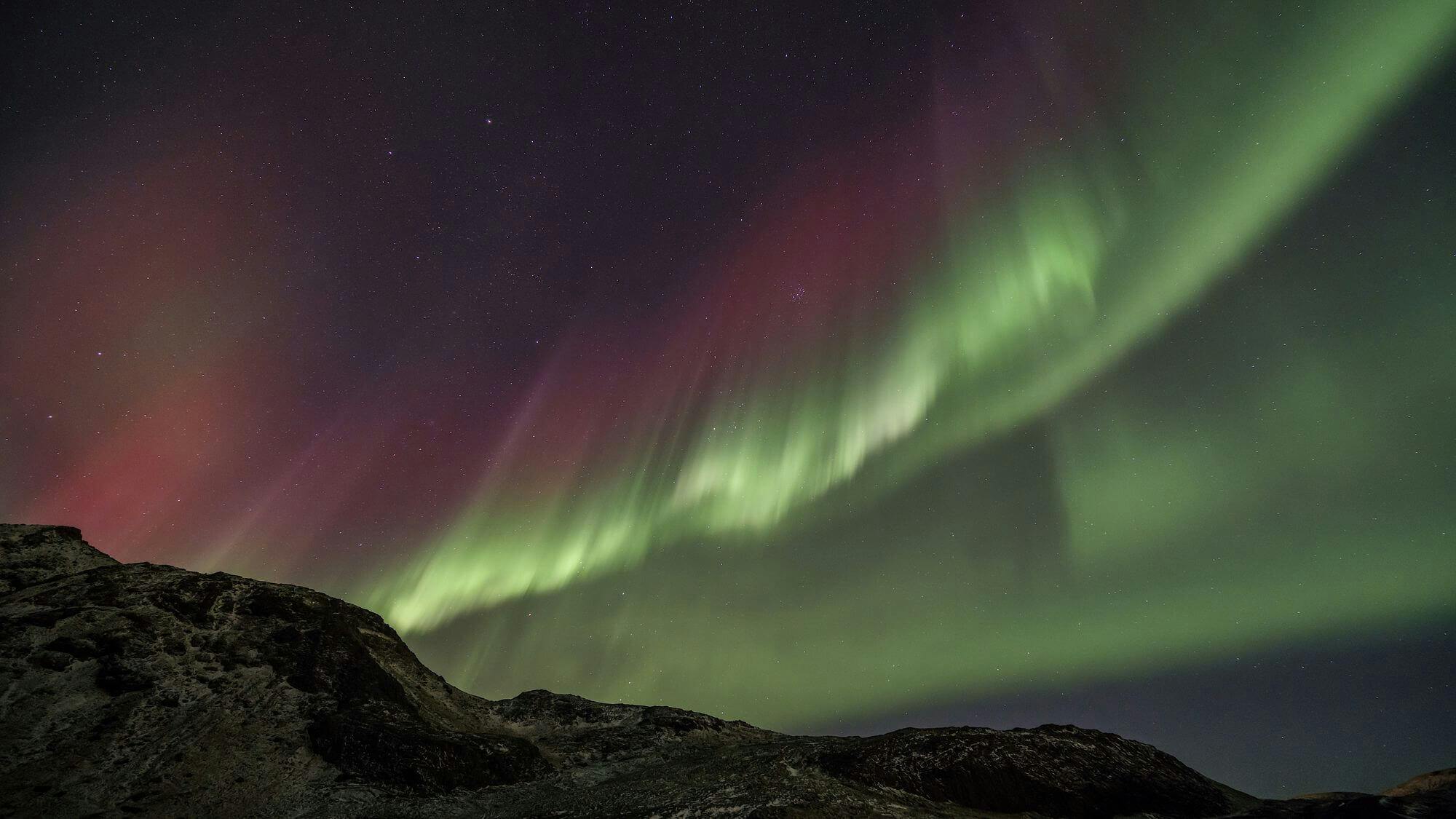
This is a great option for travellers that really want to see the northern lights without the hassle of renting a car, driving on icy winter roads and tracking down the lights themselves.
There are many different northern lights tours to choose from and it can be confusing. I found this one special tour that I always recommend to my friends visiting Iceland - it's this one here!
I’ve been on this tour a few times throughout the years myself. One of the things I love most about it is the fact that the tour consists of local experts that monitor the weather and decide on the best spot each particular night with the highest chance of seeing the lights.
They also have really awesome guides that provide hot chocolate, biscuits and blankets if you're cold!+ if you don’t see the lights you’re able to reschedule as many times as you’d like :)
Click here to read all about it and to secure your spots !
2. EXPLORE THE GLACIERS OF WINTER-WONDERLAND!
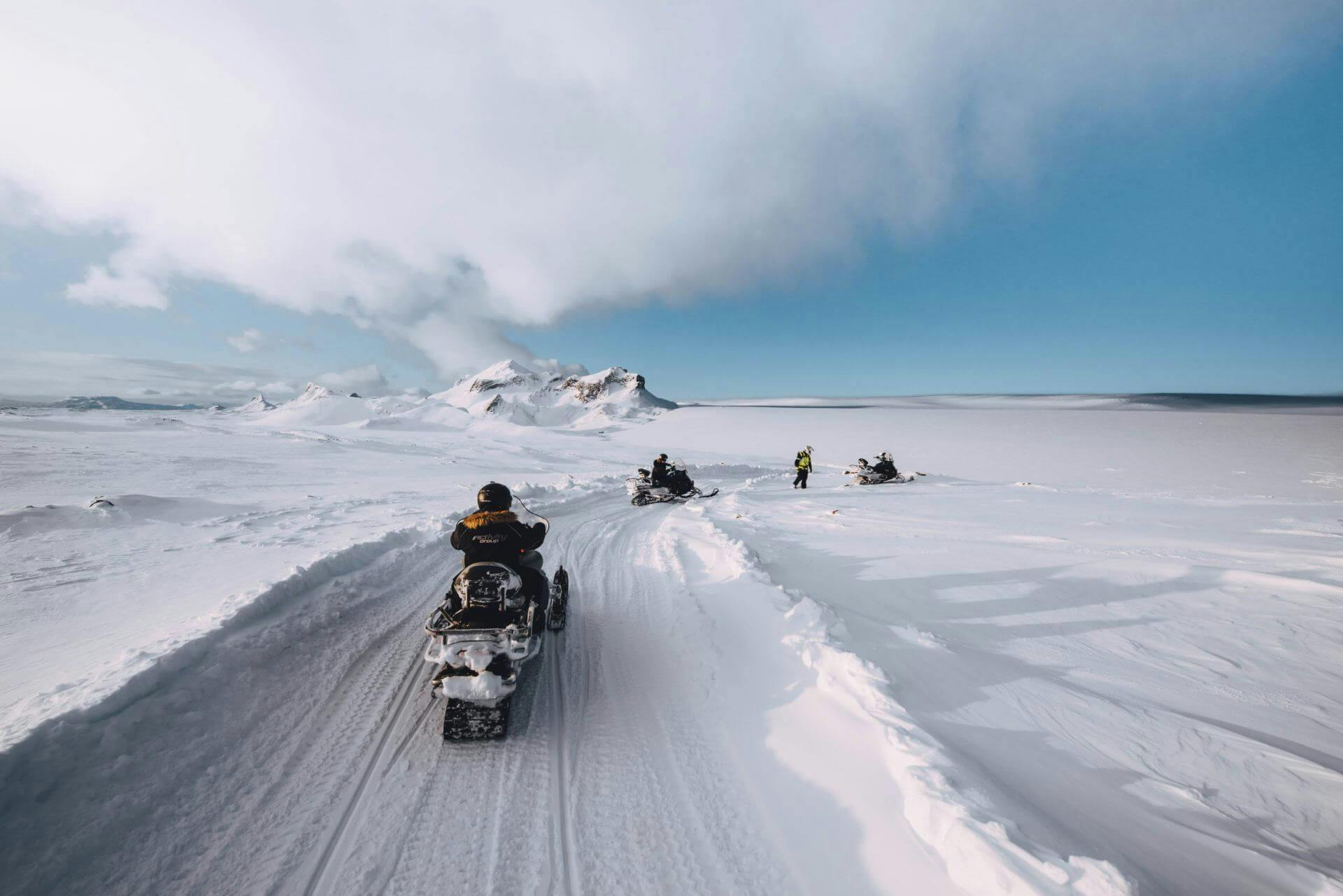
You’ll notice when you arrive to Reykjavik – we don’t have any glaciers here in the city.
However, if you’ve made your way all the way to Iceland – I believe it’s an absolute must to visit the glaciers! If you want to experience the awesome glaciers you have book a tour - this is for your own safety!
That way, you’ll have a professional guide that takes you to a safe area of the glacier (so you won't fall down a crevice!) – they will also provide the transfer to and from the glacier.
By the way, y ou’ll also see some cool sights along the way to the glacier!
There are many different ‘glacier’ tours to choose from which might leave you confused. My personal favorite is the Glacier Hike & Waterfall tour, since it combines hiking on the beautiful Sólheimajökull glacier but also visits the highlights sightseeing areas of the South Coast of Iceland.
I mean, who would not want to hike here?!
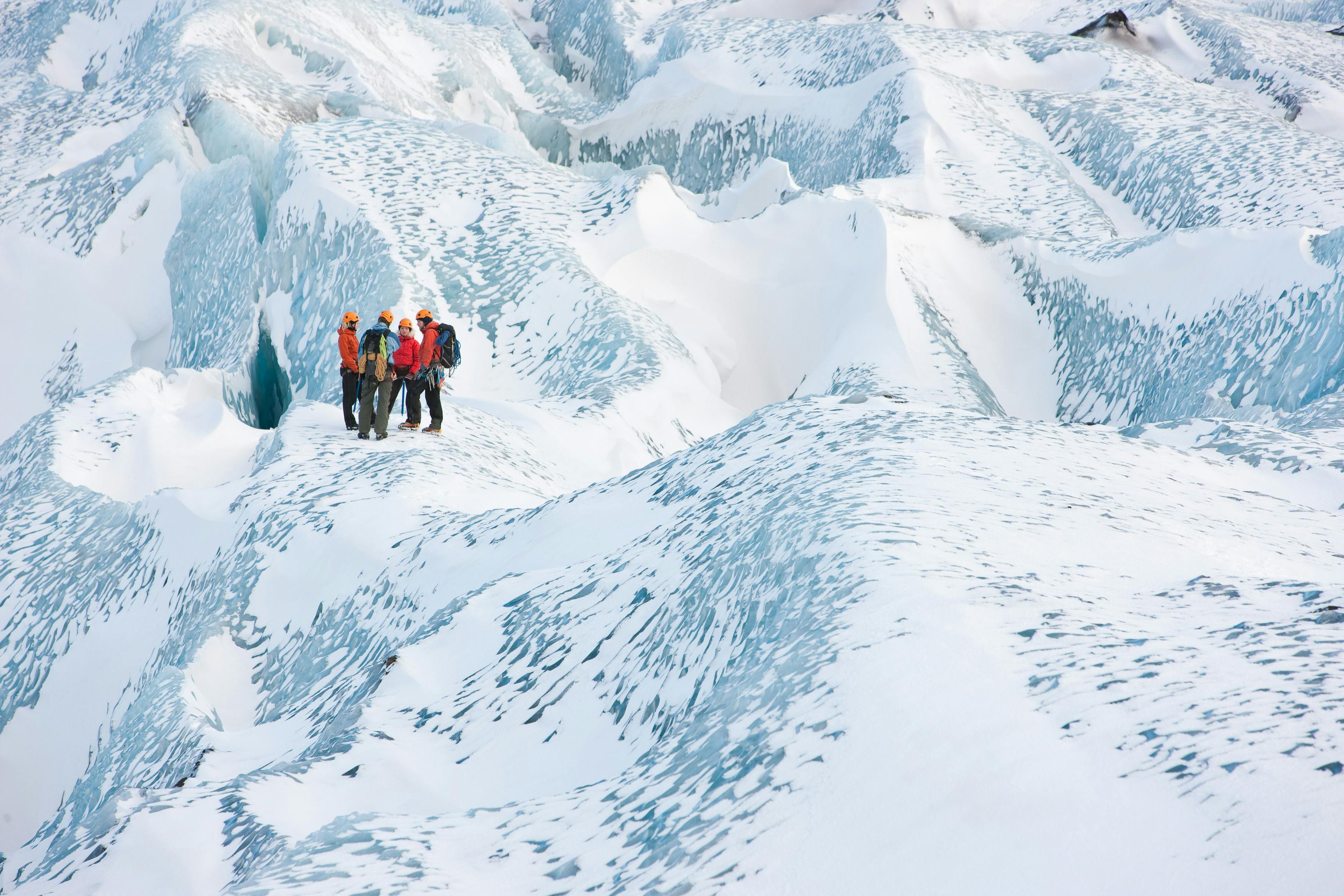
But... I also REALLY enjoy snowmobiling on glaciers.
I took my brother on the snowmobiling tour for his birthday last year – and it was a big hit! I also brought my go pro on that tour. Since they provide helmets with go-pro mounts, I got some really great footage!
For glacier snowmobiling, we have two options to choose from:
1) Golden Circle Sightseeing & Glacier Snowmobile combo tour.
2) Glacier Snowmobiling & Ice Cave tour (only available during the winter months)
After all of this activity and snow, you must be getting hungry. What to do?
3. EXPERIENCE THE BEST FOOD OF REYKJAVIK
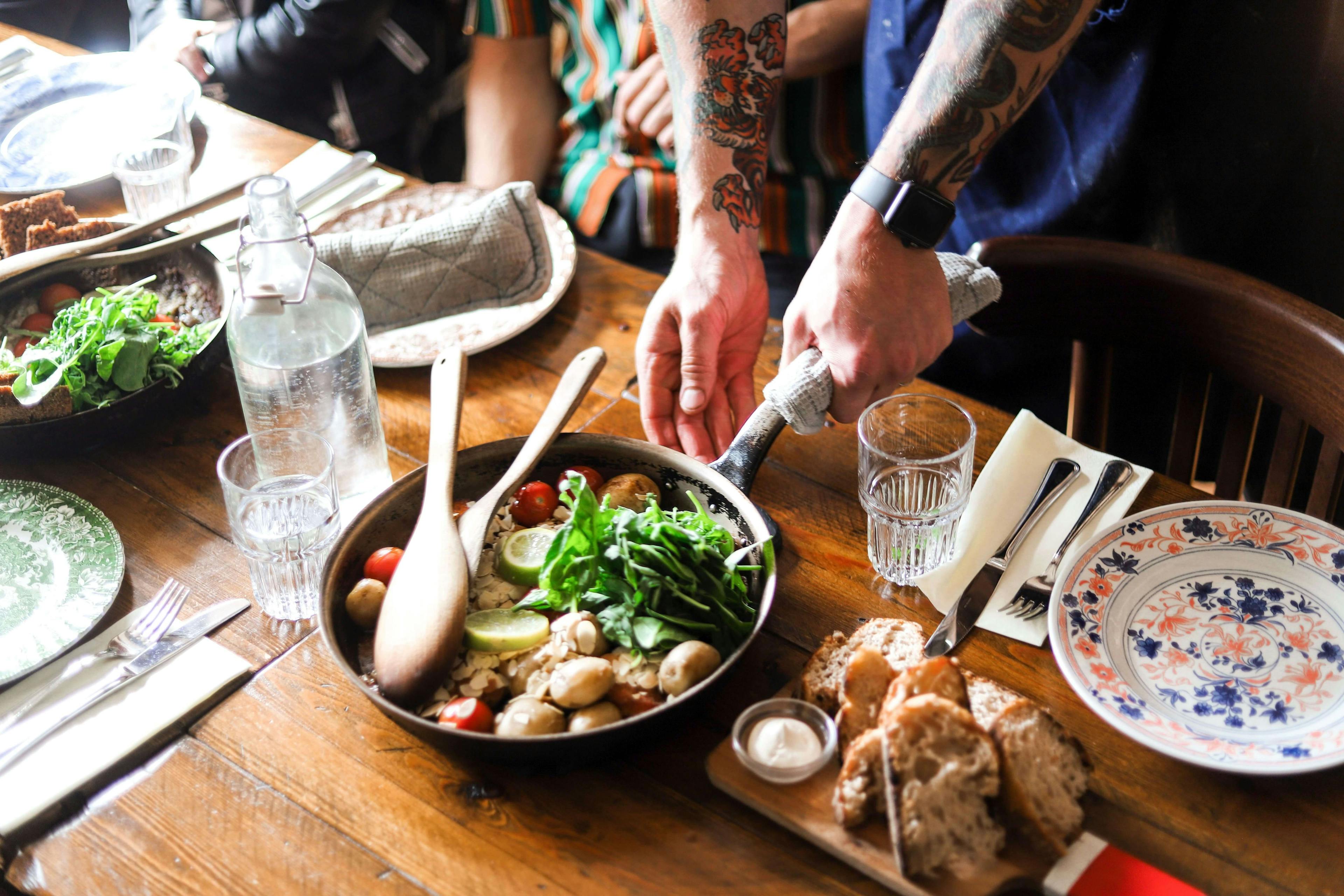
The food scene in Iceland is simply put, amazing .
I’ve been working in restaurants and involved in the food scene in Reykjavik for the past 10 years. During that time, I always had a dream of creating a really special food tour in Reykjavik.
A food tour that would show travellers the most amazing cuisine that Iceland has to offer, the best hidden local restaurants. Basically, a lot of food – and a lot of fun!
Finally, 6 years ago, that dream came true. Me and my friends here at Wake Up Reykjavik founded the Reykjavik Food Walk - a 3 hour walking food tour through the beautiful central Reykjavik area.
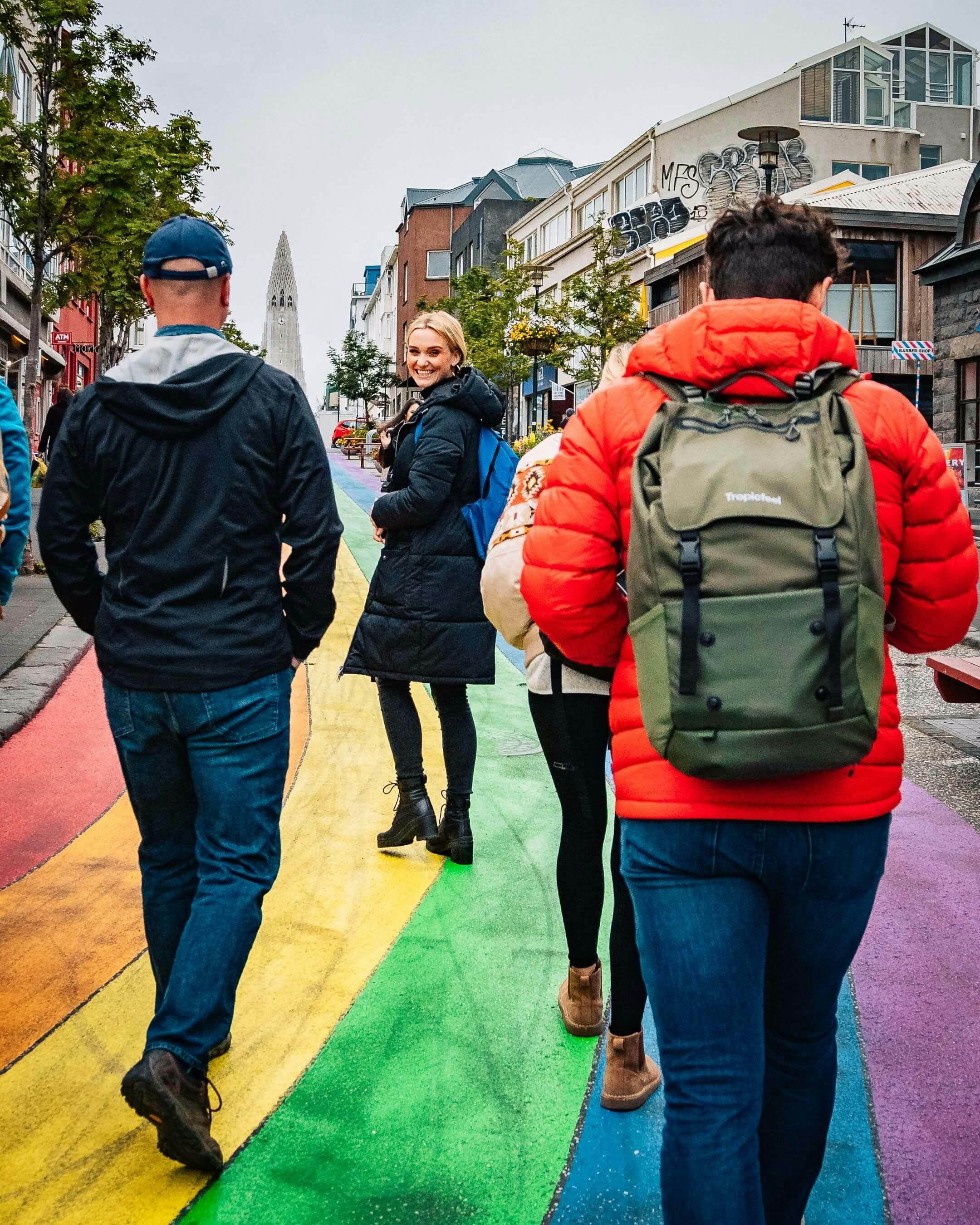
Today, the Food Walk it’s the #1 rated food tour in the world on Trip Advisor with 6000+ 5-star reviews.
If you get the chance – I highly recommend joining us on our delicious tour. If you like food, I have no doubt that you, your friends and family, would have a wonderful time!
You can find more info on tour here: The Reykjavík Food Tour !
Now we've taken care of the hunger. What about the cold?
4. ENJOY A WARM BATH IN THE COLD SNOWY WEATHER
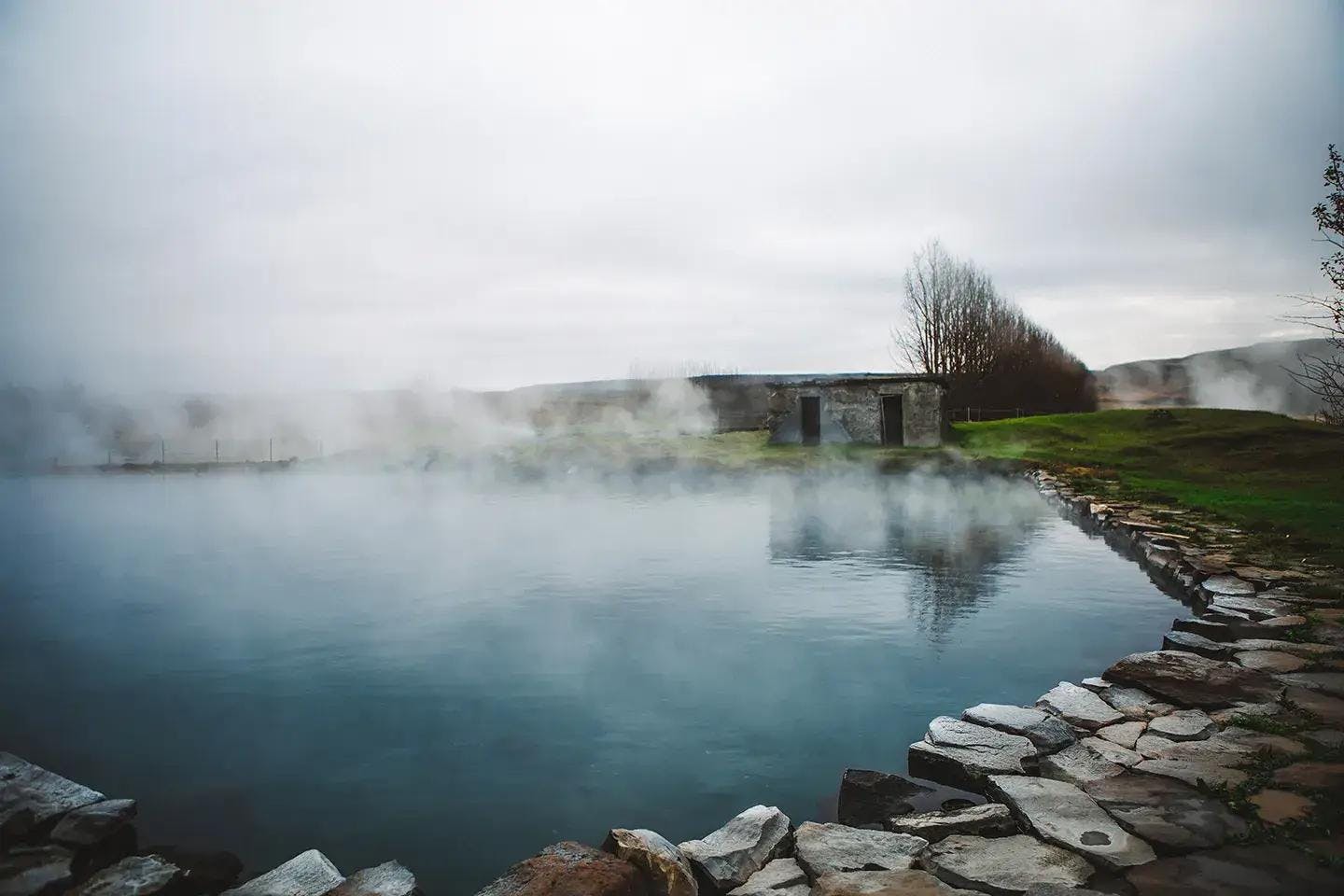
Hot springs:
Now you want to warm yourself in our naturally hot water. One option would be the hot springs, such as The Secret Lagoon (Gamla Laugin, which literally translates to the Old Pool) which is in the picture above.
For all my fellow natural hot spring seekers, I have written a specific guide to my absolute favorite hot springs in Iceland.
You can find it here :)
Swimming pools:
If the hot springs are not your scene then I would recommend checking out one (or more) of our local swimming pools. That is without a doubt the most local thing you can do here in Iceland.
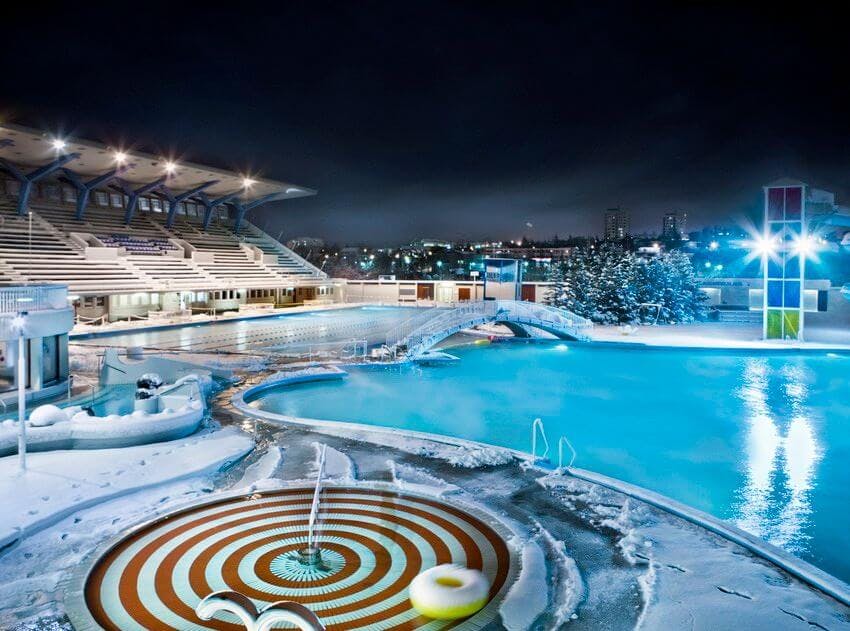
I often say that the English have their pubs, the Italians have their cafés, we have the swimming pools. People gather in the hot tubs and chat about everything and nothing with complete strangers. These swimming pools are situated are all around Iceland and I don't even have count for how many we have just in Reykjavík nowadays!
Personally, I visit the hot tubs and swimming pools here in Reykjavik 5 days a week. It’s simply awesome to relax in warm water while in the cold wintery weather.
My favorites swimming pools in the capital area are:
- Laugardalslaug (located in downtown Reykjavik)
- Árbæjarlaug (my neighborhood pool)
- Seltjarnarneslaug (located a few minutes driving from the downtown area)
Explore the Golden Circle and/or South Coast
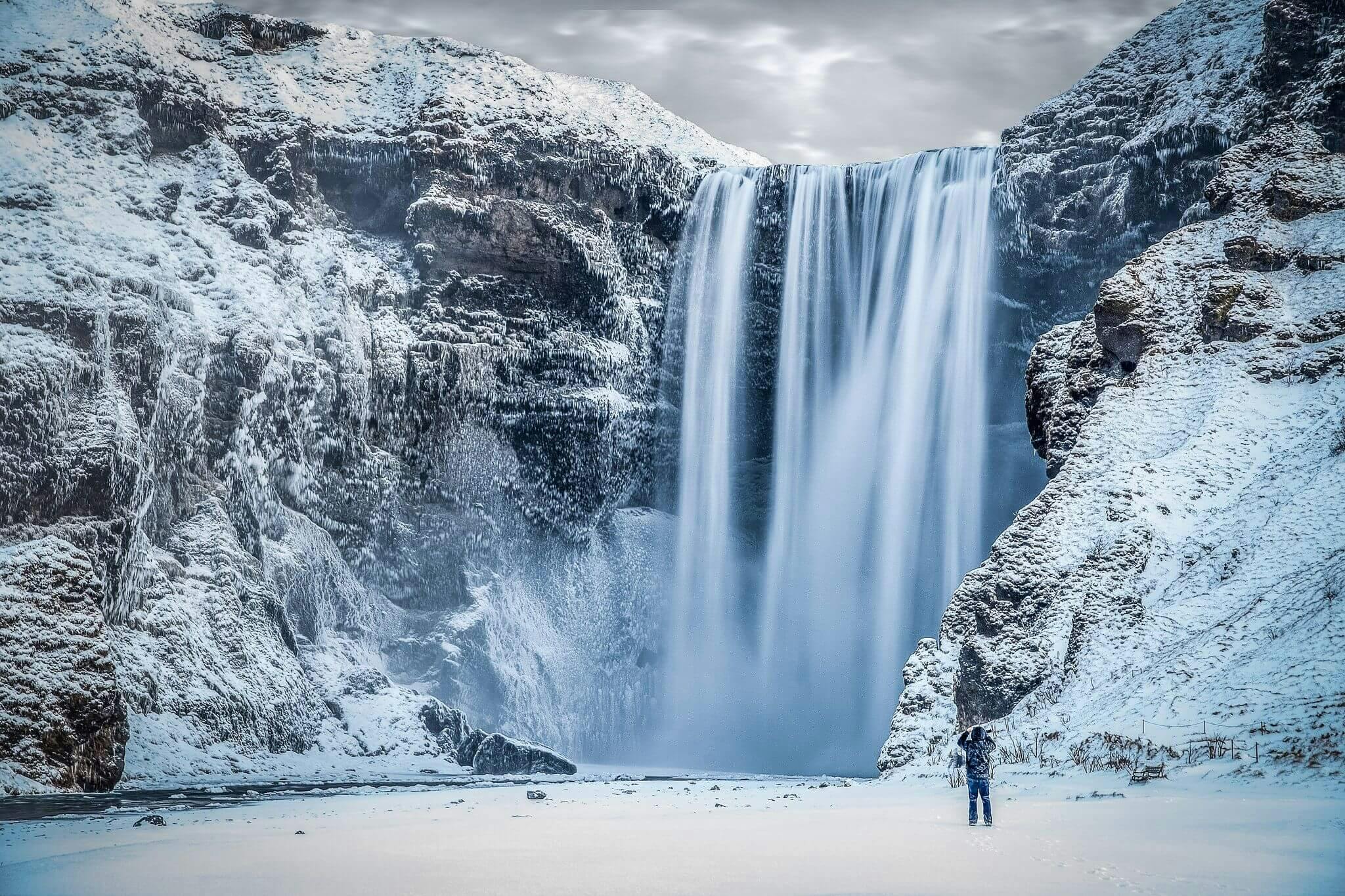
Skógafoss waterfall, South Coast.
Now, like I mentioned before January has some of the shortest days here in Iceland with a late sunrise and early sunset.
Which is why you'll have to time your sightseeing adventures carefully, since you don't want to arrive at an amazing waterfall during pitch black darkness.
That's why I wouldn't recommend any long, 14-16 hour sightseeing tours during January.
The South Coast & Golden Circle tours work really well in these 'short day' conditions.
The reason being that the tours depart early from Reykjavik (8:30-9:00am), while it's still dark out. The sightseeing spots are outside of the city.
So you'll simply be driving out of the city and towards that sightseeing spots during darkness, enjoying them in the daylight. And then driving back home once it starts to get dark again.
How perfect?
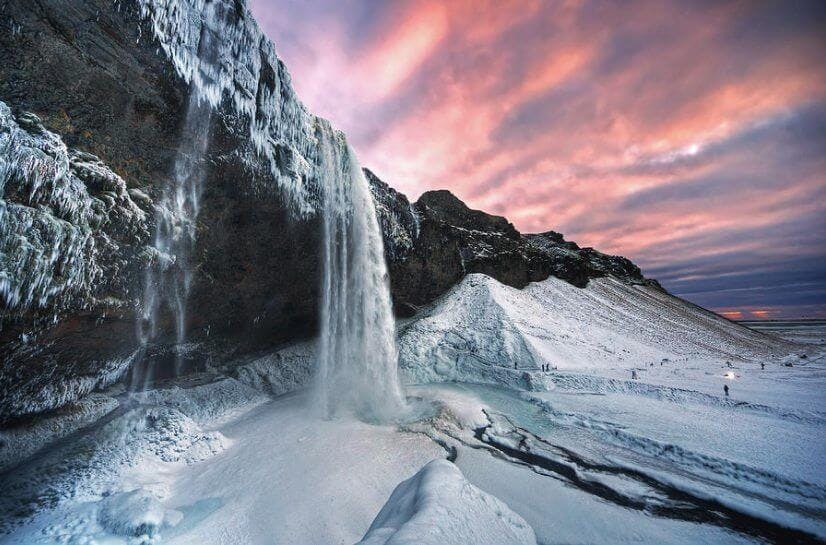
Seljalandsfoss waterfall, South Coast.
I think that's enough information for now. You should definitely find something awesome to do in January!
If you are still wondering what to do, feel free to drop us a line or view our full selection of activities here !
CAN YOU SEE THE NORTHERN LIGHTS IN ICELAND IN JANUARY?
Yes! January is one of the darkest months of the year with a very early sunset. Which makes January one of the best times of year to see the Northern Lights.
IS JANUARY A GOOD TIME TO GO TO ICELAND?
January is a fantastic time to visit Iceland. It is one of Iceland’s coldest months and usually the time of year were we experience the most amount of snow. But it also is one of the best months for northern lights.
January tends to be slightly less expensive then the summer high-season for accommodation, flights and sometimes even tours and activities.
HOW COLD IS IT IN ICELAND IN JANUARY?
The Average temperature in Reykjavik in January is -1 to +1°C (30-33 Fahrenheit). But the temperature can dance anywhere from -10 to +5°C. So, Iceland definitely isn’t as extremely cold as some might think!
IS THERE SNOW IN ICELAND IN JANUARY?
Yes. Although it can vary from year to year. January tends to have a bit of snow.
CAN YOU DRIVE IN ICELAND IN JANUARY?
Of course! Just be carfeul of the slippery roads and dark days!
WHAT TIME IS SUNSET IN ICELAND IN JANUARY?
January is known for having short days. The sunset in January is around 3:40pm during the beginning of the month. Towards the end of the month the sun sets at 5:00pm. But don’t let that stop you. It simply means that you could catch the earlier in the day.
TO SUM IT UP …
If you are crazy and adventurous enough to be thinking about visiting Iceland – and in January no less - go for it!
It’s a beautiful winter month unlike any other. You probably won’t find any destination more epic than this.
Snow, ice, warm soup and northern lights!
We are looking forward to seeing you!
Liked this article? Thank you so much! Feel free to connect with us in the comments & share it with your travel buddies!
- Klapparstígur 25, 101 Reykjavík
- [email protected]
- +354 45 40 222
- Our Awesome Blog
- Privacy Policy
Most popular
- Reykjavík Food Tour
- Northern Lights Tour
- South Coast Adventure Tour
- Golden Circle and Hot Springs
- Golden Circle and Snowmobiling Tour
We're socially active
When is the best time to visit Iceland in 2024?
Mar 7, 2024 • 5 min read

Summer is the best time to take an Iceland road trip © Klaus Vedfelt / Getty Images
There’s no such thing as the perfect time to visit Iceland as the weather is notoriously whimsical and the best season for your trip depends entirely on what you want to experience.
Mid-summer is glorious with eternal daylight courtesy of the midnight sun. This is the time for hiking, camping and exploring the wilderness, and when most services are open. The down side is many destinations will be packed with tourists.
We've got all the information you need about the highs and lows of different seasons. Whenever you choose to visit Iceland, pay attention to forecasts and road conditions and follow any safety advice issued by Icelandic authorities .
December to January is best for seeing the Northern Lights
Christmas lights brighten up the darkness and a festive spirit is in the air as the dark season nears its peak. Frost glitters and snow transforms landscapes into winter wonderlands. Christmas markets are held in Heiðmörk outside Reykjavík, in Hafnarfjörður and on Ingólfstorg square in Reykjavík, which has the added bonus of an ice rink. If conditions are right, the first ski resorts open up.
The sparse daylight means that you have a better chance of seeing the Northern Lights, especially outside populated areas where there is less light pollution (find a Northern Lights forecast here ). Joining tours is advisable. While it is possible to drive yourself, road conditions are often slippery and snowstorms are common.
Festivals worth checking out in winter include Dark Music Days and þorrablót mid-winter feasts, celebrated around the country. For the brave, restaurants often serve special þorri food.

February to March is the best time for snow sports and hot springs
It’s still dark and cold so communities brighten up the darkness with events like the Winter Lights Festival in Reykjavík and List í ljósi festival in Seyðisfjörður in the East. In narrow fjords in the Eastfjords and Westfjords, inhabitants celebrate the return of the sun with sólarkaffi and have pancakes. Snow sports become more enjoyable as daylight gradually returns.
Spring is an abstract concept in Iceland as the weather doesn’t always play along. It can still be cold and snowy, but the days get longer and the sun sometimes shines on skiers – this is often the best time for snow sports. The first of the migrant birds arrive and slowly but surely, nature springs back to life. Around Easter, events like Easter egg hunts are a fun family activity. In Ísafjörður, the Aldrei fór ég suður music festival is held and Ski Week is around the same time.

April to May is the best time for off-peak travel
While the weather is still unreliable, temperatures gradually rise. The first flowers blossom and trees bud. Migrant birds arrive in flocks and lambs and foals are born. Migrant whales have also returned and with better weather, whale watching is more enjoyable. The bird-watching season begins, although some areas may be closed due to nesting.
There are relatively few tourists around and if conditions are good, this can be a good time for a road trip . Look out for off-season discounts on accommodation and activities. However, not all tours and services have opened up yet.
The first Thursday after April 18th is the official First Day of Summer in Iceland, which is celebrated with parades and events around the country – even though the weather rarely plays along.
June to August is the best time for outdoor recreation
While there’s no good weather guarantee, this is your best chance of sun and warmish temperatures. Late June to early August is when most Icelanders go on vacation, filling up campgrounds wherever the best weather is forecast. This is the height of the tourist season – and height of the whale-watching season – so whatever you have planned, it’s best to book ahead.
Expect crowds at the most popular destinations, like on the South Coast and the Golden Circle . But as it’s bright all night, you can beat the crowds by traveling either super early or late. In July, Highland roads open up, but you'll need to book a tour or hire a 4WD vehicle equipped for F-roads and crossing rivers (if that’s your plan). Summer is the best season for hiking, biking and horseback riding. Around mid-August, wild berries ripen.
Summer is also festival season. Fishermen’s Day is a national celebration held in every seaside town on the first weekend of June. Around June 21, summer solstice is celebrated on Grímsey island, Iceland’s northernmost inhabited island. The Reykjavík Arts Festival is held every other year – the next one is on in June this year (2024).
Bræðslan music festival is held in Borgarfjörður eystri on the last weekend of July. Verslunarmannahelgi is a weekend in August that is packed with festivals and events, and Reykjavík Pride has various events held throughout the city, culminating in the Pride Parade.
Reykjavík Culture Night and the Reykjavík Marathon are held on the third weekend of August.

September to November is best for cultural events
Nights grow colder and camping is no longer advisable as fall rolls into winter. The weather is often good, though, so hiking can still be enjoyable. Pay attention to weather forecasts and bring warm clothing. Nature starts to change colors, painting forests and heather yellow, orange and red. Þingvellir National Park is at its most beautiful.
Road tripping is still possible and there will be fewer travelers around. However, winter is around the corner, so roads get slippery as soon as the temperatures drop and conditions can get stormy.
Réttir sheep and horse roundups are held in the countryside, and the Reykjavík International Film Festival takes place in the capital. In East Iceland, the Days of Darkness festival is held around Halloween and the Iceland Airwaves music festival is held in Reykjavík. Advent is approaching and Christmas preparations begin. This is a great time for visiting galleries and museums, going to concerts, relaxing in heated swimming pools, and feasting on good food.
This article was first published Feb 18, 2021 and updated Mar 7, 2024.
Explore related stories

Jan 2, 2023 • 12 min read
Want to start planning for the year ahead? Featuring sports events, natural phenomena and more, these are 20 amazing trips to consider taking in 2023.

Apr 6, 2024 • 3 min read

Mar 31, 2024 • 12 min read

Mar 31, 2024 • 6 min read

Mar 30, 2024 • 4 min read

Mar 28, 2024 • 17 min read

Mar 12, 2024 • 8 min read
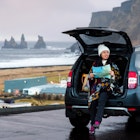
Mar 6, 2024 • 9 min read

Mar 4, 2024 • 10 min read

Feb 19, 2024 • 7 min read
Iceland is open for travel: check volcano updates here
- Language/Currency EN Language EN English CN Chinese $ USD ISK ISK $ USD € EUR CA$ CAD £ GBP

Iceland in January
The ultimate travel guide
- Top-Selling Tours
- IS IT WORTH GOING IN WINTER?
- THINGS TO DO IN JANUARY
- Can you see the Northern Lights?
- FESTIVALS & EVENTS
- WHAT TO SEE
- TOURS TO DO
- TEMPERATURES IN JANUARY
- DAYLIGHT IN JANUARY
- DRIVING IN JANUARY
- WHAT TO WEAR
- GOOD TO KNOW
Related Tours
Related blogs.

Are you looking for a Winter Wonderland to escape to? Look no further! The guide to Iceland in January is here! Everything from what to see and do to daylight hours, all in one place.
Although one of the quieter months, Iceland in January is a winter wonderland paradise. Snow covers the ground and as the days are shorter, expect the northern lights to be dancing in the sky.

Iceland nature in January
Frosty streets and fewer crowds mean that Iceland is yours to explore in January. A world away from what would greet you in the summer, if you think about visiting Iceland, January is a great option!
Top-Selling Tours in Iceland in January

Crystal Ice Cave Tour with Super Jeep Ride

"Into the Glacier" Ice Cave Tour

Northern Lights Super Jeep Tour
Is it worth going to iceland in winter.
If you're planning a trip during winter, you may wonder - is January a good month to visit Iceland? If you're looking for smaller crowds and great flight deals, January is a month to go. This period after the holidays is usually calmer with fewer tourists, so the prices also go down.
January is also the best time for winter activities. It is cold enough to enjoy glacier adventures and explore magical ice caves . It is also an excellent time to catch the mesmerizing northern lights in the night's sky.
THINGS TO DO IN ICELAND IN JANUARY
Horseback riding in iceland in january.

Horseback riding in Iceland in January
Want to add to unique experiences in Iceland, horseback riding on Icelandic horses in the middle of winter? No problem. This is a great way to take in the sights of mountains and landscapes in a very authentic way. Plus it's winter, so these adorable horses are all the more fluffy! In the coldness of the weather, this is one activity sure to melt your heart.
Ready to experience something new and exciting? Check out these Horseback Riding tours !
Snowmobiling in Iceland in January

Snowmobiling in Iceland during winter
Being a year-round activity, it is always an option for whenever you travel. However, will your winter wonderland adventure be complete if you don't go snowmobiling in the crisp January snow? I don't think so! Being the first person to drive over fresh snow is a thrilling feeling you won't want to miss out.
Most of our tours depart from Reykjavik , so getting to the destination is made a lot easier for you. Langjökull glacier is a favorite to drive across and the miles of snowy mountain views will blow you away.
Explore Icelandic nature with these Snowmobiling tours !
Explore Reykjavik Nightlife

Reykjavik's Nightlife
Of course, you should make sure you get all the sights and experiences on your holiday. But what are holidays for, chilling out and relaxing. Reykjavik is home to some amazing bars and pubs. The English pub is a place to go if you want a shot of winning free beer (which we all know is beyond expensive in Iceland). Spin the roulette wheel and be in the chance of winning 2, 3, or even more pints of beer.
There is a huge range of places to go in downtown Reykjavik. Whether you want to enjoy a quiet drink or a lively night out, this is a part of Icelandic culture that you do not want to miss out on.
Snorkeling in Iceland in January

Snorkeling in Iceland at Silfra Fissure
Snorkeling? In January? In Iceland? In freezing glacier water? The temperature remains at a constant temperature of 2-4° throughout the year, so it doesn't matter when you choose to go, it's going to be cold. But, the power of modern drysuit equipment has come to save you. Only your hands and face will get wet, and you'll be so mesmerized by what you're looking at you won't even notice.
I can tell you from personal experience that it is one of the most amazing experiences I've ever had. The visibility in the water is crazy! Looking 100 meters down, knowing that you are in the crack of a tectonic plate is just unreal. The experience doesn't end there, as when you return to the surface, snow-capped mountains and glistening ice sculptures surround you. It doesn't sound so crazy anymore, does it?
Check out these Snorkeling tours to have one of the most unforgettable experiences in your lifetime!
If you want to make a full day out of visiting Silfra Fissure, consider booking a combo tour. Our Black & Blue tour combines snorkeling with a visit to underground caves.
Can you see the Northern Lights in Iceland in January?

Bright Northern Lights in Iceland
Those short days that we spoke about earlier are why you're going to be glad you visited in January. The increased amount of darkness makes it easier to see the colorful marvel in the sky. In some cases, the Northern Lights can be seen from Reykjavik when the sky is clear, but in most cases, you need to travel to a place with low light pollution. The further into nature you get, the better the chance of seeing dancing lights.
As previously mentioned, there are different ways to watch the Northern Lights. Boats are a great way to sail into the ocean and engross yourself in the dark waters to be greeted by a stunning spectacle. Jeeps and minibusses are another great way as it means you can reach terrain that may not be accessible in a regular car.
FESTIVALS & EVENTS IN ICELAND IN JANUARY
New year’s eve.

New Year's Eve in Iceland
Yes, New Year's Eve starts in December, but a minute later, and it's January. Explosive bursts of light fill the sky above Reykjavik. With no planning or harmonization, Icelanders light fireworks from all parts of the city, so expect your senses to be tantalized. Colors fill your eyes, the smell of fireworks waft in the air, and adrenaline and excitement flow through your body—what a great way to start your year!
Reykjavik International Games

If you're a big sports fan, this event is perfect for you. Some of the best athletes that Iceland has to offer! Everyone has something, from dancing, skiing, figure skating to martial arts and fencing. Attending Reykjavik International Games is an exciting way to spend your day watching the impressive sports people of Iceland.
Dark Music Days Festival

Dark Days Music Festival in Reykjavik, Iceland
In the beautiful architecture of the Harpa , the Dark Days Music Festival is hosted by the Icelandic Composers Society to showcase up-and-coming new artists, both national and international.
Þrettándinn

Þrettándinn is the perfect way to end the festive Christmas season. January 6th is the thirteenth day of Christmas in Iceland. Towns roar with bonfires and firework displays. The famous 'Yule Lads' leave the town and head back to the mountains to hide away for another year. One last celebration and a great way to submerge yourself in another culture at Christmas time.
WHAT TO SEE IN ICELAND IN JANUARY
Ice caves in iceland in january.

Ice Cave tour in Iceland
If you come to Iceland during winter, you are in for a treat! Your adventurous streak will not be disappointed with the beautiful glaciers Iceland has to offer. The low temperatures ensure that the structure of the caves is kept in good shape for you to go inside. Europe's largest ice cap, named Vatnajökull , is a fantastic spot to hike, tour, and explore. Mýrdalsjökull is an ice cave under a volcano known to be very blue. You'll thank me that you packed your camera for this one.
Here is everything you need to know about Iceland's ice caves and more!
Golden Circle in Iceland in January

Golden Circle's sightseeing place in January
Getting to see the Golden Circle in the winter is entirely different than the summer. Seeing a 32-meter high waterfall frozen over is one of the best things to do in Iceland in January! Witnessing a national park covered in snow is fantastic! Snorkeling between tectonic plates, I'm not sure what more you could personally ask for on a winter adventure.
Reykjavik in January
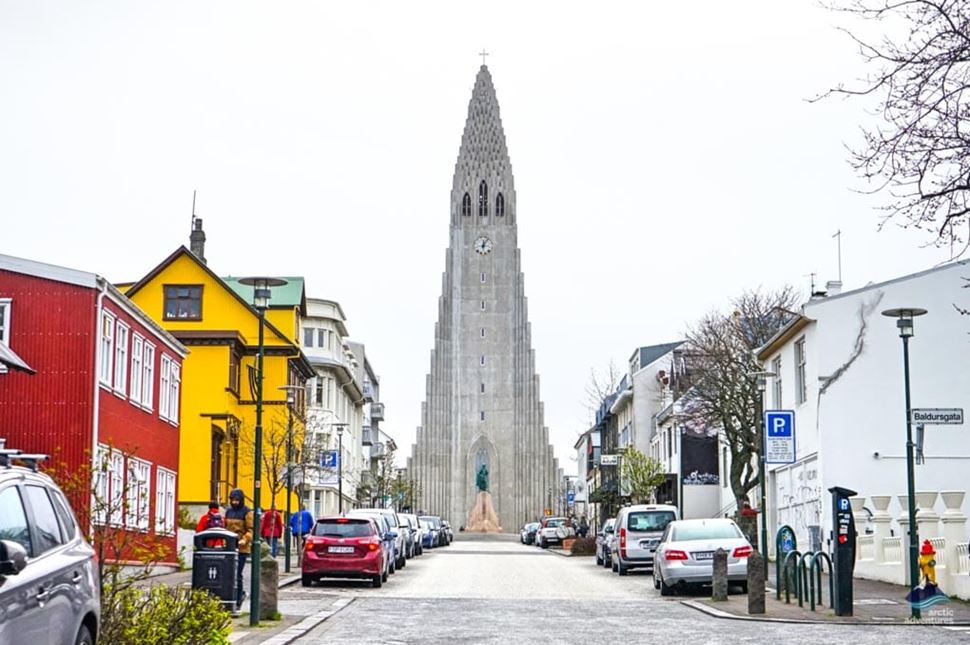
Hallgrimskirkja's church in Reykjavik
Taking the time to stroll around the capital city on a quiet month, with sparkling frost covering all corners of the town, is breathtaking. The frozen pond, the glowing lights from shops, and the smell of fresh food from restaurants and bakeries is excellent way to end your holiday. After an action-packed holiday, finding a cozy place to have a hot chocolate and get your last glimpses of Reykjavik is the perfect chance to unwind.
TOURS TO DO IN ICELAND IN JANUARY
Of course, all the activities in 'Things to do and see' are available on tours. It is well worth booking tours for many reasons, and some have already been spoken about. Due to the weather, special equipment may be required, and the guides are ready with everything you need. It is the safest option, so if you want your time in Iceland to be as stress-free as possible, then this is the best option.
Northern Lights Tour in Iceland in January

Everyone wants to see this natural phenomenon when they come to Iceland. Booking onto a tour is a much easier way to successfully see the northern lights than wandering around aimlessly on your own, not knowing what to look for. The only thing you need to decide is how to see them. Boat? Super jeep?
Want to experience Icelandic winter in full? Check out these Northern Lights tours !
Glacier Tours in Iceland

Glacier in Iceland
Glaciers, volcanoes, and waterfalls all in one trip? These glacier tours are the best ways to ensure that you see some of the most insane natural sights in one go. Feeling on top of the world standing on a glacier or feeling tiny hidden in a crevasse, either one with leave you in admiration of what our wonderful planet has to offer.
Diamond Beach in Iceland in January

The Black Sand Diamond Beach in Iceland
You can keep thinking that Iceland can't get any better, but it can. A tour to the south coast is an absolute must! A black sand beach with dazzling ice diamonds! It's okay, and I know that thought must be overwhelming. But then imagine this Diamond Beach filled with snow because it is January. The advantage of going in this month is that the ice is there to stay, bigger and more beautiful than it would be in the summer.
TEMPERATURES IN ICELAND IN JANUARY
As you would expect, Iceland's weather in January is cold. The average temperature in Reykjavik in January is between 1°C and -1°C (between 30°F and 33°F). The coldest temperature ever recorded in Reykjavik was -10°C (14°F). I think it's safe to say that no one wants this to be on holiday in Iceland when the weather decides it wants to beat its record.

Enjoying sunlight in cold frosty day in Iceland
Dig out your waterproof clothes as January is a wet month. Whether that means snow, sleet, hail, or rain, expect it all. Another thing to be aware of is the wind. At least one time, you will likely become highly windswept. Probably without warning. Just make sure you’re wearing a hat so no one can see the state it left your hair in. On a serious note, check the weather for any storms as it may limit what tours or activities you can do. Trying to drive around the Ring Road in wind and ice will not be the highlight of your holiday.
As much as you can hope and pray for good weather, you’re in Iceland, and in Iceland, the weather can’t make up its mind. So pack for every occasion. Check out for more information about the Iceland weather .
DAYLIGHT IN ICELAND IN JANUARY
There isn't much sunlight in January, which may seem like the downfall of traveling at this time of the year. But, it does mean more time to chase the Northern Lights.

Harpa Concert Hall in Reykjavik, Iceland
On January 1st in 2018, there were only 4 hours and 20 minutes of daylight. With the sun rising at 11:21 and setting again at 15:41. However, by the end of the month, there was a total of 6 hours and 53 minutes of sunlight. It was rising slightly earlier at 10:15 and setting at 17:08. So if you want more daylight to explore but still want to visit in winter, then plan your travels later on in the month.
In the north of the country in Akureyri , for example, the sunlight hours are even more limited. The sun rises at 11:32 and sets at 15:00. So make sure you get all your exploring done in these times.
DRIVING IN ICELAND IN JANUARY

Driving in Iceland during winter
Without a lot of experience driving in icy, snowy unpredictable weather or a four-wheel drive, you have my permission to skip this section. It's honestly for your safety. If you meet these criteria and want to hire a car, then do your research on the best cars and the best equipment to get with the cars. This may have to be requested ahead of time, so make sure everything you need is available.
Another thing to consider is the closure of roads this month. Floods, snow, and other things can cause the closing of a road. You don't want to be the tourists that have to come and get rescued because you didn't listen to the safety warnings, so make sure you're well aware of the journey ahead of you. Besides the stress of having to be rescued, there may also be towing fees or fines, and these are just additional factors to make your time in Iceland less enjoyable (stick to the tours if you ask me).
WHAT TO WEAR IN ICELAND IN JANUARY

Couple hiking by the glacier in Iceland
If you're one for reading blogs and have read a few at this point, you will already know what this section will say. You need to layer! It is the only way to stay cozy on the long days ahead of you. In your suitcase should be the following:
- Thermal underwear
- Waterproof Overalls
- Fleeces and jumpers (as many as your luggage allowance will allow you)
- Thick socks
- Hat, scarves, and gloves
- Walking boots – make sure you break these in before your first hike
- Swimming costume or trunks (these are a must if you want to swim in any of the natural geothermal pools)
GOOD TO KNOW BEFORE VISITING ICELAND IN JANUARY

Couple planning a journey to Iceland
- Make sure to plan ahead – as already mentioned, the weather is not predictable, and the window of daylight is small, so make sure you are well organized and always have a plan B.
- Understand the dangers of driving – if you're not an experienced driver in harsh weather conditions, don't make Iceland your first attempt. It's more than likely to end badly, and Iceland is full of professional guides to drive you around.
- Book all your tours in advance – spaces fill up very quickly, and you will miss out on seeing the most incredible sights.
- Bring a camera – don't follow in my footsteps and move to Iceland, forgetting her camera. Photo's don't do any justice to nature here anyway, but even less so on your phone camera. Trust me on this one!
So there it is, everything you need to know about Iceland in January.
Know anyone traveling to Iceland in January? Share this blog with them!
Popular tours

Your Ultimate Guide to Iceland in July

Guide To Westman Islands: Iceland's Explosive Pearl

What to Wear Snorkeling

What to Wear in Iceland

Puffins in Iceland - Everything You Need to Know

Icelandic food

Glacier Experience - Sólheimajökull Easy Glacier Hike

Magical Auroras - Northern Lights Tour

What to Do on New Year in Iceland 2024
Guide to traditional new year’s eve in iceland: where to go & what to see.
Wondering how Iceland will celebrate New Year's Eve in 2024? In this guide, uncover the unique traditions, experience the local festivities, and pinpoint the top places to welcome the new year.

Iceland Winter Weekend Itinerary
Northern lights, crystal ice cave and more.
Wondering how to spend a weekend in Iceland during the winter? If you're traveling for a short time, you'd likely want to organize and preplan to make the most out of your trip. Here, you'll find some ideas for spending a memorable weekend ...
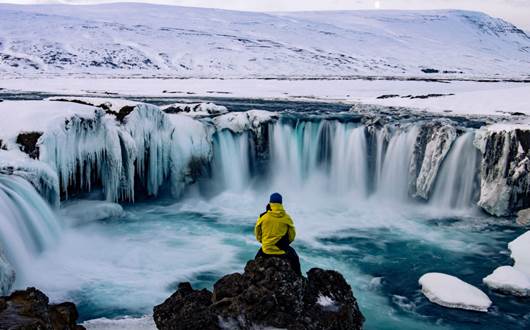
10 Things to Do in Iceland in Winter
Learn about the best activities in iceland during winter.
Many visitors to Iceland opt for a winter holiday when the nights, snow and ice are at their most captivating. Here’s a quick guide to the best things to do in Iceland in winter time.
Share our passion for Iceland, get top travel stories & special offers to your inbox
Iceland in January – Attractions, Things to Do, Travel Tips and More
- Last Updated: May 14, 2024
- Norbert Zohó
A trip to Iceland promises to be amazing at any time of the year, but there’s something extra special about the winter months. Snow and ice blanket the landscapes, the spectacular Northern Lights dance in the skies, and the cold temperatures make it a great time for cozying up in front of roaring log fires after days of exciting explorations.
Visiting Iceland in January provides a terrific way to experience the best of Icelandic winter without the crowds and revelry of Christmas and New Year. The country quietens again, leaving travelers free to explore the winter wonderland in relative tranquility.
January is one of the county’s quietest months for tourism. It is also one of the coldest and darkest months in Iceland. You can expect just a few hours of sunlight each day, along with icy roads and landscapes covered in thick snow. Far from being something to deter you, these factors help make Iceland so amazing during January!
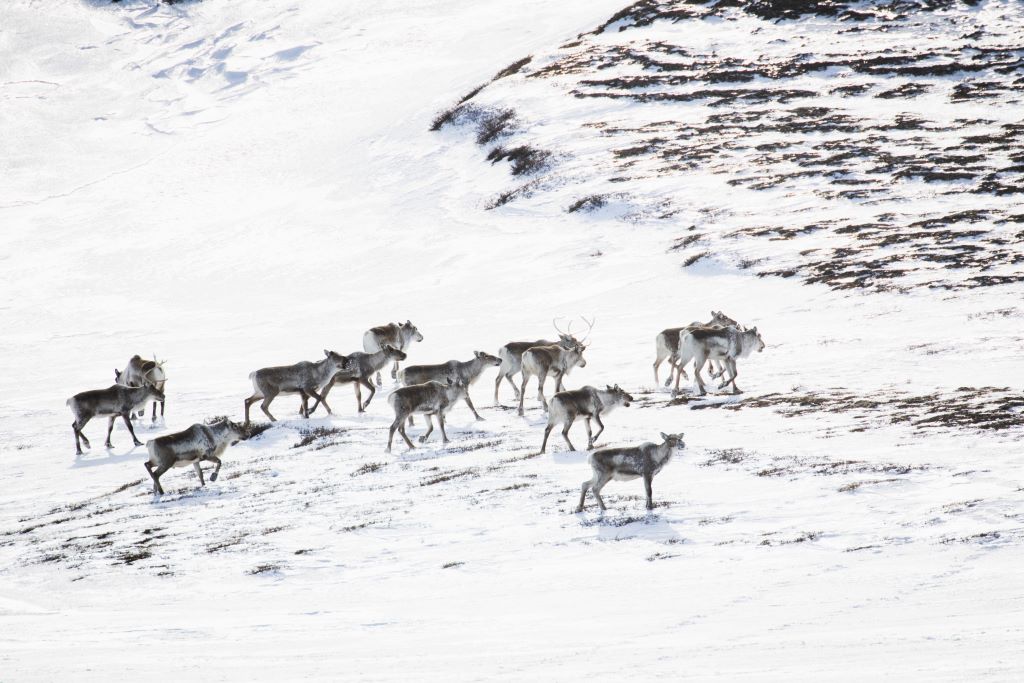
The Weather and Road Conditions in Iceland in January
Travelling by car, day tours from reykjavík, experiencing the northern lights, snowmobile tours, glacier tours, skiing and snowboarding, ice cave tours, whale watching, horseback riding, diving and snorkeling in silfra, soaking in the blue lagoon or other geothermal pools, exploring reykjavík, visiting the golden circle, visiting the snaefellsnes peninsula, exploring iceland’s south cast, what to wear in iceland in january, new year’s eve, þrettándinn – january 6, þorrablót (late january to mid-february), reykjavík international games , myrkir músíkdagar (dark music days).
Although Iceland typically experiences cold winters with plenty of snow and ice, the temperatures don’t drop as low as many people expect. Average lows are just below the freezing point. Strong winds, however, can make it seem much colder than it actually is. And, January is the country’s windiest month of the year.
In the capital of Reykjavik, temperatures commonly range from -10°C to 3°C (21.2–37.4°F). As well as snow there may be rain and sleet. Storms are fairly common too.
In the north of the country, snow is all but certain. Places at higher altitudes also have lots of snow throughout January. Elsewhere around the country, though, rainfall is the norm. Dressing appropriately for the conditions is essential.
Because of Iceland’s northern latitude, there are very few hours of daylight during January. The exact amount of daylight depends, however, on the location around the island. In Reykjavik, early January usually has around four to six hours of daylight, increasing to almost seven hours near the end of the month. There are places that only see two hours of sunlight on a typical January day, while some destinations remain dark throughout the day with the sun hidden behind towering mountains.
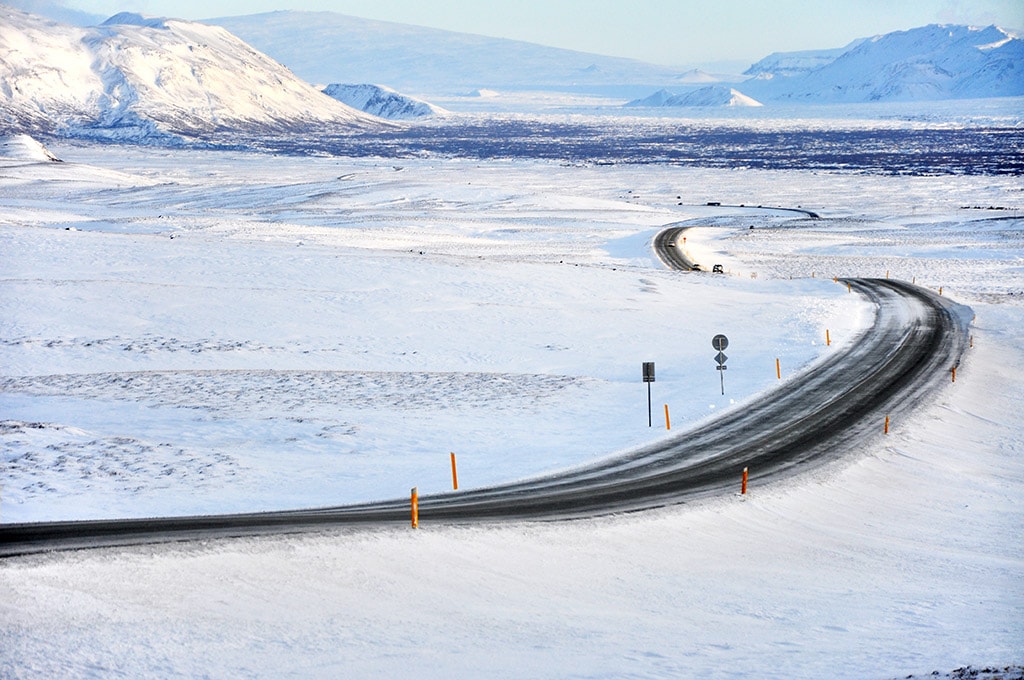
How to Travel Around in Iceland in January
When starting to plan your January trip to Iceland, it’s important to think about how you will travel between different places. Organized tours and self-drive tours with rental vehicles are the two most popular means of traveling around Iceland. Renting a car with a private driver is also possible and popular.
Although public transportation connects with Iceland’s major cities and towns, there are no services to many of the popular natural attractions. Furthermore, there are often only one or two long-distance bus services each day. Using public transport to sightsee in Iceland really isn’t feasible.
Rental cars are perfect for those who want to explore Iceland independently at their own pace and on their own schedule. There are several rental agencies in both of Iceland’s main airports as well as in the center of Reykjavik.
As winter driving can be challenging in Reykjavik, you should only consider renting a car if you have plenty of previous experience driving in icy and snowy conditions. Your vacation isn’t the time to try and learn new skills!
Four-wheel drives are highly recommended for driving in January. Although cars don’t come with chains, you can ask for studded tires; most rental companies can provide these, but you may need to request them a few days in advance.
You should also learn a bit about the driving etiquette in Iceland before beginning your trip. You might be surprised to discover local driving habits vary according to the diverse landscapes.
Check the road and weather conditions each day prior to setting out on your journey. The Iceland SafeTravel website is an excellent resource. Bad weather might make you rethink your day’s plans, and certain roads may be closed because of floods, avalanches, fallen trees, and similar.
If a road is closed, don’t try to attempt to drive it anyway—it’s closed for a very good reason! Attempting to drive along closed roads could put you in danger and result in your needing to be rescued, which is also hazardous for the rescuers. Your insurance won’t cover the substantial towing fees and you could also receive a hefty fine.
If you want to travel around Iceland independently but without the hassle of making all the necessary arrangements, a self-drive package could be perfect. All essential bookings, such as rental car and accommodations, are taken care of for you, leaving you to drive yourself from place to place and spend your daytimes as you like. Read our article on Iceland planning tips to help you choose which option you would prefer.
You could also consider renting a car with a driver. This gives you the independence of going where you want to and when you want to, but with an experienced local driver being the wheel. What you forego in privacy could be well worth it for the convenience and safety aspects.

Lots of tourists choose to maintain a base in Reykjavik and enjoy a variety of day trips from the capital to explore nearby areas. You can reach most of Iceland’s popular hotspots on day trips, although southern and western Iceland are the most accessible and offer some of the best sights.
Day tours can be a terrific option for travelers who want the comfort and convenience of exploring Iceland without the hassle of driving themselves, and who also enjoy returning to the same familiar accommodation to relax and rest each night after a fun-filled day out.
Top Things to See and Do in Iceland in January
Although Iceland is cold, dark, and snowy throughout January, the country still offers a plethora of exciting things to do and see. Plenty of tours still operate in January. Indeed, some tours are best in the winter, for example, observing the Northern Lights and exploring an ice cave.
Aim to maximize your experiences during the hours of daylight and you’ll find plenty of amazing things to enjoy in January. Plus, there are plentiful ways to have fun in the darker hours too.
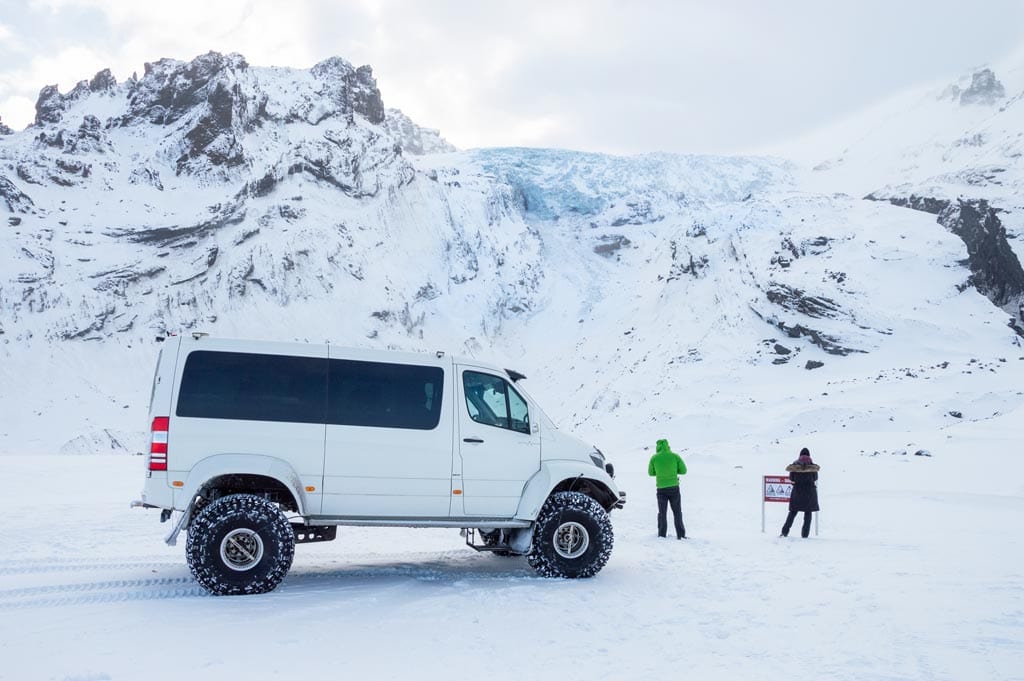
Anyone traveling to Iceland between September and April has a good chance of spotting the awe-inspiring Northern Lights. January, with its fewer hours of daylight and longer hours of darkness, is a particularly good month for those wanting to go aurora hunting.
Although you can often spot the lights from the capital, try to get away from the light pollution of the city for the best chances of admiring the magical phenomenon. There are much better views when you see the lights in total darkness. Thingvellir National Park is a great place close to the city to watch the natural light show.
A number of operators run Northern Lights tours too, using both buses and super jeeps. Bus tours are usually cheaper, whereas tours by jeep can go deeper into the countryside. Northern Lights cruises offer a more unusual way to enjoy the lights, with cruises available from Reykjavik and Akureyri. It’s really very magical seeing the lights both in the skies above you and reflected on the shimmering waters beneath you.
If you have a rental car, you can also drive into the countryside yourself to try and spot the lights. Make sure that the aurora forecast has a rating of 3 or higher and that there isn’t too much cloud cover.
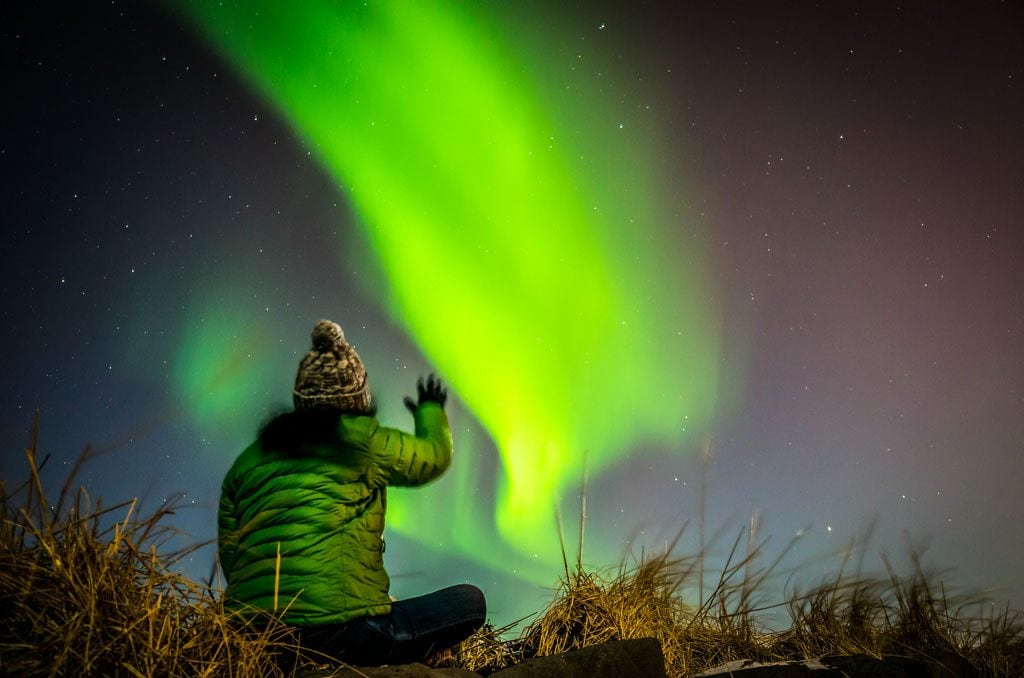
With a dense cover of fresh gleaming snow, January is a terrific time for having fun on a snowmobile. Although snowmobile tours are available all year round, there’s nothing quite like experiencing the gorgeous fresh powder of January. Explore stunning terrain and experience a thrilling tour through a winter wonderland.
Many snowmobiling experiences are located at Langjokull, the nearest glacier to the capital.
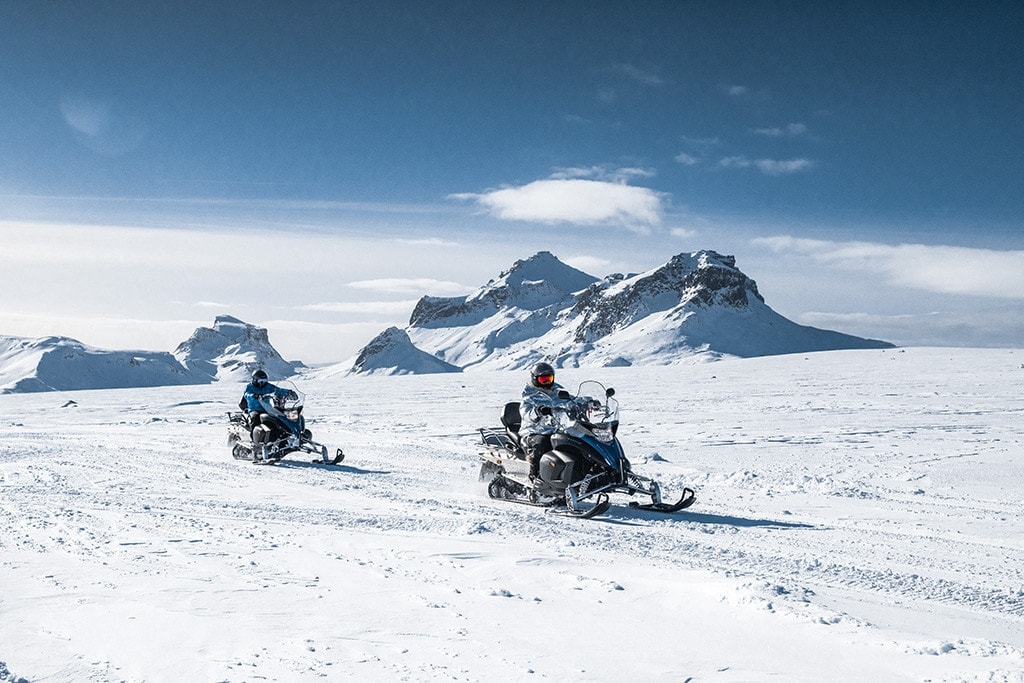
While many glaciers are open for excellent year-round hiking, the fresh ice in electric blue hues adds an ethereal appeal to the glaciers in January.
With tours operating every day and located just a few hours outside of the capital, Solheimajokull is a top place for glacial hiking. Situated along Iceland’s south coast, it’s one of the easiest glaciers to access and to hike when staying in Reykjavik.
If you’re in the southeast of Iceland, other terrific tour options include visiting Svinafellsjokull from Skaftafell Nature Reserve and hiking the outlet glacier of Breidamerkurjokull at the mighty Vatnajokull glacier.
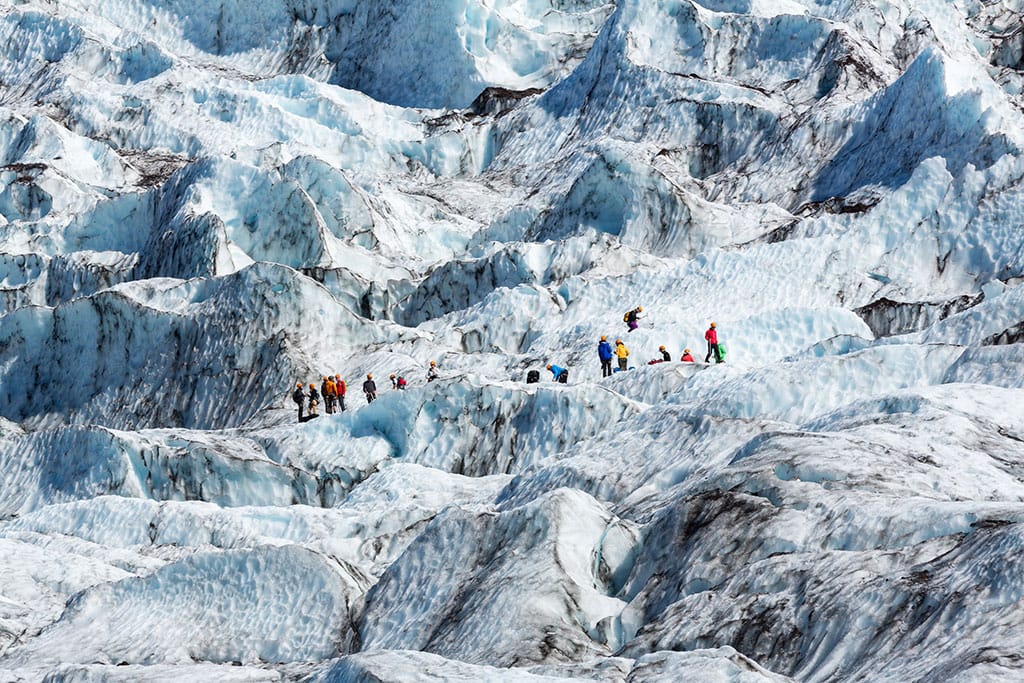
Avid fans of snowsports seeking a lesser-enjoyed European destination will be pleased by Iceland’s skiing and snowboarding opportunities. Less popular and not as well-known as other places around Europe, Iceland’s ski resorts aren’t as crowded and the smaller resorts offer a more intimate atmosphere. Plus, there are next to no trees to accidentally run into!
You’ll find terrific downhill skiing and snowboarding opportunities, as well as amazing cross-country and backcountry skiing. Go to the top of mountains by snowcat, ski down to the ocean, and enjoy thrilling heli-skiing. No matter your level of experience, you’ll generally find that resorts cater to both advanced skiers and learners.
The Icelandic ski season runs from the middle of November to May, although many resorts don’t open until December and are closed again by April. Most resorts have lighting on the pistes to allow for nighttime skiing.
Bláfjöll ski resort, in the west of Iceland, is the country’s biggest resort. You’ll also find Skálafell ski resort in western Iceland. In the Westfjords, Dalirnir near Ísafjörður is a great choice. If you’re traveling in eastern Iceland, Stafdalur and Oddsskarð offer awesome skiing and snowboarding, while in the northwest you’ll find Tindastóll, located close to Sauðárkrókur.
Overall, northeast Iceland is the best place to stay if you are mainly interested in skiing and snowboarding. Akureyri is a great base with plenty of local amenities and within easy access of several ski resorts. Hlíðarfjall is the most popular ski resort in Iceland and also offers the highest slopes.
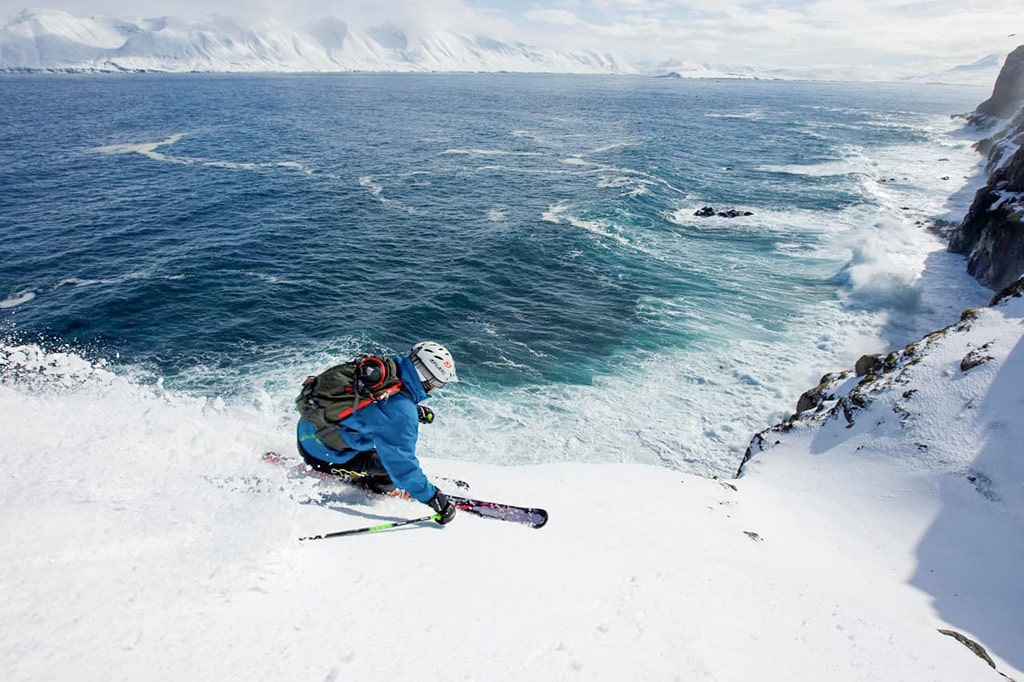
January falls right in the middle of Iceland’s ice-cave season, which runs from the middle of October until March. The low winter temperatures maintain the caves’ structure, making them accessible until the warmer weather comes to melt the ice and they flood.
Because of ongoing glacial movement, the ice caves change each year. This means that even if you’ve already been ice-caving in Iceland, you’ll find something new in the following years.
There are several stunning ice caves around Iceland, with those underneath the Vatnajokull glacier especially recommended.
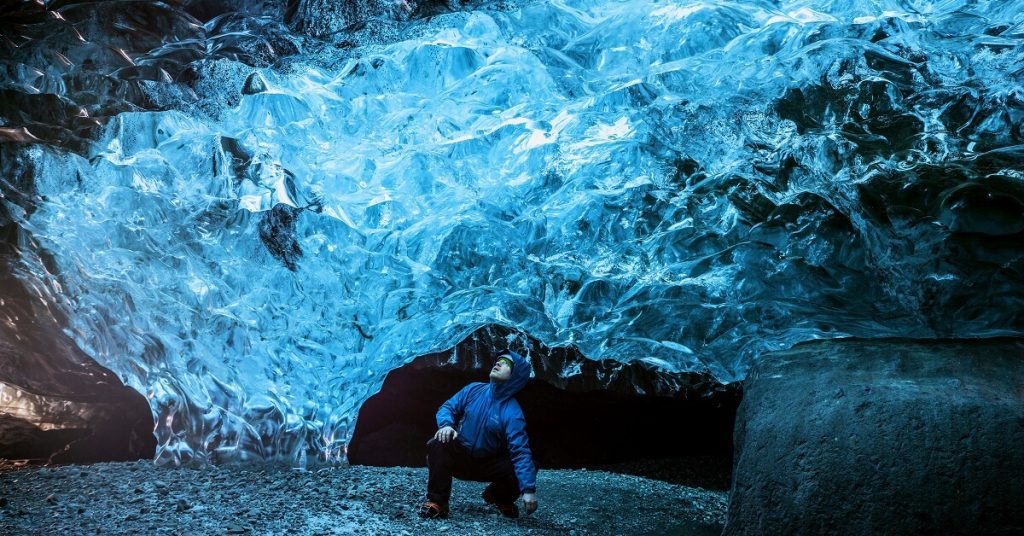
Iceland’s amazing wildlife-spotting opportunities draw many visitors every year. Renowned for being the best place in Europe for whale watching, tourists are often excited at the prospects of glimpsing the more than 20 species that live in the waters around Iceland.
While the warmer summer months are the best time to see species like minke whales, fin whales and humpback whales, as well as seabirds, dolphins and porpoises, winter is the best time for anyone wanting to catch sight of magnificent Grundarfjördur orcas, AKA killer whales. It is also possible to see a range of other species over the winter.
You might have luck on your side and see a whale (or other marine animals) from dry land, but the prime viewing opportunities are on a boat trip.
There are two main departure points for whale-spotting tours: Reykjavik and northern Iceland’s town of Husavik. Both offer excellent chances of spotting whales in their natural habitat, and the latter has earned the nickname of the whale-watching capital of Europe.
That said, during the winter Reykjavik departures offer more convenience. Plus, many operators cease operations over the winter in Husavik.
In the capital, the majority of whale-watching trips leave from the Old Harbour. You can book at one of the kiosks or arrange a tour in advance. Trips typically last for between two and four hours.
Also in Reykjavik, the Whales of Iceland exhibition offers even more fascinating insights into Icelandic aquatic life. You can enjoy an interesting immersive experience, see more than 20 life-sized models of whales that have been found in the waters around Iceland, and learn more about majestic whales. The exhibition is conveniently located close to the harbor, perfect for a visit either before or after a boat trip.
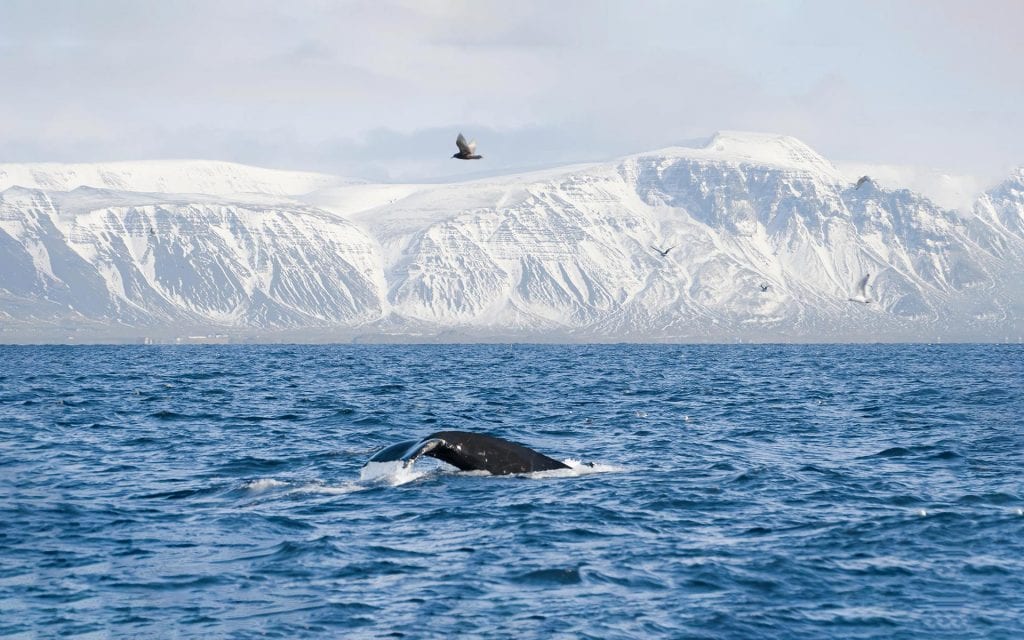
Horseback riding is possible all year round and is a popular adventure with both locals and tourists alike. As well as exploring gorgeous wintry landscapes you can get to know more about the native Icelandic horse.
Famous for its relatively small stature, the Icelandic horse is also known for its inquisitive and curious nature and higher-than-average intelligence. It’s a popular equine for dressage and other events due to having five gaits (many other breeds just have three or four).
Horseback adventures can be arranged in Reykjavik, and it’s common to combine horse riding with other cool activities, such as whale-watching, quad-biking, caving and Golden Circle tours.
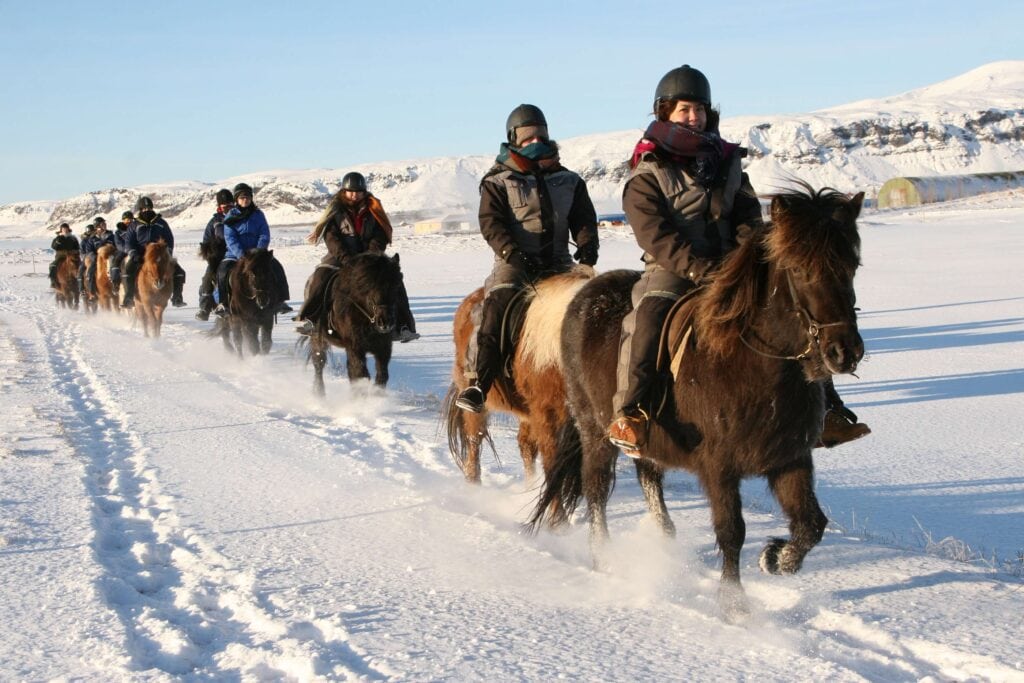
You may be dubious about taking to the water for a spot of snorkeling or diving in January, but with good-quality dry suits, it’s a thrilling experience.
Most diving and snorkeling tours take place at Silfra in Thingvellir National Park. The natural spring is located in a gaping fissure between two tectonic plates. Surrounded by marvelous natural formations, the water here never freezes over.
Having been filtered through porous lava rocks over several years, the water is exceptionally clear. Indeed, you can expect to be able to see for more than 100 meters (328 feet).
The unique location combined with amazing visibility and incredible underwater scenes make this one of the top ten diving sites across the globe.
Amazing at all times of the year, in January the chasm is fringed with snow and stunning natural ice sculptures, adding to the dramatic beauty. It’s a particularly great spot for fans of underwater photography.
You can arrange winter diving and snorkeling trips from Reykjavik, and it’s possible to combine the magical experience with other terrific activities, such as caving and exploring natural gems around the famous Golden Circle.
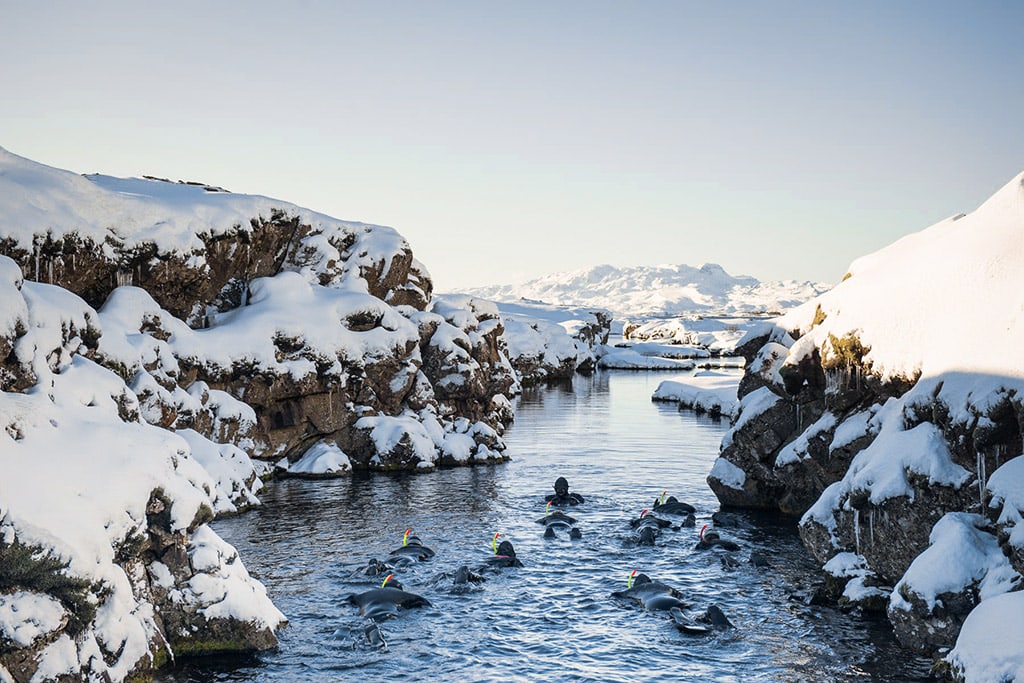
When the weather is cold, one of the most amazing things to do in Iceland is to don your bathing suit and take a dip in one of the many geothermal pools. Heated naturally, many complexes feature both indoor and outdoor pools.
There are geothermal pools all around the country, meaning you’ll never have to look too far to take a relaxing soak in nature.
Loved by locals and visitors alike, there’s something special about bathing in delightfully warm waters while feasting your eyes on frosty surroundings.
The Blue Lagoon is one of Iceland’s most famous hot pools, easily located between the capital and main international airport, though you’ll also find plenty of public pools around the nation.
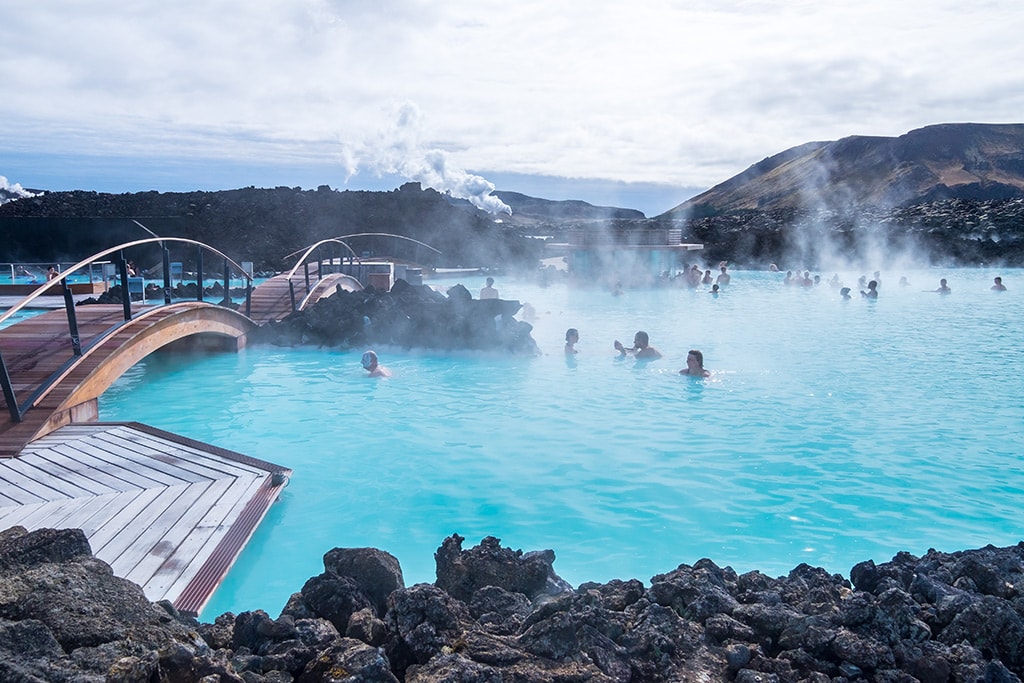
The capital city of Icelandic and the country’s cultural heart, Reykjavik boasts a wealth of fascinating museums, pretty parks, stunning art, and interesting cultural hotspots. Most attractions are open all throughout the year, offering a great way to spend time inside and escape inclement weather while learning more about the nation’s history and traditions.
Common themes include local history, art, folklore, and maritime heritage, as well as beautifully preserved historic buildings.
The city center is easy to explore by foot, with many of the main attractions within close walking distance. You can also get around by rented car and public transport.
Top attractions in Reykjavik to add to your bucket list include the National Museum of Iceland, Perlan Museum, Arbaer Open Air Museum, Hallgrímskirkja Church, Saga Museum, the Maritime Museum, Harpa, the Settlement Museum, Reykjavik Family Park, Reykjavik Art Museum, and Whales of Iceland.
Although most attractions are open during the winter, operating hours may be reduced; check opening times in advance to avoid disappointment.
Wander through the streets and spot a striking array of street art and enjoy a wide assortment of shops, bars, cafes and restaurants.
Foodies should definitely consider taking a food tour while in the capital. Of course, you should try the famous national dish of hákarl (fermented shark). There are plenty more delicacies to tempt you too, including succulent lamb, fresh seafood, flatbreads, and geothermally grown vegetables, to name just a few. The yearly Food and Fun Festival is also held over the winter. Lasting for a week, it’s the biggest food festival in Iceland.
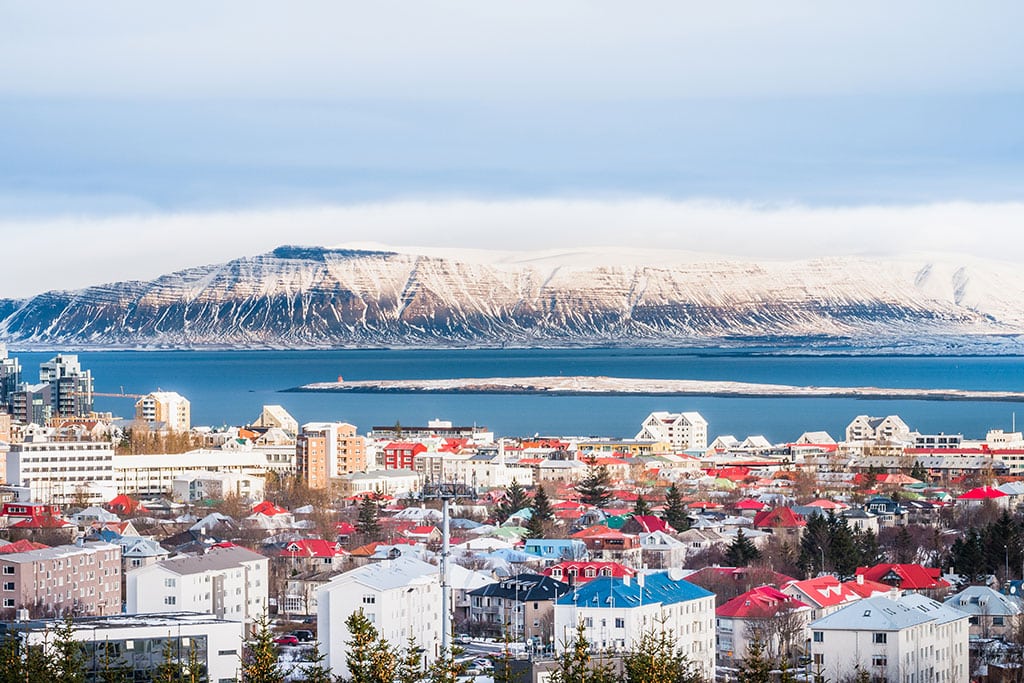
The iconic Golden Circle is home to some of Iceland’s most famous natural attractions. It’s a must-visit when in Iceland, with the landscapes even more beautiful during the winter when covered with ice and snow.
Thingvellir National Park is often the first stop from the capital. Brimming with interesting geological formations and scenic landscapes, it is also home to the Silfra Fissure—the rift between the Eurasian and North American tectonic plates. And, if that wasn’t enough, it was also steeped in history, being the site where one of the world’s longest-running parliaments was formed back in 930 AD.
Stop at the Haukadalur Valley to explore the marvels of the Geysir Geothermal Area. Wafts of steam and bubbling water break up the snowy ground, and the earth has striking bold hues. Gaze in awe as the mighty Strokkur Geysir sends a powerful jet of hot water into the air; eruptions are regular, occurring around every five to ten minutes.
See the beautiful Gullfoss Waterfall, where water cascades over two levels to enter a rugged scenic gorge. In January, the surrounding rocks are clad in ice, creating an even more otherworldly vision.

Nicknamed “Iceland in Miniature” thanks to its varied landscapes and striking natural features, the Snaefellsnes Peninsula is an amazing place to visit at any time of year.
Stretching for around 90km (56 miles) along the coast, the peninsula offers plenty to see and do, including the well-known Mount Kirkjufell, which is featured in the popular series Game of Thrones. Shaped somewhat like an arrow, the unusual mountain is around a five-minute drive from Grundarfjordur village.
Another top spot is the Snaefellsjokull glacier and volcano, which is featured in the Jules Verne novel, “Journey to the Centre of the Earth”. Elsewhere around the peninsula, the fishing villages at Arnarstapi, Stykkisholmur, and Hellnar are well worth visiting, as well as the seal colony at Ytri Tunga, Budahraun lava fields, the beach at Djupalonssandur, and Londrangar basalt towers.

Traveling around the south coast between Reykjavik and Jökulsárlón Glacier Lagoon is another stunning tourist route.
In the southeast part of the country, you’ll find several awe-inspiring waterfalls, dazzling glaciers, brooding black sand beaches, and a gigantic stretch of lava field. Don’t miss the shimmering lagoon dotted with small icebergs too.
Most major attractions along the South Coast can be visited all throughout the year, but may be temporarily closed during the winter due to floods, road closures, bad weather, etc.
Without stopping, it takes around four and a half hours to drive from the capital city to the lagoon. They are some 372km (230 miles) apart, connected by Route 1. There are many cool places to visit along the way, including Eyjafjallajökull volcano (famous for its flight-stopping eruption in 2010), Vatnajökull National Park, the waterfalls of Seljalandsfoss and Skógafoss, the charming village of Vik, and the black sand beach at Reynishverfi.
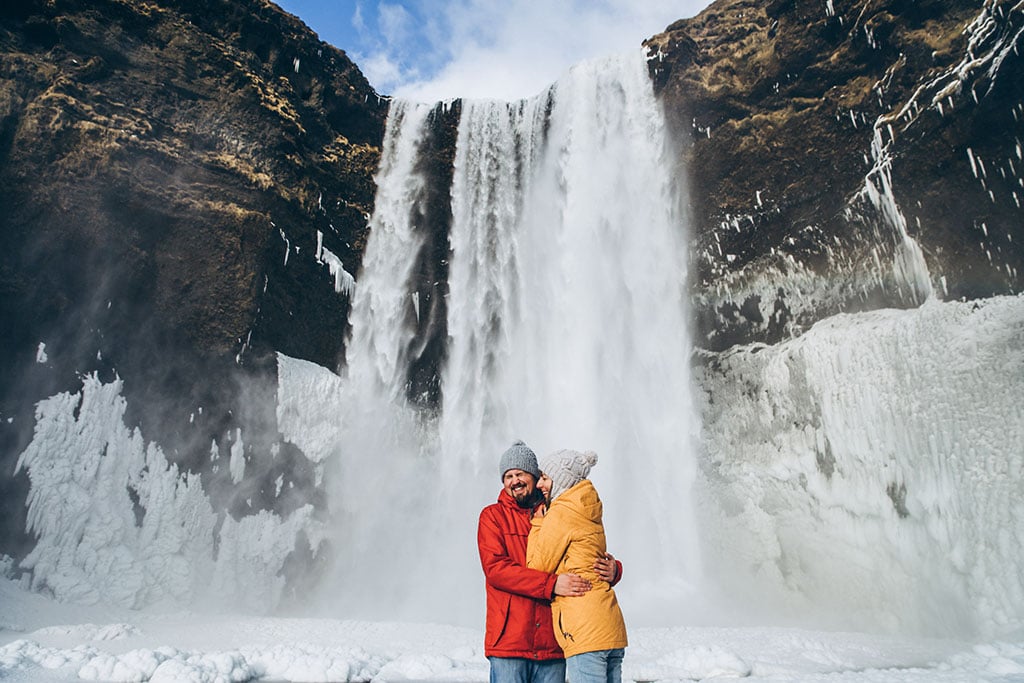
Plenty of warm layers are essential for visiting Iceland in January. Plan your packing list accordingly!
Pack for cold weather, while keeping in mind that conditions can vary a fair amount during the winter months and between different locations around Iceland.
Be sure to pack extra warm clothing if you plan to do outdoor activities, such as ice caving, hiking or hunting for the Aurora Borealis. Crampons can come in very handy when walking through ice caves or along icy paths and streets.
It’s somewhat easier to pack for a city break, as you can always pop into cafes, shops and restaurants to escape the chill outside.
This is what we recommend packing for your January trip in Iceland:
- Warm winter pants
- Warm winter jacket
- Warm sweater (though you can always purchase one locally too)
- Waterproof hiking footwear
- Bathing suit and towel
- Camera

Events in January
Iceland hosts many events all year round in various places around the nation. Although the summertime typically offers more in the way of festivals and events, there are still a few exciting cultural events to add to your calendar for a January trip.
Heralding the start of a brand new year, celebrations for New Year’s Eve take place on 31st December. The country is alight with amazing firework displays, with locals putting on their own explosive shows.
Head to Hallgrimskirkja to be wowed by the colorful skies and vibrant patterns. The most active celebrations are held in Reykjavik.
Prettándinn signals the end of Iceland’s Christmas season. Celebrated on the 6th of January, it is referred to as the 13th day of Christmas. The 13 Yule Lads pack up and leave the city and there are many bonfires and fireworks.
There are also strong folkloric and spiritual elements to celebrations too, with local beliefs that, on this day, the lines are blurred between the physical and supernatural worlds. There are tales of animals being able to speak and of dreams foretelling the future.
The midwinter festival of Thorrablot can trace its roots back to the times of the Vikings. The date changes each year, but it always falls somewhere in the old Norse month of Thorri (from late January to the middle of February).
It’s a time when locals enjoy an abundance of traditional fare, including fermented shark, lamb heads, and the unusual delicacy of pickled ram’s gonads!
If you love sports you should try and time your Iceland trip to coincide with the Reykjavik International Games. Held in the city’s Laugardalur Park, the large event contains a variety of sporting competitions.
Pro athletes and sports people come from far and wide to compete in fields like skiing, figure skating, badminton, dancing, martial arts, powerlifting, cycling, bowling, and fencing.
Myrkir Músíkdagar, AKA Dark Music Days, is a contemporary music festival. Music aficionados are sure to enjoy grooving away to all the latest beats and musical trends. Held at the sleek Harpa concert hall, the cool music festival features both national and international performers.
- Share on Facebook
- Send in Messenger
Related Posts

Iceland’s Hidden Gems: Explore the Unseen
While Iceland’s famous glaciers, volcanoes, and waterfalls draw millions of tourists annually, the real magic lies in its hidden corners. Private tours offer discerning travelers the luxury of exploring these secluded spots, revealing the breathtaking beauty and tranquility that only a few get to experience.
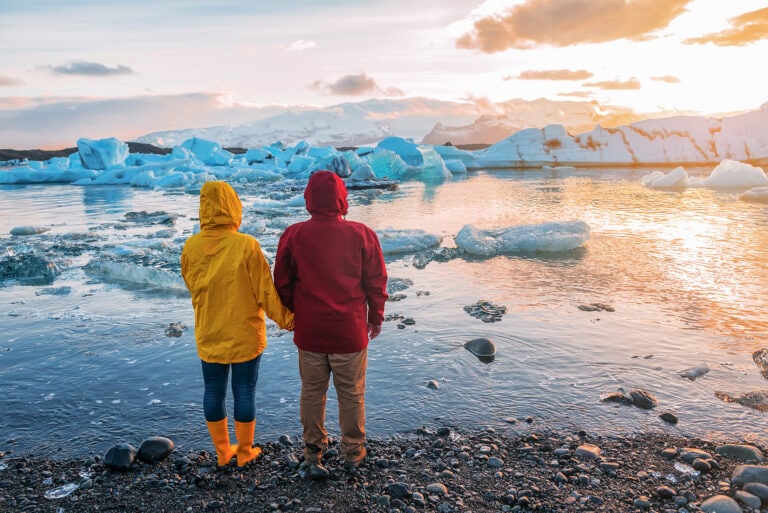
Private Tours vs. Custom Vacation Package in Iceland: Which Is Right for You?
Our comprehensive guide helps you determine which option best suits your travel style, budget, and preferences, ensuring an unforgettable journey through Iceland’s unique offerings.
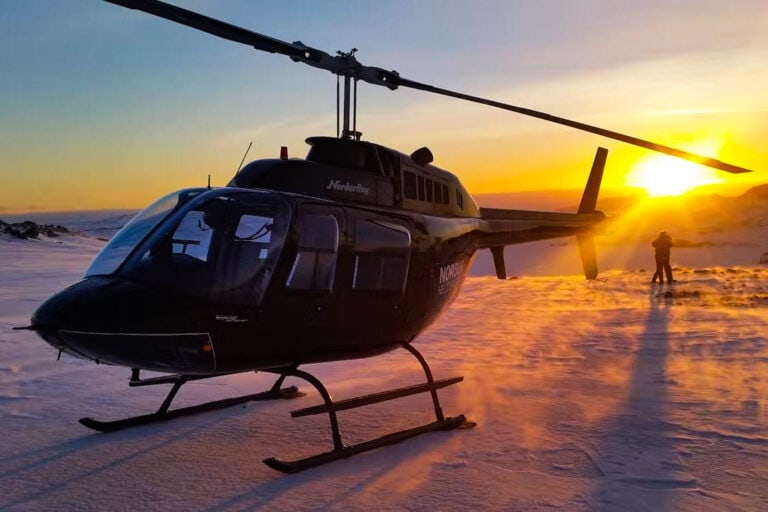
Iceland as a Luxury Travel Destination
Luxury travel in Iceland offers solitude and privacy, offering the wealthy a chance to immerse in untouched landscapes and exclusive experiences tailored for tranquility and disconnection from the everyday.
Recent Blogs
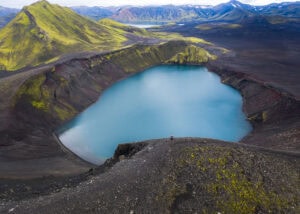
Personalized Adventures: The Benefits of Custom Tours in Iceland
Featured vacation packages, adventure-packed carbon neutral premium self-drive iceland tour – 8 day, sustainable iceland family adventure – 8-day co2 neutral self-drive tour, activity-filled co2 neutral self-drive tour – 5 days, action-filled luxury summer adventure, activity iceland by icelandia.
Authorized Tour Operator and Travel Agency certified by the Icelandic Tourist Board, a proud member of the Icelandia family . Tours offered on this website are sold under the license of Ferðaskrifstofa Kynnisferða.
- Private Tours
- Vacation Packages
- Golden Circle Tours
- Exclusive Offfers
- Our Car Fleet
- Luxury Travel Blog
- Privacy Policy
- Terms & Conditions
- Environmental Policy
- US/Canada: 1 (888) 642-8669
- International: (+354) 533 6003
- Klettagarðar 12. 104 Reykjavík
- [email protected]
- Contact form
© All rights reserved
Special offer
For a limited time on selected super jeep tours.

- Tour Packages
- Tours From Reykjavik
- Self Driving Activities
- Family Friendly
- Shore Excursions
- Private Tours
Northern Lights Tours
- Volcano Tours
- Itinerary Planner
- Custom Itinerary
- Travel Guides
- Things To Do in Iceland
- Locations in Iceland
- Hot Spring Map
Iceland in January – An ‘All You Need to Know’ Guide
One of the coldest and darkest months of the year, January, in Iceland brings out the best that winter season has to offer . The days get shorter and the land is covered in snow. January is the ideal time to visit Iceland if you are looking forward to having a snowy experience and enjoy the authentic cold weather of the north. January winters in Iceland have frosty roads and relatively fewer people on the street which means that the place is all yours to explore and experiment. January brings the leftover glitter from the Christmas holidays mixed with countless music festivals, parties marking the end of holidays, dancing Northern Lights , and extra cozy hot pots and hot baths.
- Read about Iceland in each month of the year
- Best Season to visit Iceland
- Top Winter Activities in Iceland
- Northern Lights in Iceland
- Hiking in Iceland
- Iceland Packing Lists
- Solo Travels in Iceland
- Rent a car in Iceland
- Discover hidden gems in Iceland.
- Self Driving in Iceland.

Things to Put on Your Checklist for January Visits
From frozen waterfalls to the snow-clad mountains, plains, and glaciers, Iceland in January is one of the most beautiful places to set your eyes upon. An array of activities awaits you which are nowhere to be found in any other part of the world. You will experience contrasting things in one single moment like a hot bath out in the open amidst the snow or beautiful glimmering skylights in the pitch-black sky. Here is a list of events and activities you should consider including in your trip plan to Iceland.
Northern Lights
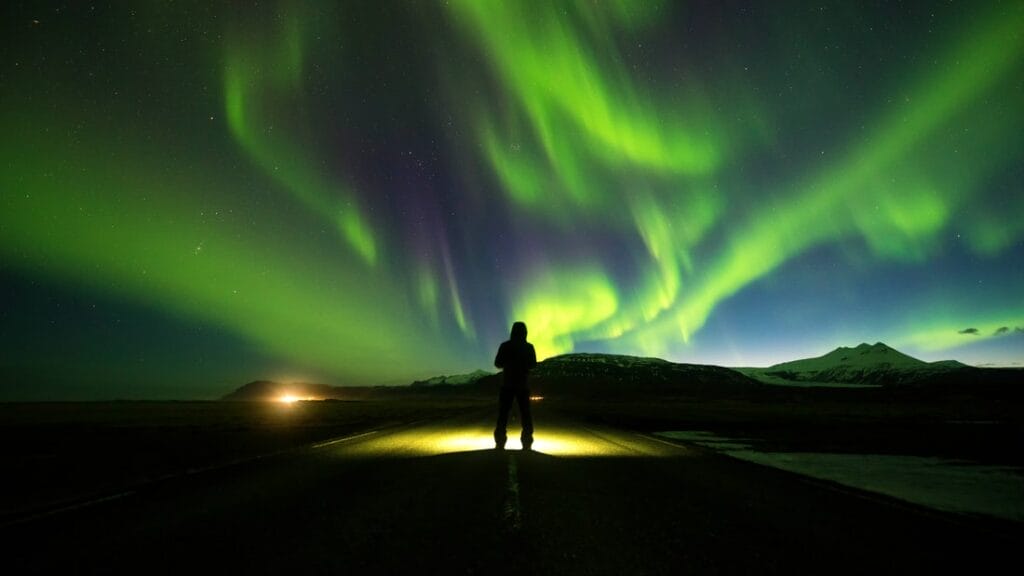
Also known as aurora borealis, Northern Lights are fairly visible anytime between September and April . Since January rarely sees daylight, it is the ideal month for the tourists to catch the Northern Lights. The lights are visible from the capital city however, consider going to areas with lesser light pollution like Thingvellir National Park to experience aurora borealis in its exact natural form. Several bus tours are conducted dedicated specifically to the Northern Light viewing. However, if you would like to see the view from hard to reach places than super jeeps are a good choice to take into regard. If you want to drive yourself, renting a vehicle is always an available option. For a more luxurious experience, you can take Northern Lights cruises from Reykjavík or Akureyri , and admire the beauty of the dancing lights being reflected on the water. Check Aurora forecast and make sure it is above ‘KP3’ before you set out on the journey and pick areas with the clearest sky for a disruption-free view.
The Golden Circle Tour

Even though there are some new ice caves that are possible to visit all year, the natural ice caves are the best in the winter season in Iceland. Cave season starts somewhere in Mid- October and lasts till April . Since January falls right in the middle of the season, the viewing parties are on peak. One thing to note is that no two visits to the Ice caves will ever be the same in Iceland. These caves are formed by glaciers and change every year due to their movements. If you are lucky enough and have booked a multi-day tour of the caves , then you may get to see the Ice Caves in more than one location in a single visit.
Glacier Winter Tours

Since snow is always present on the glaciers in the country, snowmobiling remains a year-round event in Iceland. Although it is a whole different kind of euphoria to take such a trip in the winter season when the whole place is covered in a thick layer of snow and the winds have an additional dose of crispiness in them. Any driver can rent a snowmobile and take a solo drive while other tourists over a certain age can enjoy as co-passengers.
- Snowmobile Tours in Iceland
- Snowmobiling in Iceland – info
- Best locations for snowmobiling in Iceland
Beat the Cold with Snorkeling and Diving
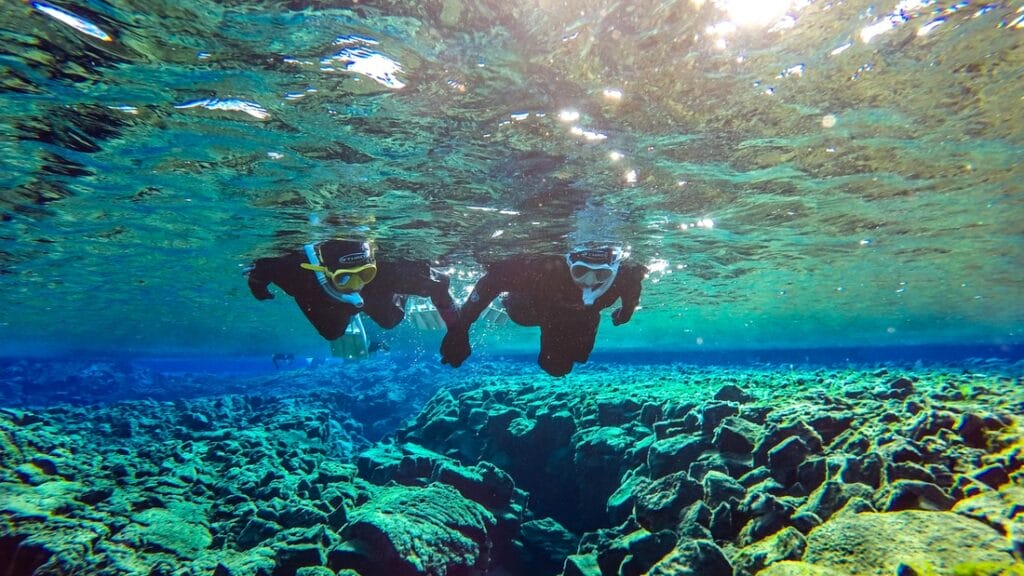
It may sound uncommon, but snorkeling is one of the most exciting activities to try in Iceland in January. Modern-day dry suits keep you safe from the cold water while you can enjoy the unique underwater sites – exclusive to the winter season. Silfra is the most popular site for snorkeling and diving expeditions. Silfra spring is located between tectonic plates in a fissure that never freezes. The tectonic placement of the spring makes every dive ‘a dive between the continents.’ The lava rocks filter the spring water increasing the visible to 100 meters. Making it one of the clearest water in the world. Snow-lined ravine and the ice sculpture along the spring make the expedition a more dramatic experience for the tourists. Although it is very safe to dive in Silfra, it is recommended that you go on a guided tour. all the necessary safety measures and health parameters established by the tour guides should be followed for a healthy and secure experience.
- Snorkeling Tours in Iceland
New Year’s Eve Festival

If you get to Iceland on or before January 1 st , then it is a sure thing that you will catch the incredible fireworks display to welcome the new year. The uncoordinated display is facilitated by the locals who buy fireworks and let them off throughout the night of December 31 st and early hours of January 1 st . In addition to the new year’s celebration, Christmas celebrations last till the 6 th of January as per the Icelandic traditions. Iceland celebrates the 13 Icelandic Yule Lads on Christmas instead of the arrival of Santa Claus. The traditional celebrations are carried out on the 24 th instead of the 25 th of December. The last day of the celebrations includes huge bonfires, merrymaking, food, drinks, and banter in the whole country with the lighting of the leftover fireworks.
- New Years Eve in Iceland
Dark Music Days
Taking place during the darkest days of the year, the Dark Music Festival celebrates new and contemporary music and takes place at the concert hall Harpa in downtown Reykjavík . The festival brings together both national and international talents from both sides of the Atlantic and takes place at the end of January. Any music lover out there visiting Iceland during January cannot afford to miss this festival as it features upcoming new artists from not only Iceland but all around the world.
The Reykjavík International Games
Ranging from fencing, power lifting, and martial arts to dancing, skiing, and figure skating, the Reykjavík International Games is another event that gathers immeasurable talents from all over the country and around the world in one place. The events are mostly held in the park Laugardalur in Reykjavík.
Don’t Forget the Food

One thing that will never cease to surprise you is the presence of soothing warm natural hot springs among the snowclad land of Iceland. The abundant geothermal energy of the country has created a large number of hot springs as the underground water is naturally boiling. One of the most popular destinations when it comes to the hot and heavy baths is the beautiful Blue Lagoon . The contrasting visual elements like the foggy atmosphere (due to the steam), black rocks, and the snow-white mountains create a sight to behold. Apart from that, you can consider visiting the Secret Lagoon , Reykjadalur hot spring river , the nature baths in Mývatn , Geo Sea in Húsavík and Seljavallalaug in south Iceland. Some of these hot spring destinations such as the Blue Lagoon require online registration due to the increased popularity. So, make sure that the necessary arrangements are made beforehand.

10 Unique Activities Around Iceland
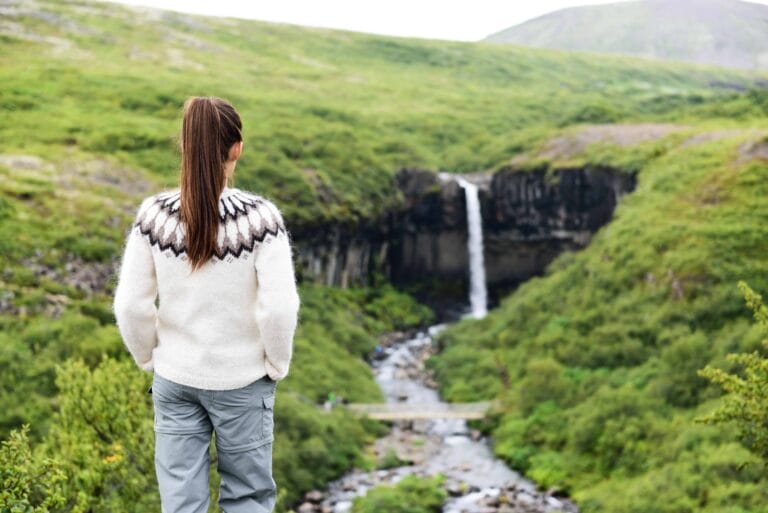
Iceland Packing List

Top Alternatives When Your Iceland Tours Get Canceled

Best Selling Self Drive Activities in Iceland | Summer 2023
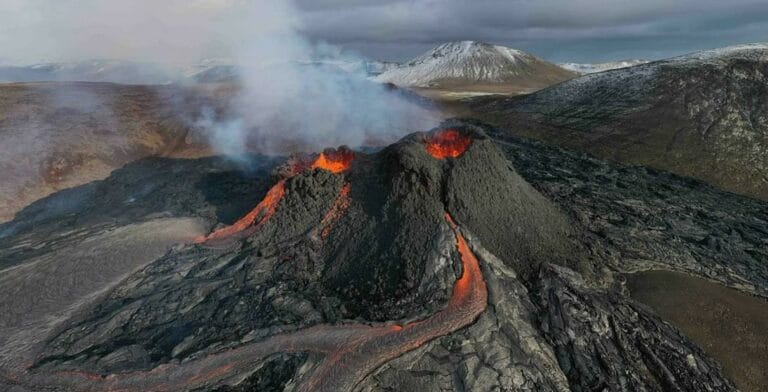
Volcano in Iceland: July 2023 Eruption at Litli-Hrútur | All you need to know
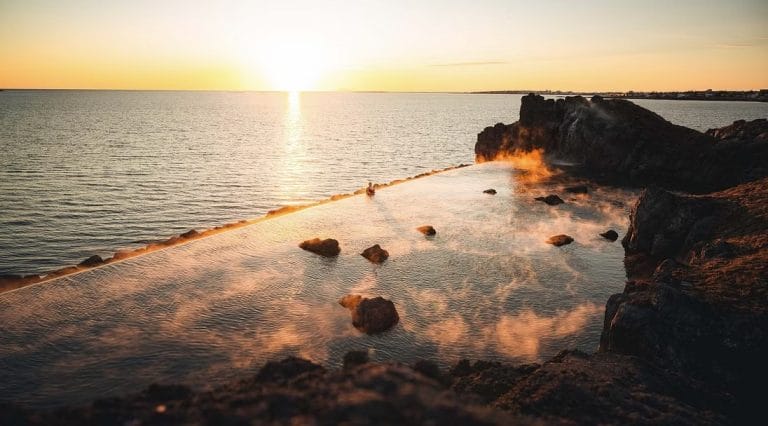
Sky Lagoon vs Blue Lagoon

Top 10 Iceland Locations
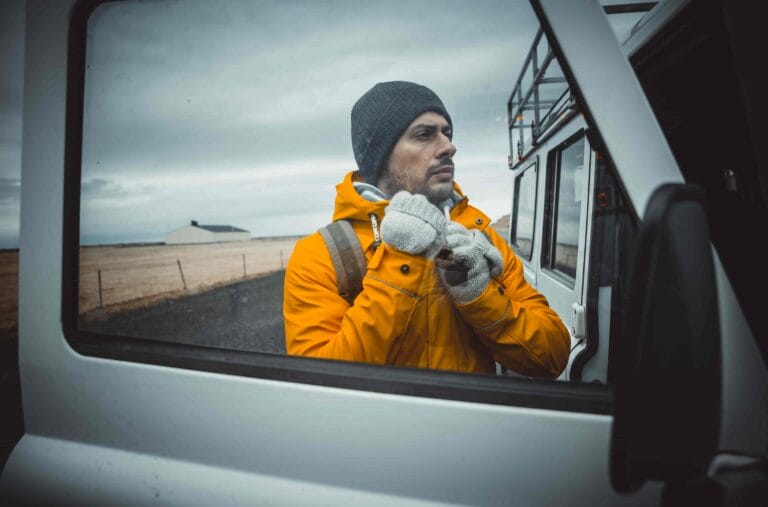
Black Friday Deals for your trip to Iceland 2021
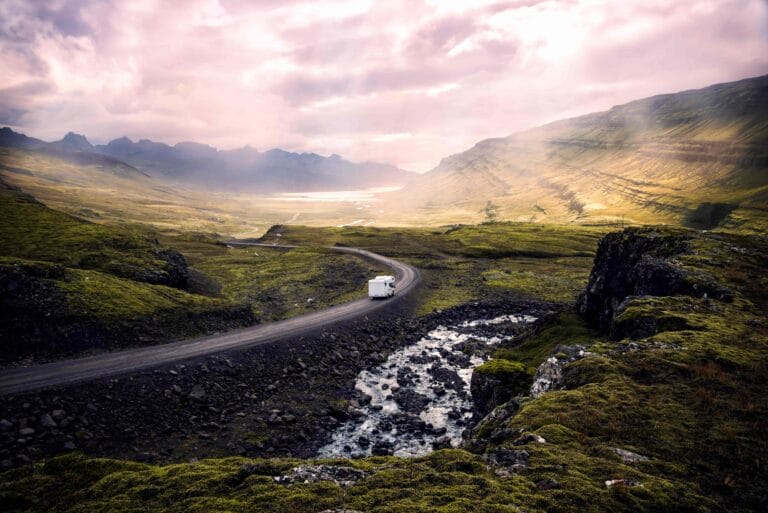
7 Reasons why you should Rent a Camper Van in Iceland
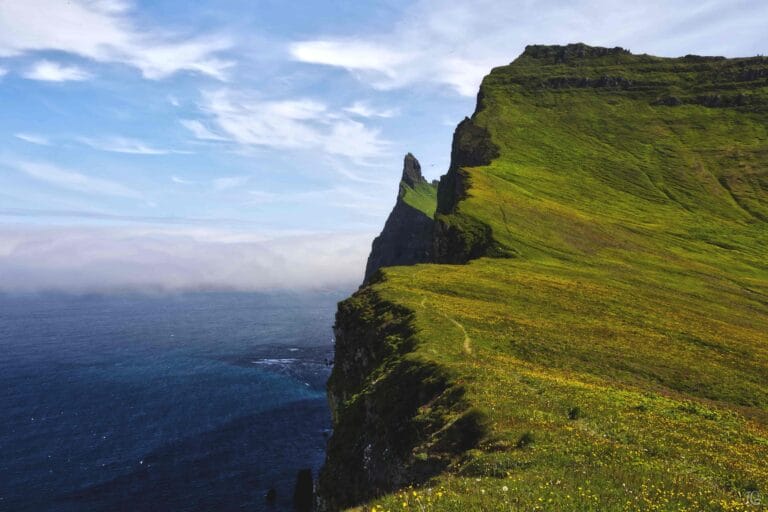
How to hike Hornstrandir on your own?
Popular things to do, sightseeing tours, glacier tours, hot spring tours, ice cave tours, glacier hiking tours, hiking tours, super jeep tours, whale watching tours, popular tours.

Katla Ice Cave | The Ice Cave Under the Volcano | Super Jeep Tour from Vik
Travel style, starts from, from 27,900 isk.
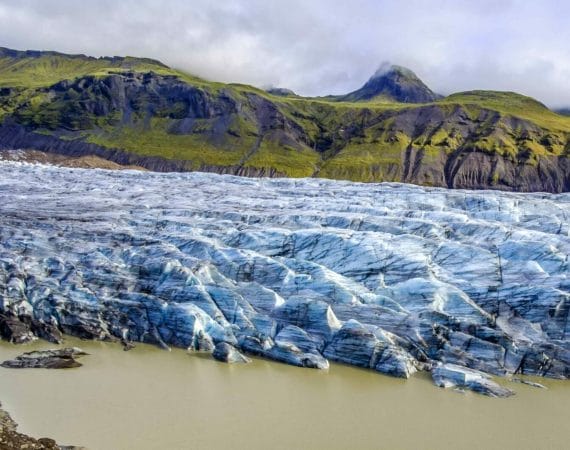
8 Day Iceland Tour – Summer
From 399,897 isk.
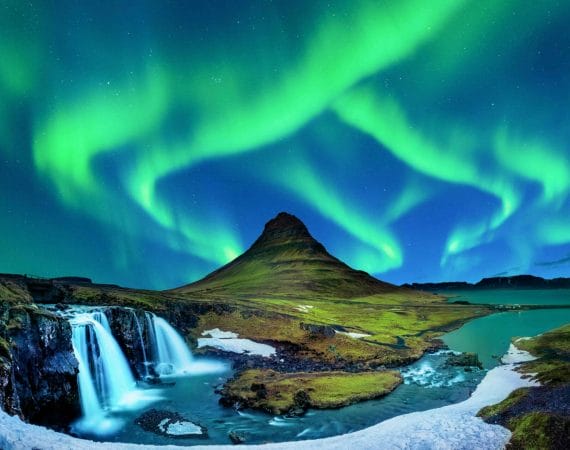
8 Day Iceland Tour – Winter
From 329,900 isk.

Into the Glacier – from Húsafell
From 24,900 isk.

South Coast, Waterfalls & Glacier Hike
From 22,990 isk.
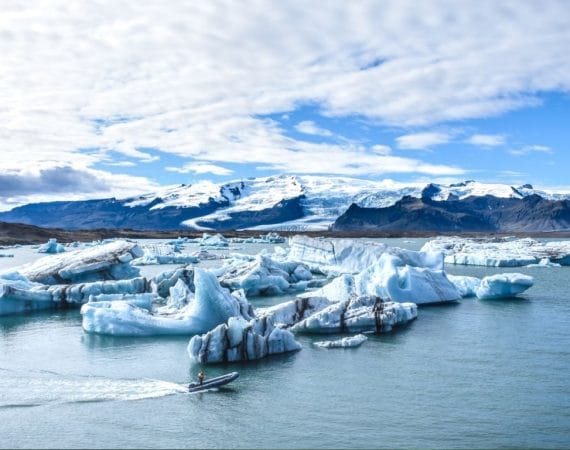
3 Day Summer Tour – Golden Circle & South Coast
From 119,000 isk.
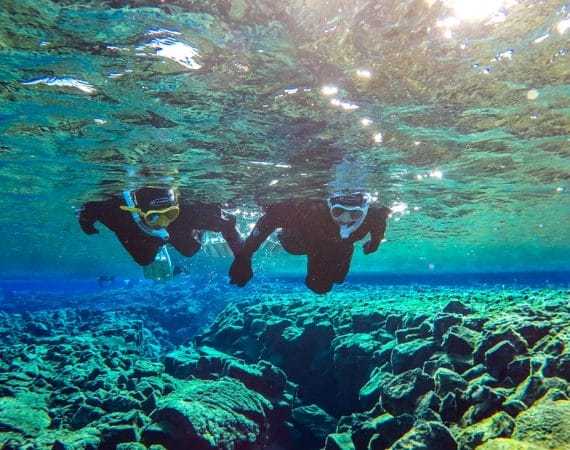
Silfra Snorkeling Tour | Snorkeling between tectonic plate
Thingvellir
From 18,990 ISK

8 Day Iceland Northern Lights Tour Package
From 399,990 isk.
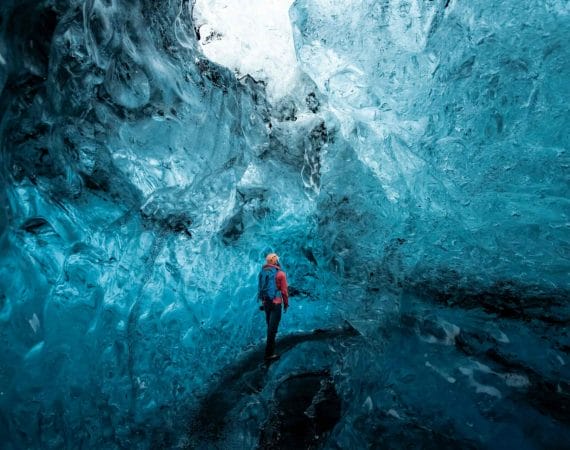
Crystal Blue Ice Cave in Iceland | Super Jeep from Jökulsárlón
Jokulsarlon Glacier Lagoon
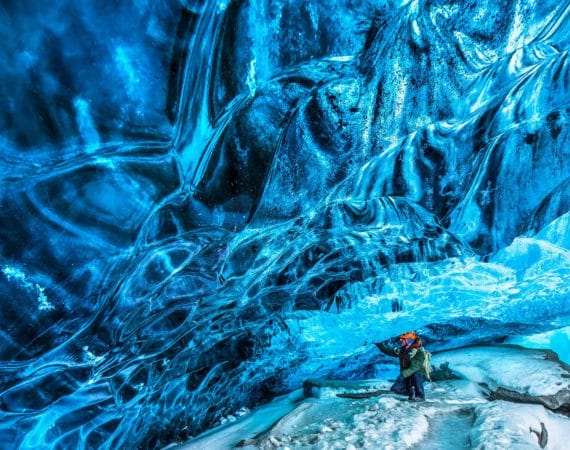
2 Day Winter Package | Blue Ice Cave, South Coast, Skaftafell & Northern Lights
From 77,900 isk, more interesting articles.
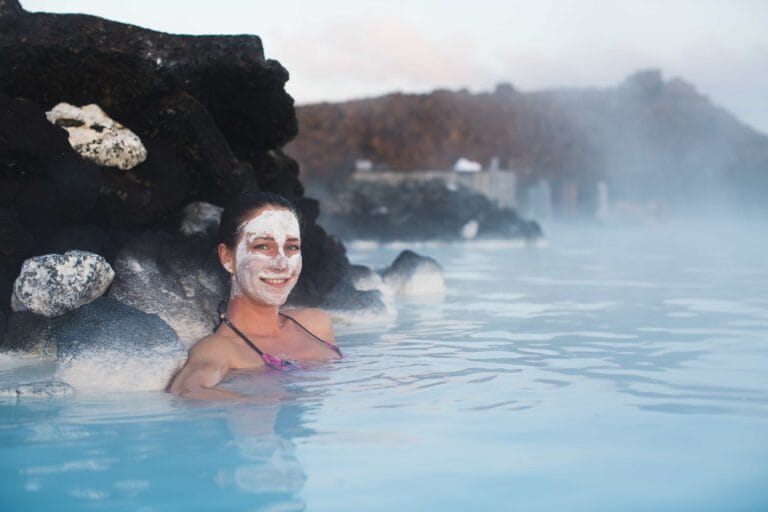
Arriving early in Iceland? Here is a list of what you can do!
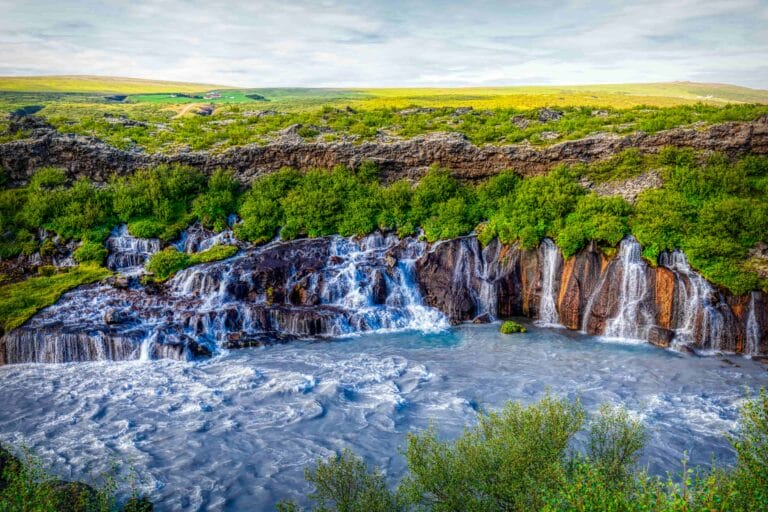
The Silver Circle of West Iceland

Top 103 Locations in Iceland – Map

Iceland Travel Guide to Geldingadalur Volcanic Eruption
Most popular things to do in iceland.

Snowmobile Tours

Horse Riding Tours

Top Attractions in Iceland

Seljalandsfoss

Reynisfjara

Jökulsárlón

Blue Lagoon
Explore iceland by region.

Golden Circle
South iceland.

Snaefellsnes

West Iceland

East Iceland

North Iceland

Hidden Gems
- Best time to visit Iceland
Book your individual trip , stress-free with local travel experts
Select Month
- roughguides.com
- Travel guide
- Itineraries
- Local Experts
- Travel Advice
- Accommodation
Plan your tailor-made trip with a local expert
Book securely with money-back guarantee
Travel stress-free with local assistance and 24/7 support
Carson (United States)
I must tell you that my tour with you is probably THE best tour I've ever taken (and I've taken a lot). My guide Rico set a bar so high that I don’t know i...
Whilst Iceland has no trouble giving travellers a reason to visit all year round, the seasons vary hugely, due to how north the country sits. Iceland's geographical position not only affects the weather but also the hours of daylight you can expect to have. These, alongside the best times to see the Aurora Borealis, or Northern Lights , are crucial factors in deciding the best time to visit Iceland.
What is the best time to visit Iceland?
What are the travel seasons in iceland, best time to visit iceland month by month, best time to see the northern light in iceland, planning for your iceland road trip, best time to visit iceland: events and festivals, travel ideas for iceland, created by local experts.

Iceland's Highlights from East to West
Take a flight to the East where you get to enjoy the enchanting Eastfjords before you drive south. If you are looking to focus on a few regions with a mix of the most popular sights and something off the beaten path; and to avoid backtracking with a one-way domestic flight, this is the perfect trip.

Discover North Iceland and Snaefellses
Discover the best of North Iceland and Snaefellsnes! The area around the volcanic Lake Myvatn is surrounded by impressive geological sights, stunning waterfalls and mighty canyons! The Snaefellsnes peninsula is known as “miniature Iceland” for the diversity of landscape it offers.

Best of the West
Take the road less travelled around the Westfjords and Snaefellsnes peninsulas. Visit places unspoiled by humans and see the wonders and creativity of nature at their very best! The wild Westfjords feature a stunning landscape of towering mountains, deep blue fjords, and thundering waterfalls.

East to West with the Westmand Islands
Drive around the Lake Lagarfljot and visit Hengifoss waterfall and the Hallormsstadur forest. Continue to the South Coast with its beautiful waterfalls, glacier lagoons and black sand beaches. Take a detour to spend a day in the stunning Westman Islands and end your trip with the Golden Circle.

All of Iceland in 13 days
In just under 2 weeks, explore the highlights Iceland has to offer. From the popular Golden Circle, follow the Ring Road and explore waterfalls and lagoons on your way around the island. This itinerary leads you all the way to the North and the Westfjords of Iceland.

Incredible Iceland in 12 days
This driving trip trip will take you to some of Iceland’s most incredible sights and natural wonders. Drive through glacial valleys and across towering mountains as you gaze over stark landscapes of shining silver steaks and marble lava fields patched with emerald green moss...
The best time to visit Iceland varies greatly depending on the activities and experiences you are seeking. For outdoor recreation, the months of June to September are ideal, offering mild weather and extended daylight hours, perfect for exploring Iceland's unique landscapes. For those eager to witness the mesmerizing Northern Lights, the darkest months of December to January are the most suitable. For snow sports enthusiasts, February to March is the prime time, with Iceland's winter landscapes providing perfect conditions for skiing and snowboarding. Lastly, if you prefer off-peak travel to avoid crowds and potentially lower costs, April to May is an excellent choice, offering a quieter yet equally beautiful experience of Iceland.
Want more tips? Read our content manager's personal experience travelling in Iceland and find out the important aspects you're likely to encounter on your trip.
Best times to visit Iceland for good weather
The ideal time for favorable weather in Iceland is the summer season, extending from late June to September. Temperatures during this time range from 12°C-20°C, and the sunny setting in Reykjavik is a delight to experience. The vibrant purple lupines flourish over the meadows, making it an ideal time for hiking and exploring the natural beauty of Iceland.
Best times to visit Iceland with fewer crowds
Planning a trip to Iceland during the shoulder seasons of March, April, May, and September can help you avoid the tourist rush. During these transitional months between the peak and off-peak seasons, you can enjoy relatively good weather with fewer crowds. The sights and sounds of the glaciers, hot springs, and northern lights can be thoroughly enjoyed without the hordes of tourists.
Worst months to visit Iceland
The worst time to visit Iceland in terms of the weather and outdoor activities predominantly corresponds to the winter months, notably November, December, and January. During this period, the country faces extreme weather conditions featuring heavy snowfall and chilly temperatures. These elements, in conjunction with shorter daylight hours, make outdoor exploration quite challenging for all but the most adventure-loving visitors.
Aiming to beat the crowd? Then it's worth noting that June to August, despite being the best time for outdoor activities, are the months where the popular tourist spots like the Golden Circle, Blue Lagoon , and Jökulsárlón Glacier Lagoon see significant crowd inflow.

Mountain Stapafell in the background at Arnarstapi Village in summer sunny day in Iceland ©Shutterstock
The best time visit Iceland doesn't always depend on the weather, but could be season related too. Let's dive deeper into Iceland seasons.
Iceland peak season
The peak travel season in Iceland spans from June to August. During these months, the country experiences the mildest weather, longest daylight hours, and offers the most activities. The radiant midnight sun is a spectacular sight in June and July. This period sees the highest tourist influx, making it the most vibrant but also the most crowded.
Considered the best time for outdoor activities like hiking and kayaking, it's also perfect for reveling in the rich wildlife of the country. It is particularly great for spotting whales and birds. However, the high footfall of tourists also means spiked prices and crowded destinations. It’s recommended to book accommodations , transportation and trips in advance if you plan to visit during the peak season.
Iceland shoulder season
Shoulder season in Iceland, consisting of May, September, and early October, offers a balanced mix of good weather, reasonable prices, and lesser crowds.
In May, the snow has begun to melt, the nights are filled with stunning sunset hues, and the low-season hotel rates can prove a steal. Attractions, however, are less crowded, and many museums and sites that close during the winter are now reopening. The weather can still be unpredictable, with a breeze and potential snow in the country's interior.
September and early October are glorious months for landscape photographers and aurora borealis chasers. It's an excellent time to witness the extended pink dawns and dusks that paint the Icelandic landscapes, and partake in daytime hiking with nighttime vigils for the Northern Lights. The weather is relatively pleasant for longer periods, making it an engaging time for stargazing.
Iceland low season
Iceland's low season stretches from mid-October to the end of April. The most prevailing challenge during this time is the extreme cold weather, with temperatures often plummeting to -30 degrees Celsius. Add to this the wind chill, and it can feel even colder. Daylight, too, becomes scarce, with December offering only about four hours of light each day.
But winter in Iceland also has its own charm and advantages. One major highlight during the low season is the breathtaking ice caves and glaciers that come into their prime, providing an arresting sight for nature lovers. Additionally, fewer tourists lead to less crowding at popular attractions and in towns.
On the downside, it's difficult to get off the beaten track due to road closures. Many outdoor activities and attractions close down during this period except for those catered to experienced winter adventurers. Despite these limitations, it's worth noting that low season is synonymous with lower travel costs and offers an entirely different perspective on Icelandic landscapes.
Tip from Rough Guides: also learn about the best ways to get to Iceland .

If you're into nature, Iceland is a great destination!
If you don't know what month will be best for you, read on about the best time to visit Iceland month by month.
Visiting Iceland in January
For those seeking tranquility and a magical winter wonderland, January is a fabulous time to visit Iceland. It is one of the quietest times, meaning key attractions are significantly less crowded. The days are short, with the sun rising around 11 am and setting around 4 pm. Even though these short dark days can mean reduced sightseeing time, they also increase your chances of witnessing the mesmerizing Aurora Borealis, or Northern Lights.
The January landscape is covered in crisp white snow, providing a breathtakingly beautiful backdrop for winter activities such as snowmobiling, and ice cave exploration. Furthermore, thermal baths and hot springs offer a respite to the sub-zero temperatures, which can range between -10°C and 0 °C.
Visiting Iceland in February
Visiting Iceland in February allows you to experience the beauty of the country in its winter glory. Temperatures range between -10°C and 8 °C and the days provide more daylight hours than in January, though sunlight continues to hang low, giving Iceland a golden tinge, making for some fantastic photo opportunities.
One of the biggest attractions in February is the high probability of catching the Aurora Borealis, creating vivid displays in the Icelandic night sky. The sight is so captivating that it draws numerous tourists from around the world. Also, weather permitting, you can venture on iceberg, waterfall, or glacier tours outside the city.
Visiting Iceland in March
Visiting Iceland in March offers a unique blend of winter's beauty and the emerging signs of spring. This time of year is ideal for experiencing a mix of snow-covered landscapes and longer daylight hours, allowing for extended sightseeing. It's a fantastic period for winter activities like snowmobiling, glacier tours, and especially for viewing the Northern Lights, as the nights are still dark enough for their vivid display.
March in Iceland also marks the beginning of the whale watching season, providing an opportunity to witness these magnificent creatures in their natural habitat.

Iceland northern lights © Shutterstock
Visiting Iceland in April
April is the harbinger of spring in Iceland and serves as an attractive time to visit. Days grow longer, with approximately 14 hours of sunlight, and the icy landscapes slowly start to thaw. The temperatures can range from 3-6°C, offering a relatively pleasant climate for outdoor activities.
While winter activities are winding down, there still might be some opportunities for snowmobiling or ice cave adventures, especially in the earlier part of the month. You can partake in brisk hiking excursions, taking in the crisp air and magnificent views as the country blossoms into spring. Southern Iceland regions around Skogafoss, Vik, and Jökulsárlón Glacier Lagoon are particularly picturesque during these months.
Looking for more options for your holiday in April? Find the perfect holiday destination with our top suggestions .
Visiting Iceland in May
May is a fabulous time to visit Iceland, marking the transition from the shoulder season to the beginning of summer, with daily daylight hours surpassing fourteen. Temperatures range from 9°C to 12°C, providing an agreeable climate for various activities.
The onset of spring, coupled with lengthening days and the midnight sun, paints the country in vibrant colors. Landscapes become lush, and the blooming wildflowers add a special charm to the scenery.
Wildlife is another highlight of visiting Iceland in May. From whale watching tours to puffin-spotting excursions, wildlife enthusiasts are sure to enjoy their stay. The adorable puffin bird returns to the shores of Iceland starting in mid-April, so sightings are strongly probable in May.
Visiting Iceland in June
June marks the beginning of a spectacular summer season in Iceland when the country experiences the delightful phenomena of the midnight sun, with almost 24 hours of daylight and ample opportunities to explore the great outdoors.
Temperatures typically range from 9°C to 15°C, but the weather remains unpredictable, with bright sunny days often swiftly turning to heavy cloud cover or misty rain, so light layers and waterproof clothing come in handy.
The midnight sun is a sight to behold, it is when the sun is still visible even at midnight, creating a perpetual twilight. This phenomenon leads to some unforgettable memories and excellent photography opportunities.

Skogafoss waterfall, Iceland © Shutterstock
Visiting Iceland in July
July embarks on the height of summer, marking it as one of the warmest and busiest months in Iceland. It punches in 24 hours of daylight, kicking off the enchanting 'Midnight Sun' period. Average temperatures rest between 10°C to 15°C, leading to pleasant, sunny days that make outdoor exploration inviting.
The month is noted for its long, lazy days that stretch till almost midnight, followed by the sun rising again around 4 am. Trails for hiking, including the famous Laugavegur trail and those of the usually inaccessible Highlands, pop open and the eerie late-night light is irresistible especially for photographers.
Whale watching tours are in full swing in Iceland in July, which teams beautifully with snow-free roads for drives and hikes around the country. The 'Midnight Sun' also simplifies long drives along the iconic Route 1 or 'Ring Road,' which wraps around the island with plenty of must-see locations along the way.

Visiting Iceland in August
August is a veritable feast of summer in Iceland, making it a highly recommended time to visit. This month witnesses the country in full swing, with long daylight hours and temperatures generally ranging between 11°C and 15°C, slightly cooler than July but still warm relative to local standards.
Despite the summer rush, Iceland retains its freshness and appeal in August. The lush landscapes, blooming florals, and a voluminous burst of colors paint the most picturesque image of this Nordic land. Icelandic forests take on a remarkably green hue, lakes shimmer under the mild sun, and cascading waterfalls spring to life.
Visiting Iceland in September
September kicks off the autumn season in Iceland and serves up enchanting landscapes awash with oceans of red, brown, and gold—the best time to witness the country's fall foliage. The temperatures range between a comfortable 5°C (41°F) to 9°C (48°F). As the crowd thins out post the peak season rush, tranquil serenity sets in, and the country's beautiful destinations become less crowded.
One of the prime advantages of visiting Iceland in September is the opportunity to catch the Northern Lights. As daylight hours start to reduce, the equinox in mid-to-late September increases solar activity, making the conditions ideal for viewing this natural spectacle.

Hiking the Laugavegur trail is one of the best experiences in Iceland © Shutterstock
Visiting Iceland in October
October can be a magical time to visit Iceland, where the season shift from autumn to winter can be strongly felt. The weather becomes more unpredictable, with temperatures varying between 2°C (35°F) and 7°C (45°F), and the first snowflakes of the season might start to fall, dusting the already vibrant landscapes with a touch of winter's wonder.
While the days start to shrink significantly, the amazing spectacle of the Northern Lights becomes more prominent. This is one of the best times to chase the aurora borealis, with solar activity being high and less light pollution due to shorter days.
Natural wonders become a serene spectacle with pops of falling leaves colored in hues of red, orange, yellow, and brown. October is the last month when you can tour the highlands before the roads close for winter. Therefore, it's a great time to visit Landmannalaugar, Thórsmörk, or other highland attractions.
Looking for more options for an autumn holiday? Also check out our list of the best destinations for an unforgettable holiday in October .
Visiting Iceland in November
Visiting Iceland in November means embracing winter's arrival as temperatures dip between -2°C to 3°C, becoming colder as the month progresses. The days also get significantly shorter, with roughly 6-8 hours of daylight, providing a whole different range of experiences to explore under darker skies.
Arguably the star attraction during this time is the mesmerizing Northern Lights, which make their appearance more reliably as nights get longer. A late-night sweep to chase these mystical lights can turn out to be a highlight of your trip.
Although the weather is chilly, the snowy landscapes and the waterfalls clad in winter dress present another level of beauty. November offers the opportunity for some unique winter activities like glacier hiking and exploring newly formed ice caves. Adventurers can also go snowmobiling on glaciers or try their hand at winter sports.
Visiting Iceland in December
Stepping into Iceland in December is like striding into a fairytale-like winter wonderland. With average temperatures ranging from -1°C to -5°C, this month delivers the country's most intense winter experiences, complete with snowfall, nearly round-the-clock darkness, and an enchanting Christmas atmosphere.
Look beyond the short daylight hours, and you'll find a capital city that's a slice of holiday magic. Reykjavík comes alive in December with Christmas lights illuminating the city, streets adorned with decorations, and 13 jovial Santa Clauses, the Yule Lads, bringing holiday cheer.
Furthermore, New Year's Eve in Iceland is a sight to behold. Locals and tourists alike gather to build bonfires and set off fireworks, making for a memorable experience and a spectacular welcome to the coming year.
For the most accurate live weather updates, you can check Accuweather .

Winder Wonderland at the Reykjadalur Steam Valley © Shutterstock
To witness the Northern Lights at their peak, aim for the winter months between September and April. This period, characterized by long, dark nights, contrasts sharply with the bright summer nights in Iceland, offering optimal conditions for observing this natural phenomenon.
Make sure to read our article about the best places to see the Northern Light in Iceland.
Between September and April
The ideal time to spot the mesmerizing Aurora Borealis or the Northern Lights in Iceland ranges from September to April. The period perfectly coincides with Iceland's darker months, providing ample nighttime hours for this natural light spectacle to shine through.
As sunlight begins to recede in October, the duration of darkness gradually lengthens, bringing increased opportunities to see the Northern Lights. The display grows more pronounced from November to January, albeit with shorter daylight hours and extreme cold weather. However, clear skies during these months contribute to better visibility.
It's important to be aware that Northern Lights sightings are naturally unpredictable, relying on solar activity and sky clarity. Create a flexible itinerary to adapt to cloud cover or solar activity changes.
Tracking weather and solar activity through reliable online resources like the Icelandic Meteorological Office or websites providing Aurora Forecasts can help you gauge the most suitable nights for viewing the lights.
Best places to see the Northern Lights
The magical Northern Lights can be seen across Iceland during winter months, but there are some places that offer particularly stunning views due to minimal light pollution:
- Thingvellir National Park: Being a UNESCO World Heritage site and away from the city lights, this park offers a darker sky, providing an optimal setting for viewing the Northern Lights.
- Jokulsarlon Glacier Lagoon : The floating icebergs on the lagoon add an otherworldly charm to the backdrop of the Northern Lights, resulting in visually stunning scenes.
- Vik : Located south of Reykjavik, the town of Vik, with its black sand beaches, offers a serene and somewhat surreal location to view the Northern Lights, with the dancing lights reflecting off the ocean waves.
- Snaefellsnes Peninsula : Enhanced by its remote location, the peninsula offers an excellent platform for Northern Lights viewing, with the added feature of the famous Kirkjufell mountain as a gorgeous backdrop.
- Grotta Lighthouse, Reykjavik: If you're based in Reykjavik and don't want to venture too far, the area around the Grotta Lighthouse offers one of the best viewpoints in the city. It's still crucial to have a clear and dark night for the best viewing experience.
Remember that viewing the Northern Lights is heavily dependent on the right weather conditions and solar activity. Therefore, keep a close eye on the forecast and be prepared to change your plans accordingly. It's always recommended to join a Northern Lights tour, wherein expert guides can take you to the best locations based on real-time forecasts and conditions.

Northern lights reflected in Jökulsárlón glacier lagoon © Krissanapong Wongsawarng/Shutterstock
Embarking on an Iceland road trip? Our guide helps you navigate this breathtaking landscape, ensuring a memorable journey through Iceland's natural wonders, from volcanic terrains to icy vistas. Let's get your adventure on the road!
Iceland's Ring Road – when you have time
Iceland's Ring Road, also known as Route 1, encircles the entire country, providing the chance to see the best of Iceland's breathtaking landscapes. Spanning 1,322 kilometers or 821 miles, it's an exceptional drive that can be completed year-round, but the best months for travel are between April and October when the weather is generally calmer.
The least duration advised to drive the scenic stretch is one week, but 10-14 days are recommended to immerse fully in the Icelandic landscapes and diverse attractions. This extended travel period provides enough leeway to explore major attractions such as Geysir, Thingvellir National Park, Vatnajökull National Park, Skaftafell National Park , the black sand beaches of Vik, the charming town of Akureyri , Myvatn , and much more.
You can drive in a clockwise or counterclockwise direction, with accommodation options varying from hotels to guesthouses and camping sites along the way.
Pack plenty of food, water, and supplies for your journey, check road and weather conditions regularly, and ensure to fuel up wherever possible, as gas stations can be at a considerable distance apart.
Make sure to check Safetravel.is for the most recent updates.
Short road trips in Iceland
If time-constrained or preferring shorter trips, you'll be glad to know that Iceland boasts several shorter yet utterly mesmerizing road trips. Here a few recommendations:
- The Golden Circle: One of the most popular routes, the Golden Circle, is an easy day trip from Reykjavik. This 300 km loop covers notable sights like Thingvellir National Park, Geysir Geothermal Area, and Gullfoss Waterfall.
- The Blue Diamond Road: This route circles the Reykjanes Peninsula, located near Reykjavik and Keflavík International Airport, making it an easy day trip. This region is home to the famous Blue Lagoon as well as an array of lava fields, geothermal areas, bird cliffs, and beautiful coastline.
- South Coast Drive: A drive along the South Coast up to Jökulsárlón Glacier Lagoon and Diamond Beach offers hulking glaciers, pristine beaches, beautiful waterfalls, and other natural wonders, all within 370 km from Reykjavik.
- The Arctic Coast Way and the Diamond Circle: Both situated in North Iceland, each route presents awe-inspiring landscapes, with the Arctic Coast Way encompassing 900 km of northern coastline, and the Diamond Circle featuring notable attractions like Dettifoss Waterfall and Myvatn Nature Baths in just 260 km.

Strokkur geyser along the Golden Circle © Shutterstock
Iceland's holiday calendar blends Christian and secular traditions, with some festivals dating back to pagan times. Familiar celebrations like Christmas, Easter Monday, and New Year are observed similarly to other Western nations.
The midwinter celebration Þorrablót, rooted in the Viking era, honors the weather god Þorri. Held throughout February, it features parties centered around traditional Icelandic foods like svið and hákarl.
Sjomannadagur (Seamen’s Day) on June 4 is a significant holiday, marked by community events such as mock sea-rescue demonstrations and swimming races. Independence Day on June 17 commemorates Iceland's separation from Denmark in 1944.
Jónsmessa, on June 24, while not an official holiday, is steeped in folklore, believed to be a time when elves and magical creatures are active. Celebrations often include bonfires and, according to tradition, running around naked for good health.
Verslunnarmannahelgi, akin to a Labour Day Weekend, occurs on the first weekend of August. Icelanders traditionally camp in the countryside, engaging in extensive celebrations. Concurrently, Heimaey in the Westman Islands hosts Þjódhátið, featuring live music and bonfires, marking Iceland’s partial political autonomy achieved in 1874.
An event of note is the annual stock round-up, or rettir, in September. During this time, horses and sheep are herded from summer pastures by riders on horseback, with some farms allowing guests to observe or participate in the sorting process.
The Rough Guides to Iceland and related travel guides
In-depth, easy-to-use travel guides filled with expert advice.

Travel advice for Iceland
From travel safety to visa requirements, discover the best tips for traveling to Iceland
- How to get to Iceland
- Sports and Outdoor activities in Iceland
- Eating and drinking in Iceland
- Getting around Iceland: Transportation Tips
- Travel Tips Iceland for planning and on the go
Find even more inspiration here

- Travel Tips
written by Rough Guides Editors
updated 13.06.2024
Ready to travel and discover Iceland?
Get support from our local experts for stress-free planning & worry-free travels.
- Where to stay
- Travel advice
Aurora Tracks See Northern Lights

ICELAND Northern Lights Month-by-Month Planner

Planning a successful trip to Iceland for the aurora begins with choosing the right time of year. In this article, we breakdown Iceland Northern Lights month-by-month, and explain what the best month to see northern lights Iceland is.
Iceland is well-renowned as a prime aurora-chasing destination, with many tours and accommodation designed around aurora hunters seeking a glimpse of these spectacular lights. However, despite the inspiring photos and travel marketing hype, it is not as simple as wandering over to the icy land, stepping outside your hotel, and seeing them blaring in the sky whenever you like. There are many factors that come into play which allow you to see the northern lights, and the most important one is choosing the right time of year.
If you plan on visiting Iceland to view the northern lights, it is important to make sure that you plan ahead of time. Every year, countless people make their way up to Iceland in order to hunt for the elusive auroras, which can make it very difficult to find available accommodations if you are searching at the last minute. In this guide, we explain the best month to see Northern Lights Iceland, to ensure you plan and book your trip for the right time and give you the best chance of seeing them. We also explain other factors that affect aurora visibility, so you can plan your trip accordingly.
So, read through this guide as well as our other Iceland Northern Lights articles here , and start planning for a wonderful aurora vacation.
Factors Affecting Iceland Northern Lights Visibility
There are many factors that affect the visibility of the aurora borealis in Iceland. These include the location, the Earth’s magnetic activity, solar activity, weather conditions, light pollution, both the season and time of day, as well as the solar cycle.
Geographical Location
The closer to the poles you are, the easier it is to view the elusive lights. In the northern hemisphere, the best locations to see the aurora borealis are Alaska, Scandinavia, northern Canada, and of course Iceland. The chances of catching a glimpse of the northern lights increase as you get closer to the magnetic poles.
Magnetic Activity
The magnetic activity also plays a very important role in the visibility of the auroras. The lights themselves are actually caused by an interaction of the sun’s solar radiation with the Earth’s magnetic field. When magnetic activity surrounding the planet increases, it helps to enhance the visibility as well as the intensity of the northern lights. The best time for viewing the auroras is when geomagnetic storms are at their highest.
Solar Activity
Naturally, solar activity is crucial to the creation of auroras. The more active the sun is, the greater the visibility of the northern lights. During solar cycle peaks, large amounts of radiation are ejected from the surface of the sun into space. As this solar radiation passes around the Earth’s magnetic field, it results in an ionization of the upper atmosphere. This ionization is what creates the northern lights.
Weather Conditions
While the actual weather conditions play very little role in the creation of the auroras, they are crucial to ensuring that the elusive lights are visible. It takes very little cloud cover or precipitation to completely obstruct the view of the northern lights. This is why most aurora hunters prefer seeking out the elusive lights during the winter months. The skies are darker and clearer during the winter months than at any other time of year.
Light Pollution
The closer you are to a major city, the greater the chances that light pollution can interfere with your ability to see the northern lights. If you have ever taken a trip to another part of the country, then chances are you could easily spot where a major city is on the horizon, by the halo of light that envelops it at nighttime. This is light pollution, and it can greatly diminish your ability to view the elusive lights.
Season and Time of Day
The auroras are technically visible year-round. Astronauts in outer space can view the elusive lights regardless of the time of day or season. But on earth, it is best to hunt for the northern lights during the time of year when the night is the longest. The longer the night, the darker the skies, and the easier it will be to view the auroras.
Solar Cycle
The level of solar activity peaks every 11 years. This is known as the solar cycle. And while it is possible to view the northern lights during the winter when the solar cycle is at its weakest, the odds of capturing a glimpse of the elusive lights increases during the peak of the solar cycle. During the last major solar cycle, the solar activity was so great, that the auroras could be seen as far south as France and Kentucky. For further explanation of the best years to see the aurora and the solar cycles read our article here .
BEST MONTH TO SEE NORTHERN LIGHTS Iceland
When it comes to viewing the aurora borealis in Iceland, the best time of year is between September and April. While there is no guarantee that you will actually view the auroras when visiting Iceland during these months, the odds of catching a glimpse of them increases substantially.
The best months to view Northern Lights in Iceland is September to April.
Of that period, many seasoned aurora hunters choose to do their northern lights hunting in September and October , or February and March . These months are close to the equinoxes which some people have said anecdotally is best for aurora activity. More importantly, these months side-step the snow storms of Winter, which bring in cloud cover that can obstruct views of the aurora. Not to mention, it is more pleasant being outside when it’s not so cold that your hair freezes and breaks off.
Iceland Northern Lights Month-by-Month Planner
It is possible to capture a glimpse of the elusive lights in Iceland over the course of an 8-month period. Starting in September, the days begin to shorten and the nights become longer. This continues on until the peak of winter when the night lasts for nearly 24 hours each day. As the seasons segue from winter into spring, the chances of capturing a glimpse of the auroras decreases with each passing day.

Considerations for Iceland Northern Lights in September:
September is one of the first months of the year that the northern lights can be routinely viewed in Iceland. It is best to visit the country towards the end of September when the weather is still hospitable, but the longer nights provide ample opportunity to hunt for the lights. For sightseeing, the countryside is beautiful as the trees express their red and orange autumn colors, and the days are still mild enough to walk around outside comfortably.
Iceland in October Northern Lights Considerations:
By October, as the nights continue to get longer, the weather conditions change and tend to become a little more difficult to predict. While the temperature is still bearable during the daytime, the night brings the first major snowstorms of the year. As a result, it’s important to pay close attention to local forecasts before making your way out into the Icelandic countryside to hunt for the lights.
Considerations for iceland northern lights november:
The nights continue to get longer throughout November, and the air gets increasingly colder. During this time of year, the snowstorms tend to even out, making it easier to predict the best time to head out into the countryside to view the auroras. Make sure to avoid a full moon, as the moon can create excessive amounts of light pollution.
Considerations for iceland Northern Lights in December:
December provides some of the longest nights of the year. It is also one of the coldest times of year to visit Iceland. While it may be one of the best times of year to visit the country and view the auroras, keep in mind that it is also the most popular time of year for tourism. During December, most of the lodgings will be fully booked.
Considerations for January Northern Lights in Iceland:
During the month of January, the skies are clearer than any other time of year. The nights are at their longest, and the temperatures at their coldest, but the odds of catching a glimpse of the elusive auroras increases substantially. Due to the frigid conditions, the chances of finding vacancies increases as well.
Considerations for February Northern Lights in Iceland:
As the year segues from January into February, the nights begin to shorten and the days grow longer. Nevertheless, the nights are still long enough to ensure plenty of opportunities to view the elusive lights. The skies are generally clear throughout the month, which enhances the visibility of the lights as a dance through the heavens.
Considerations for Iceland northern lights in march
By March, the first thaws of the year begin to warm the Icelandic countryside making it more bearable for aurora hunters. While the nights are still long enough to view the lights, the odds of capturing sight of them decreases with each day. Early March is one of the most popular times of year for seeking the northern lights throughout Europe. However, the snow melt will make the ground wet and boggy for outside hiking, so be prepared and take a good pair of boots.
iceland northern lights in april Considerations:
During the earliest parts of April, it is still possible to view the northern lights in Iceland. However, as the month progresses, it will be increasingly difficult to view them. By mid-April, the chances of capturing a glimpse of the elusive lights fade into oblivion.
May, June, July, August – AVOID THESE MONTHS
Iceland northern lights in may-august considerations:.
While this time of year is popular for vacationers as it coincides with summer break, when it comes to aurora-hunting it is very important that you avoid these months. The days are simply too long and bright, and the short nights do not have the deep darkness that is needed to reveal the northern lights.

Common Question: Can you see the northern lights in Iceland in July?
No, for one main reason, there is too much sunlight. In the northern regions of the world close to the Arctic Circle, the daylight hours are extremely long, reaching almost 24 hours in some parts. For successful northern lights watching, you need total darkness, to allow the aurora to shine against the dark sky. While the aurora borealis is always there, you can only see it when it is dark. Think of northern lights viewing like star-gazing – the stars are always there, but you can’t see them during the daytime because it is too light. The same principle applies to the aurora borealis. It is simply not dark enough to see northern lights in Iceland in July. You will not be able to see northern lights in Iceland in during the entire period of May, June, July for this reason.
Day Activities to Enjoy While Waiting for the Northern Lights in Iceland
While there are some who visit Iceland purely to view the northern lights, many other visitors to the country want to experience all that the country has to offer. This is why most lodgings offer a wake-up service when the lights appear, and provide an endless list of activities to keep you busy throughout the day. Here are some of the best daytime activities to keep you busy while waiting for the northern lights to appear.
Whale Watching
Of course, nothing beats getting up close and personal with whales. May to September are the best months for catching whales crossing through the Icelandic waters, so if you’re visiting Iceland northern lights in September make sure to include whale watching in your itinerary, too. There are countless whale-watching opportunities throughout Iceland. Some of the best destinations to find a whale-watching expedition are Reykjavik, Akureyri, and Husovik. You will have the opportunity to view orcas, humpbacks, as well as minke whales.
Golden Circle Tour
One of the most popular attractions in Iceland is the Golden Circle. This is a route that takes visitors to 3 of the most popular destinations in the country. Visitors who take a tour of the Golden Circle will be able to visit the Geysir geothermal area, Thingvellir National Park, as well as the Gullfoss Waterfall.
Glacier Hiking
For those feeling a little more adventurous, there are plenty of guided tours that will take you hiking out on a glacier. They provide you with all of the proper equipment that you need and an experienced guide will take you out to explore the awe-inspiring landscapes that stretch on for miles.
Ice Cave Explorations
Naturally, if there are glaciers in Iceland, then there are also ice caves to explore. Take advantage of a magical expedition through the many beautiful, blue, ice caves in the country. Experienced guides will take you on an amazing expedition through the frigid blue caves.
Snowmobiling
For those looking for a little bit of an adrenaline rush, snowmobiling is always an excellent way to see the Icelandic countryside. Strap on a cold winter suit, and head out onto a glacier on the back of a high-powered snowmobile as it cuts through the Icelandic countryside at break-neck speeds.
Hot Springs and Geothermal Spas
Not only is Iceland known for its stunning snow-covered vistas, but it is also well known for its geothermal activity. Due to the high level of geothermal activity in Iceland, hot springs are found at many different sites. The most popular hot springs in the country can be found at the Blue Lagoon.
Snowshoeing
During the peak of the winter months, when the Icelandic countryside is covered with fresh layers of powdery snow, the best way to view the magnificent vistas is by snowshoeing through the countryside. There are countless trails and experienced guides will take you on an amazing adventure through the wintry scenery. Since snow is of course essential for this activity, the best months for it are the most snow-covered ones, from December to February/March.
Dog Sledding
But, if you’d really like to view Iceland the way it was meant to be seen, then you have to take a dog sled. There is nothing more thrilling than being pulled across the snow-covered landscape by a team of friendly yet energetic huskies. The time of year to enjoy dog sledding is of course in winter, from November to March, since snow is essential for this activity. But beware, from personal experience, being pulled in a sled at high speed in January is terrifyingly cold, to the point of fearing I had frostbite on my toes – despite that, it was truly a memorable experience.
Final Tips for Iceland Northern Lights Month & Time
By now, you should have a pretty good idea of Iceland northern lights month and time of year options for your aurora vacation. To summarize quickly, the best month to see northern lights Iceland is September to April. To fine-tune that time period, you may like to consider September-October or February-March for your trip. While December and January are very dark and renowned for northern lights, those months are often plagued by snow clouds and it is bitterly cold to spend time outside waiting for the aurora to appear.
Since you’re planning in advance, I also suggest you read about the best years to see the aurora based on solar activity , since we are coming up to a solar peak. Choosing a year with high solar activity will maximize your chances for seeing the northern lights, and it pays to spend a few minutes learning about this aspect of it.
For more resources, be sure to check out our Northern Lights Iceland category page on this website, which is packed full of articles about seeing the aurora in Iceland, to help you plan your vacation.
Happy aurora chasing!
Further Reading and Sources:
- Visit Iceland https://www.visiticeland.com/article/northern-lights-in-iceland
- Thingvellir National Park https://www.thingvellir.is/en/
Related posts:
- ICELAND Where to See Northern Lights | Best Places
- NEWS: ICELAND 2023 Volcano Halts Aurora Borealis Hunters
- What is the Best Time to See Northern Lights NORWAY?
- Best Northern Lights Hotels ICELAND for All Budgets
Related Posts
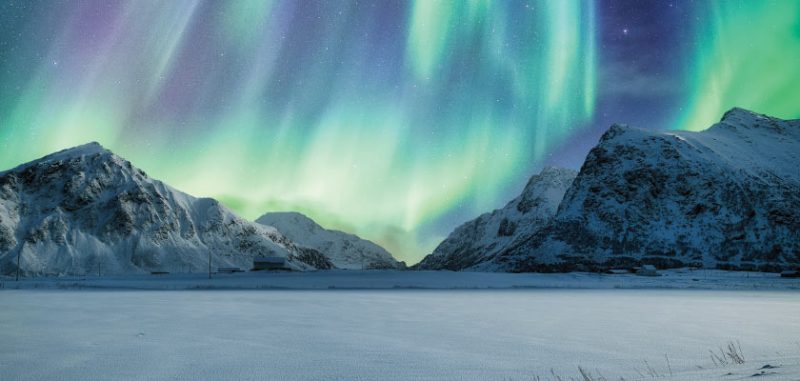
Best Time of the Year to See Northern Lights (Monthly Planner)
Trying to work out the best time of the year to see Northern Lights? In this month-by-month guide to the Aurora we share the best…

Best Place and Time to See Northern Lights 2020-2035
Want to know exactly where and when to see Northern Lights? Discover the best place and time to see Northern Lights across the globe, inc…

5 Great Short Tours to Northern Lights ICELAND
Looking for the best short tour to see Northern Lights in Iceland? In this article, we share some of the most popular short tours to…

5 Most Popular ICELAND Northern Lights Vacation Packages (2022-2023)
Considering a trip to Iceland to see the Aurora? Here we share 5 of the most popular Iceland Northern Lights vacation packages taking bookings for…
- explore europe in the cooler months
- Privacy Policy
Sign up for Newsletter
Signup for our newsletter to get notified about sales and new products. Add any text here or remove it.

- Northern Europe
- Southern Europe
- Western Europe
- Eastern Europe
40 unmissable things to do in Iceland in January

Are you planning a trip to Iceland in January? This guide details the best things to do, offers tips on how to prepare for the weather and demonstrates why you should choose to visit the country in this season!
With sunsets and sunrises that seem to take up all the daylight hours, deep frozen waterfalls hanging off the edges of cliffs and geysers exploding from deep snow-covered landscapes, adrenaline-boosting winter sports and watching the city come to life at 10:00 am while walking around, coffee in hand, Iceland in January is truly mesmerising.
In this middle of winter, it’s certainly dark and cold, but you’ll find unique cosy vibes, gorgeous winter light and a contagiously inspiring positive atmosphere, even in the darkest months of the year.
I went on a winter trip to Iceland, taking in all of the best attractions in January. Below are the best activities to enjoy in Iceland in the coldest (and one of the darkest) months of the year; and many of them are unique activities that you can ONLY do when it’s cold and dark!
Table of Contents
Things to do in Iceland in January
With temperatures averaging around or slightly below 0°C (32°F) Iceland in January may be cold, but there are plenty of things to do!
Go whale watching from the Icelandic coast, take a dip in the Blue Lagoon, go aurora chasing, explore glaciers and warm up in Reykjavik’s museums.
Northern lights boat trip
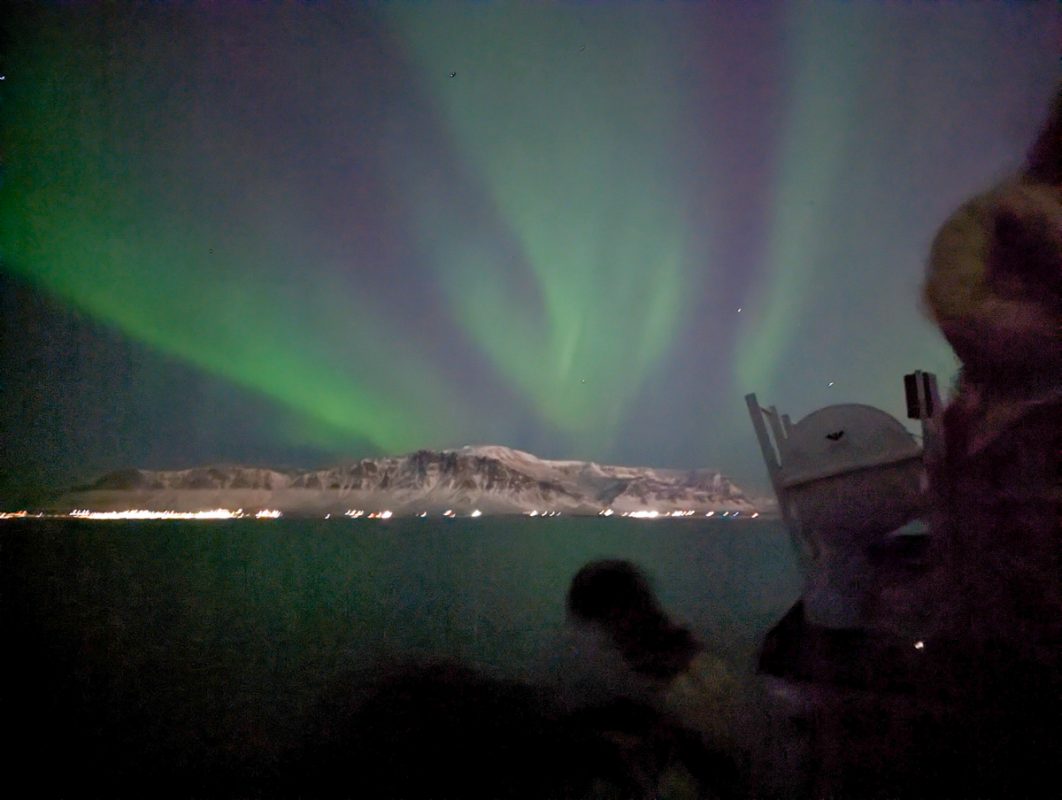
There are few phenomena as iconic to Iceland as the northern lights.
And January is one of the best months to see them!
To see the northern lights in Iceland, we did a boat tour from Reykjavik, which departed from the harbour at 9 pm.
After a short sail out of Reykjavik harbour, we saw the magical aurora borealis, green and pink flashes across the sky, and listened to the commentary from the expert skippers.
This was an amazing way to get up close and personal with nature – and January is one of the best times of year to do it!
Take a look at my full post about seeing the northern lights in Iceland in winter for more information.
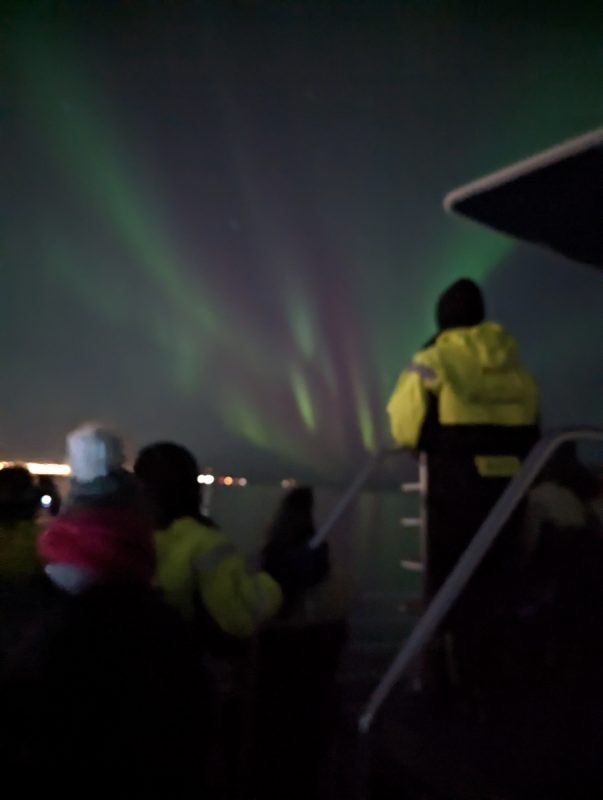
Northern lights bus tour
Of course, you don’t have to do a boat tour to see the northern lights!
The bus tours leave the capital city and drive far away from light pollution, to whatever area has the best forecast for seeing the lights.
You could head to Thingvellir National Park or in the countryside around Vik, depending on where the lights are at their brightest!
The advantage of Northern Lights bus tours is that they are slightly more flexible, so if you can’t see the lights in one area, you can drive to another.
The disadvantage is that the coaches are less comfortable than the boat, which you can move around and buy hot drinks and snacks if desired.
Golden Circle
Is the Golden Circle feasible in the cold, winter months in Iceland?
YES, it very much is – take a look at my photos!
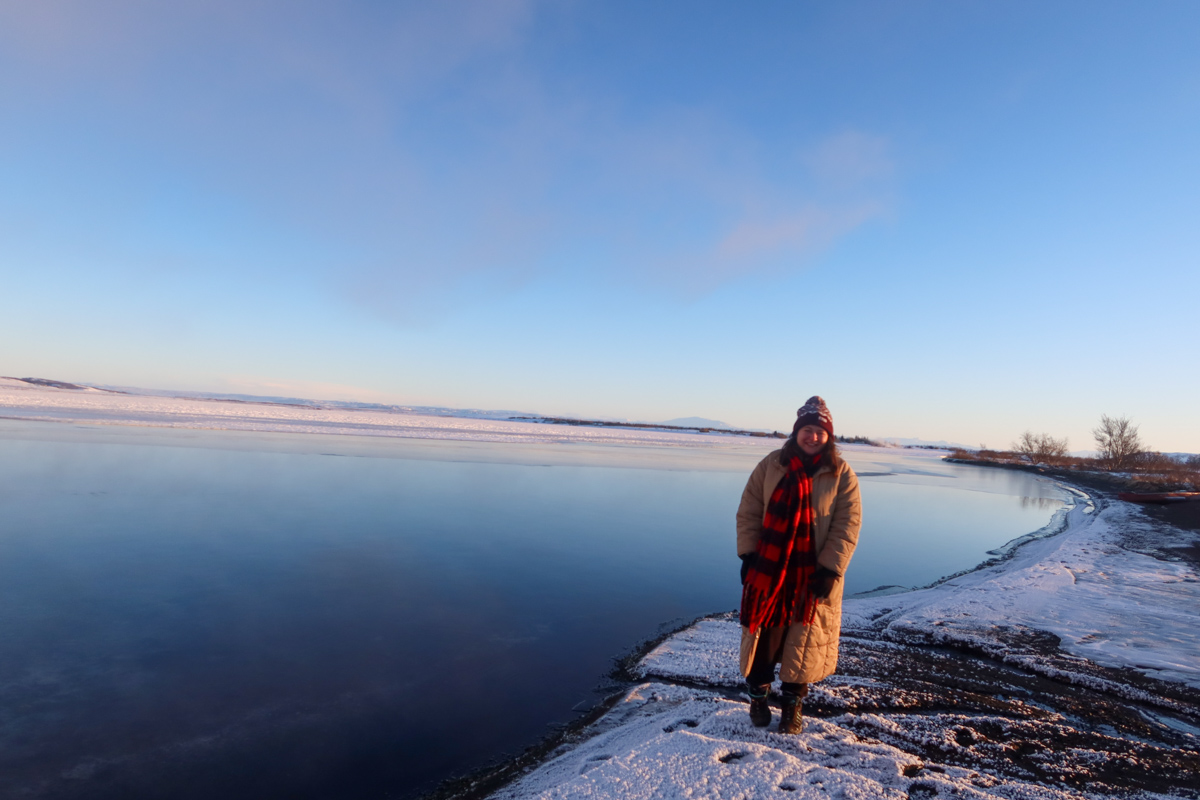
We took a tour around this popular route on our Iceland trip and loved seeing the snow-capped mountains in the background, along with taking in the frozen waterfalls and majestic geysirs.
Named so because it incorporates much of the nature that Iceland is well-known for, the Golden Circle is an easy ring route close to Reykjavik city center.
If you’re experienced in driving in the snow, you could self-drive the route; but if you have any reservations about driving in sub-zero conditions, I’d highly recommend a tour.
Our tour included bus travel, all entrance fees and a knowledgeable guide, who detailed the culture and history of the surrounding area and provided us with witty tales about the country!
Check out my full blog post about visiting the Golden Circle in Iceland in January here.
Thingvellir National Park

Technically Thingvellir National Park is on the Golden Circle – it was a stop on our tour – but this natural spot is SO mesmerizing that it’s worth a mention on this top January Iceland attractions list!
The main reason why Iceland’s landscape is so dramatic, with active volcanoes and geothermal waters, is that it straddles two tectonic plates; it’s technically partly in Europe and part in North America.
The UNESCO World Heritage Site Thingvellir National Park is the only place in the world where you can walk between two tectonic plates.
A trail spans close to the North American plate but in “no man’s land”, before climbing to the top of the plate where you can gaze over the park to the Eurasian plate in the background.

Thingvellir National Park is also a very historical place in Iceland. It was where the first meeting of the Althing, the first Viking parliament, was held.
Medieval Iceland was quite a lawless place, and while Viking sailors enjoyed coming here, settlers eventually realized that they needed to establish a government and some laws if they wanted a harmonious society.
Hence, the Althing was created – and its meeting was Thingvellir National Park! The name “Thingvellir” (which is Þingvellir in Icelandic) literally means “place of the gathering”.

In January, Thingvellir will be very cold and carpeted by a bright white blanket of snow (it’s usually much colder here than in Reykjavik, which is about 1.5 hour drive away – although snow in Reykjavik is also likely in January ).
But the snow enhances Iceland’s rugged, wonderous natural beauty – and if you visit around 4 pm in January, you’ll be graced with a spectacular sunset!
If you have a hire car and are confident in driving, you can visit Thingvellir independently, or partake in a Golden Circle tour – click here to see rates and availability.
Secret Lagoon
Secret Lagoon is a hot spring for bathing located in Iceland’s Golden Circle.
Opening back in 1891, its warm waters have long been rich with beneficial minerals, enabling relaxation and the opportunity to recharge your battery after a long and chilly day exploring!
While it’s on the Golden Circle, it’s not a stop on all Golden Circle tours – you’ll need to do a special Golden Circle and Secret Lagoon tour or self-drive.
Langjökull Glacier
The second largest ice cap in the country, Langjökull Glacier measures roughly 950 square kilometers and reaches heights up to 1450 meters high; it’s one of the largest in Europe.
Many of Iceland’s rivers and waterfalls are fed from the glacier, and it reaches up to 600m in thickness in places.
However, due to global warming, the glacier is at risk .
Doing a guided tour of the natural phenomenon will help you to understand it better and think about some of the small changes you can make to help protect this glacier and others around the world!
The best way to reach the glacier is to take a tour from Gullfoss , where you’ll be transported into an all-terrain van that’ll take you across the glacier.
There are also snowmobiling tours available – you can book a snowmobiling tour as an add-on to a Golden Circle route. Read more about that here.
Blue Lagoon

The Blue Lagoon in Iceland is a world-renowned geothermal spa.
Located in the southwestern part of Iceland, close to Kevaflik International Airport, the Blue Lagoon is known for its unique milky-blue colored water and warm temperatures that range from 37°C to 39°C (98.6°F – 102.2°F).
Its natural mineral-rich waters are said to have health benefits due to high levels of magnesium, algae and silica .
Here, you can relax in the waters, enjoy a drink at the swim-up bar, or try out their face masks. Most packages include one free drink and face mask, whereas others include dinner or even a treatment at their spa.
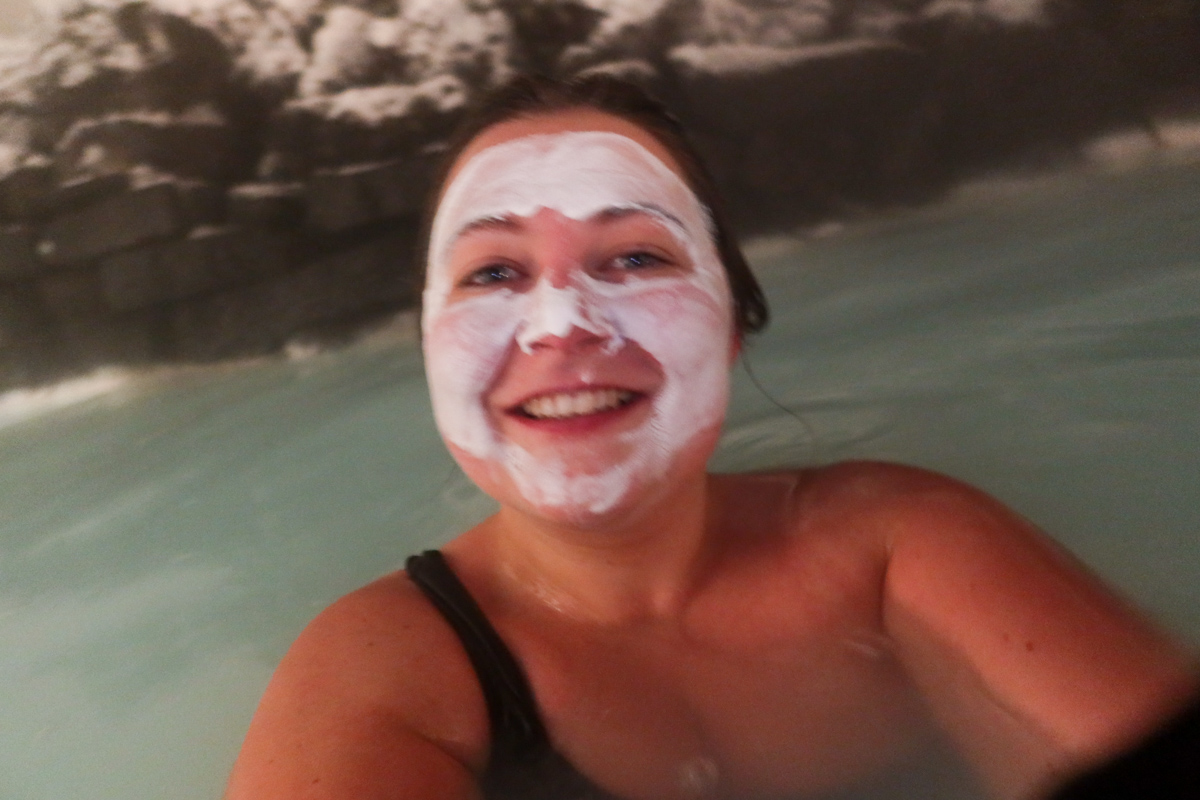
The area also provides great photo opportunities against the contrastingly stark and dark Icelandic lava fields – I recommend taking a GoPro so you can take photos without worrying about water damage.
If you aren’t renting a car, you can do a tour from Reykjavik to the Blue Lagoon that includes transport and entry (on the comfort package, which includes one drink, one face mask and the use of a towel).
Or, opt for a spa package to make use of the exclusive spa facilities. This is much more expensive, but it’s the perfect place to pamper in solitude!
If you don’t have your own vehicle, you can partake in a tour that includes round-trip transportation from Reykjavik. Click here to read more about it.
Snorkeling at Silfra
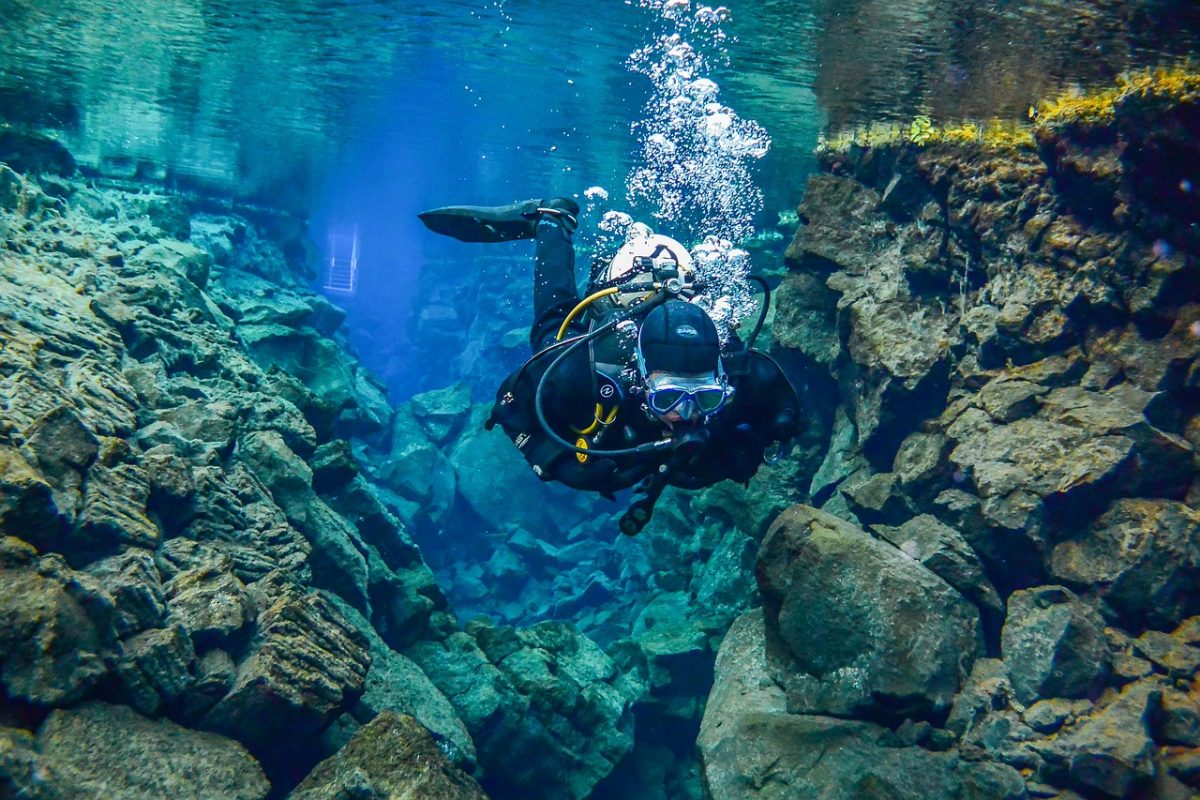
For geology enthusiasts (or anyone who loves the weird and wonderful when they travel), snorkeling at Silfra in the Thingvellir National Park is a bucket list experience.
Here, you can glide between the Eurasian and North American tectonic plates; it’s one of the world’s most awe-inspiring experiences where you don’t just observe nature, but are fully immersed in it.
But this is the winter season in Iceland – won’t it be too cold to snorkel?
Well, the water is very cold, but you’ll be kitted out with a full dry suit so you won’t (really) feel it! Enjoy a visibility of up to 250 feet and gaze at the rocky terrain of each plate.
You don’t need any certifications to do the snorkeling tour (you just need to be able to swim) as you’ll stay close to the surface at all times and breathe out of your snorkel. It’s best closer to the surface, which is why snorkeling, rather than scuba diving, is the way to see these plates!
However, your guide will be well-experienced and scuba diving certified, so you can be sure that you’re in safe hands when exploring this natural phenomenon.
A paradise looking out over the North Atlantic Ocean, Sky Lagoon is a new attraction as far as Iceland’s geothermal pools are concerned.
Like Blue Lagoon, it’s a geothermal pool, offering visitors the chance to step into the warm, crystal-clear waters and lose all their stresses as they unwind and recharge.
Famous for its seven-step spa routine which includes visiting saunas and steam rooms, this stunning lagoon is perfect for pampering, or you can just chill out, enjoy the views over the ocean and have a few drinks.
Sky Lagoon is much closer to Reykjavik than Blue Lagoon; it takes only around 15 minutes to drive there from the city center. You can access it by a tour or by self-driving.
Whale watching tour
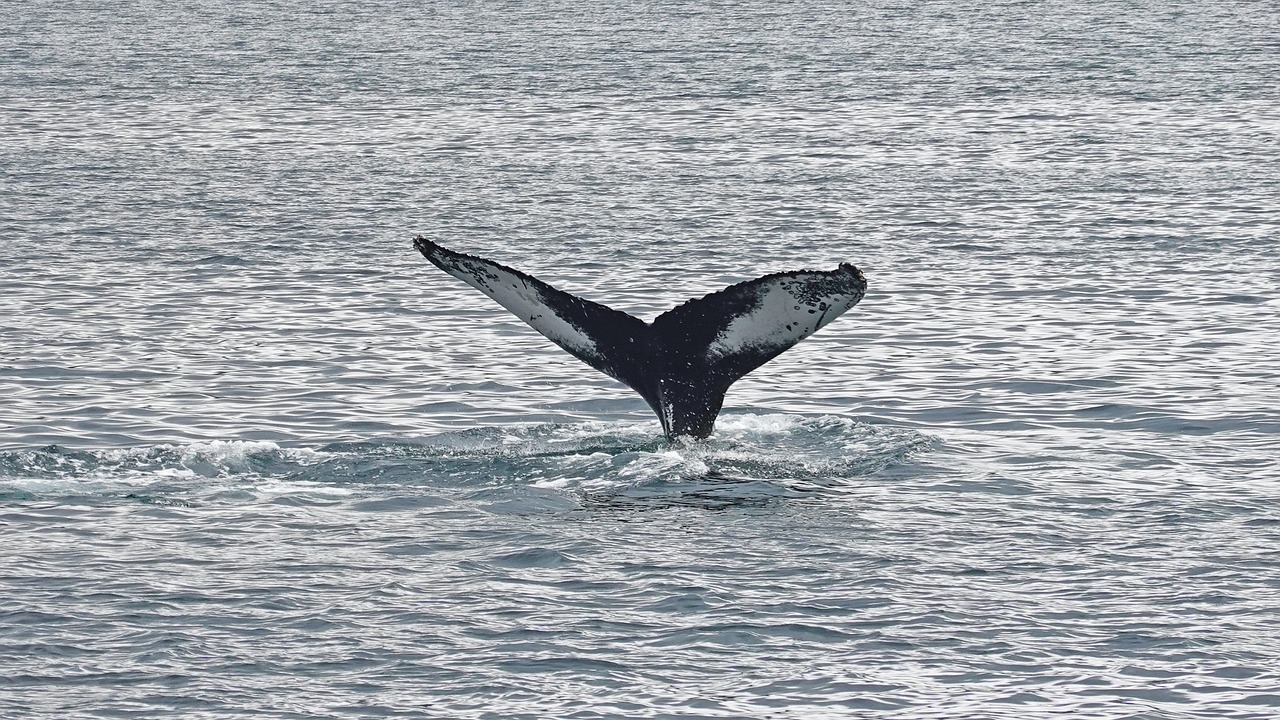
While January isn’t the height of whale watching season in Iceland (they generally tend to favour the warmer months of the year), you certainly can see the marine creatures in this month of the year.
In fact, the waters around Reykjavik harbour are generally active with marine life all year round!
This is largely because the water around the country is rich in nutrients, and many whales can deal with Arctic sea conditions.
When I did a northern lights tour, they told me how they’d found orcas and humpback whales on a whale-watching tour that very same day!
As the tours leave from Reykjavik harbour, which is close to the downtown area of the city, it’s an easy and worthwhile activity to check off your Iceland winter bucket list.
Click here to check rates and availability for whale-watching tours in Iceland.
Reykjavik free walking tour
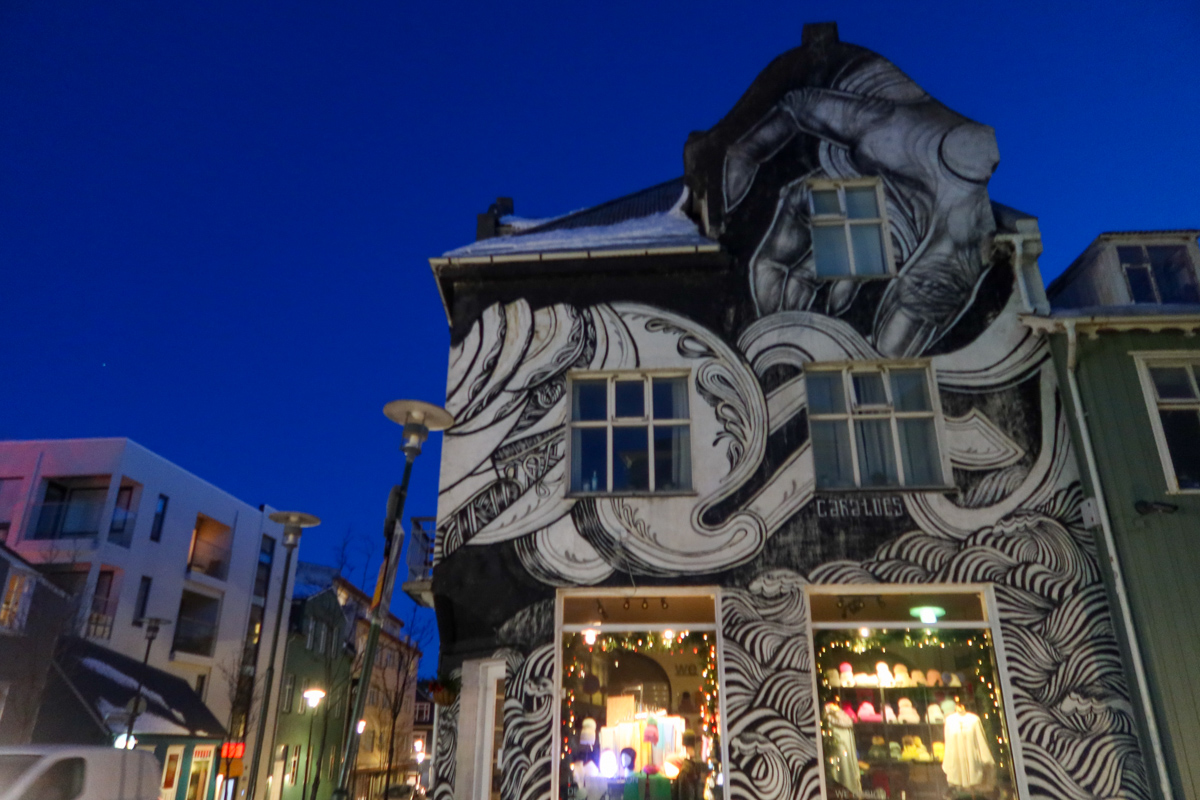
Iceland is renowned for its beautiful scenery – but downtown Reykjavik has an abundance of culture that’s definitely worth tapping into while you’re in the capital!
Reykjavik Free Walking Tour is a great way to explore the city and get an overview of the rich culture, history and modern life.
The tour begins at the world’s oldest Parliament building and takes you through the streets, enjoying quirky street art and incredible mountain scenery.
You’ll learn about Icelandic traditions, and legends and take in its spectacular architecture while getting some fresh air and enjoying the capital’s charms.
The tour is free to go on, but you are expected to tip whatever you think it’s worth at the end.
Climb to the top of the Hallgrimskirkja

Take in one of the best views of the capital by climbing to the top of Hallgrimskirkja.
Visitors can enjoy panoramic views from the church tower, including sights such as Mount Esja, Faxafloi bay and the colorful buildings of the city center.

You’ll take a lift to near the top of the building; although there are some well-maintained stairs to reach the very top.
You can also enter the interior of the church. The church itself is quite bare, but there is an impressive organ.
Sunrise at sculptures and shore walk

If all of my days started with sunrise at the sculptures and shore walk, I’d be very happy!
This route traverses from the Harpa Concert Hall across Reykjavik’s coastline.
You’ll bypass statues like the Sun Voyager , which is a ship that looks a little like a Viking vessel but was actually built as a homage to the sun in Iceland.
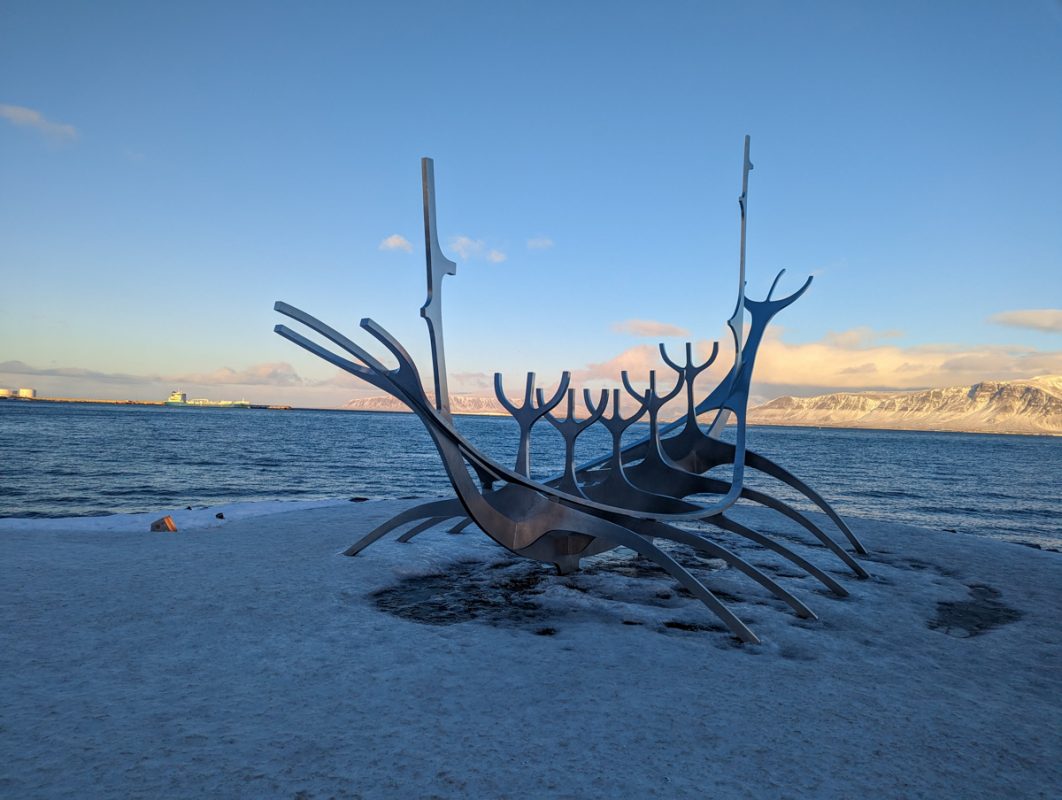
In January, the sun rises at around 10:30 am, so you don’t need to get up early at all to enjoy the start of the day here!
It can be chilly, so make sure that you wrap up with plenty of layers, including thermals and waterproof outer layers and sturdy hiking boots.
Museum hop in Reykjavik

Reykjavik is home to countless museums, perfect for people who want to experience Icelandic culture.
Some of the most popular are:
- The National Museum of Iceland : This museum details Iceland’s fascinating and unique history.
- Reykjavik Art Museum : This museum is a gallery of some of the most gorgeous Icelandic art.
- Reykjavík Maritime Museum : This museum details Iceland’s unique link to the sea around it.
- Saga Museum : If you’re interested in ancient history, the Saga Museum details all you need to know about the land’s first settlers: The Vikings!
See the wonders of Iceland at Perlan
If you want to get to know Iceland’s unique nature on a deeper level, head to Perlan.
This exhibition space combines Iceland’s different elements to offer an immersive experience for guests.
Visitors can see the projections of the northern lights (sightings are guaranteed here!), walk through a man-made ice tunnel, learn about whales at the aquarium and take in views of Reykjavik from the observation deck.
Perlan is the perfect attraction if you’re visiting in January and the weather’s not too kind – you can see all of Iceland’s best nature without stepping outdoors.
You can pre-book your tickets on Get Your Guide by clicking here.
FlyOver Iceland experience

Another ideal attraction for if you want to see Iceland’s unique landscapes without getting too cold, FlyOver Iceland takes visitors on an aerial tour of some of Iceland’s most famous and stunning destinations.
With immersive 4K resolution images, full motion seats and incredible special effects, this experience makes you feel like you are actually flying over the sites!
Guests have the chance to (virtually) witness some of the largest waterfalls in Europe, active volcanoes, glaciers and majestic lagoons; some areas that are even inaccessible in the summer season.
In fact, Icelandic locals have visited FlyOver Iceland and have come out crying because they didn’t know that their country was this beautiful!
It’s recommended to book your FlyOver Iceland tickets before visiting to ensure that you get the viewing that you want. You can prebook on Get Your Guide.
Laugardalslaug

Sitting a mere 15 minute walk from Reykjavik city center, Laugardalslaug is a local spa complex with a heated swimming pool with hot tubs alongside, a sauna and a steam room.
It’s a lot quieter than the Blue Lagoon and Sky Lagoon and has a much more local feel.
I visited it on a dark morning, doing a few lengths of the outdoor swimming pool and then warming up in one of the hot tubs alongside.
There were lots of local people here getting their morning exercise, and I enjoyed partaking in a traditional Icelandic ritual!
Check out Reykjavik’s street art
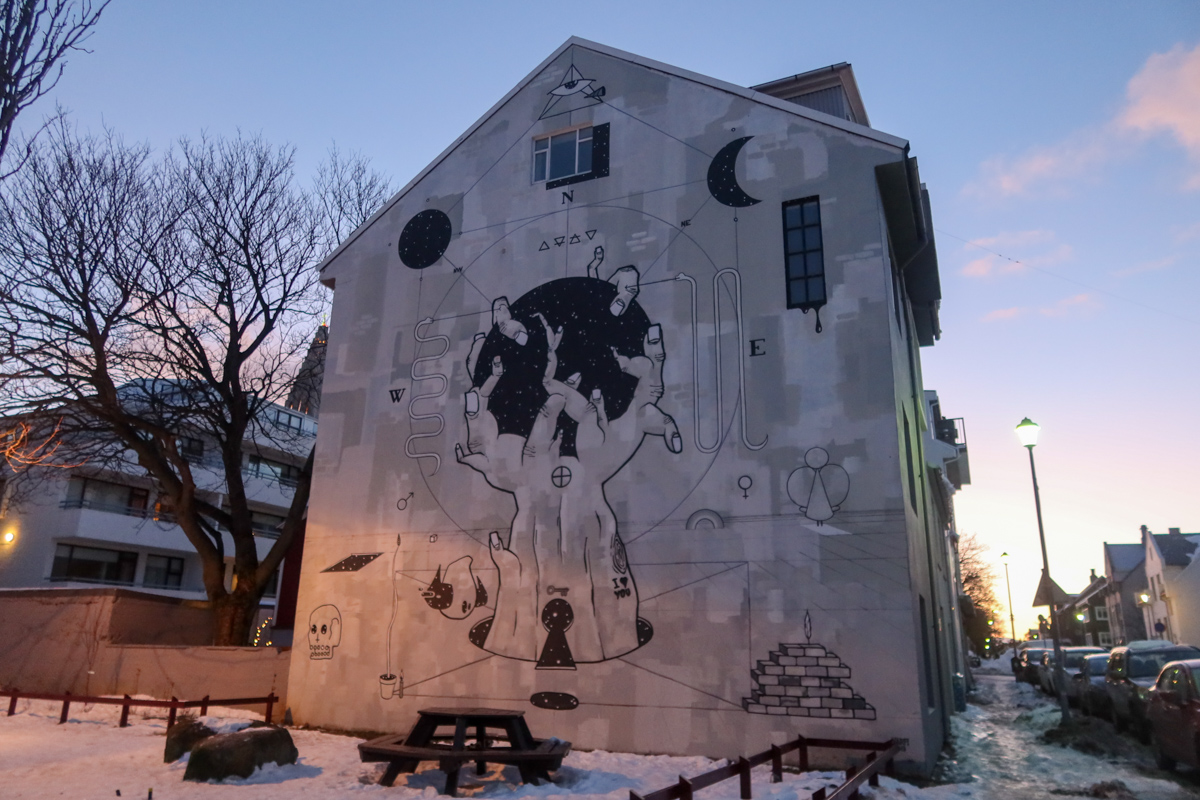
Reykjavik’s street art is unique and vibrant, thanks to the fact that many artists moved here after being inspired by Iceland’s unique natural scenes!
Walk around the city center (ideally with a steaming hot cup of coffee as the sun comes up!) and enjoy giant murals like Ode to Mother on the corner of Laugavegur, which took the name from a song by local band Ylja.
Many of the murals come and go; so even if you’ve visited Iceland previously, you’ll probably find something new in this outdoor art gallery!
Dill Restaurant in Reykjavik
Dill Restaurant in Reykjavik offers a unique dining experience, with modern Nordic cuisine fused with Icelandic ingredients.
With chef Gunnar Karl Gíslason at the helm, Dill serves up delicious dishes that are both classical and quirky yet always fresh and delectable.
The restaurant’s welcoming atmosphere matches the freshness of its food; it’s decorated in neutral tones and organic textures and has an airy open layout.
Dill serves up fresh fish and meat dishes and a few Icelandic vegetarian mains; unfortunately, they cannot accommodate vegan or dairy-free diets due to cross-contamination.
Reynisfjara black sand beach
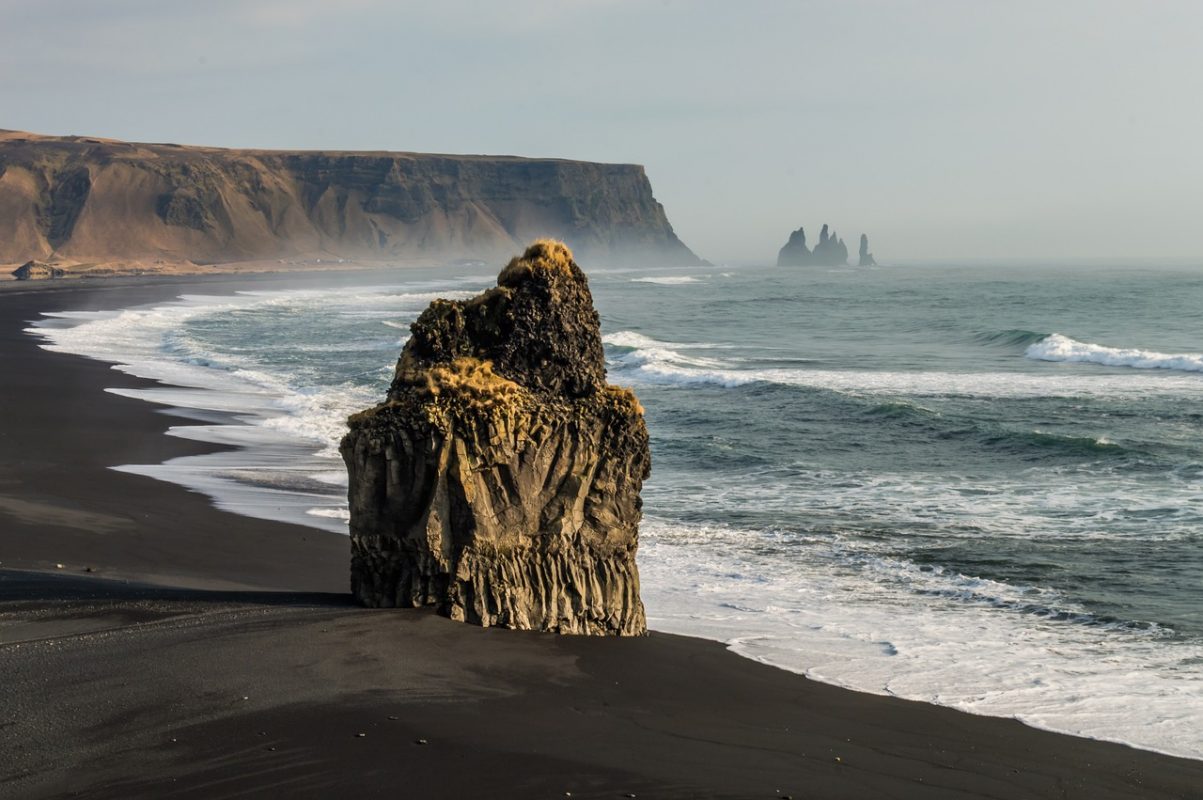
Reynisfjara black sand beach is a majestic and unique destination located on the south coast of Iceland.
Reynisfjara is a stunning, unspoiled natural landscape, with huge cliffs towering over the crashing waves, basalt rocks protruding through the black sand beach, and sea stacks just offshore.
You can visit it independently or as part of a tour around the highlights of South Iceland.
Plus, if you visit in winter, you might be lucky enough to see the contrast of black sand with white snow.
Seljalandsfoss waterfall

Seljalandsfoss waterfall is one of the best-known waterfalls in the country; this is largely due to its position next to the Ring Road in southern Iceland.
This spectacular waterfall majestically plummets off the edge of the towering cliffs, giving the image of giant icicles sitting in the midst of fresh white snow.
In warmer seasons, you can walk behind this waterfall, but you can’t during winter due to the risk of falling ice.
It’s possible to visit Seljandsfoss independently or as part of a South Iceland tour – click here to read more about one.
Skoagfoss waterfall
Skogafoss is one of Iceland’s most impressive waterfalls, plummeting down the cliffs between two headlands.
In winter, the whole area is frosty, offering a picture-perfect backdrop for your January photos!
This spectacular waterfall cascades over sixty feet (20 meters) into its pools.
Visitors can follow the wooden stairway from the waterfall’s base to view this magnificent landscape from above!
This is also part of this South Iceland tour.
Day trip to Snaefellsnes Peninsula

Snaefellsnes Peninsula is a unique and breathtaking slice of Icelandic nature, frequently known as “Iceland in miniature”. It’s also one of the best day trips from Reykjavik in winter !
Its dramatic landscape boasts glaciers, lava fields, black sand beaches and hundreds of adorable Icelandic ponies!
The most famous is Kirkjufell, which is otherwise called “church mountain” and is a distinctly-shaped peak with a waterfall in front. This is one of the most photographed destinations in Iceland, and it’s beautiful throughout the seasons!
You can take an all-day tour from Reykjavik, where you’ll hike through the glacial valleys, explore some of the local historical sites and bask in the magnificent views all around this part of Iceland.
Celebrate New Year’s in Reykjavik
If you’re visiting Iceland at the end of December into January, you’re here for new year’s!
The end of the festive season sees a massive party in Reykjavik. Icelanders generally go for dinner in the early evening, then head out to a bonfire, before going back inside and watching New Year’s shows (it’s a little cold to stay outside for too long!).
They then grace the streets again at midnight for fireworks. Wherever you are in Reykjavik, you’ll see the glorious fireworks in the sky!
Dark Days Music Festival
A musical extravaganza taking place annually in Reykjavik at the end of January, Dark Days Music Festival is one of the most atmospheric music events on the continent – despite the minimal hours of sunlight!
The festival, which began in the 1980s, brings together some of the world’s most talented electronic, house, techno and urban music producers from across Europe and North America.
Dark Days Music Festival, which is set mainly in the Harpa Concert Hall in downtown Reykjavik, is dedicated to showcasing fresh underground artists, whilst also featuring well-known DJs for its devoted followers.
As the name suggests, most of the festival takes place in the dark (and cold!), but you’ll be instantly warmed by the festive cheer and atmosphere!
Þorrablot is a midwinter celebration that began as a sacrifice to the Norse god, Þorri (pronouched Thorri).
Historically, people would gather and eat traditional food, sacrificing some to Þorri with the hope that it would bring them luck in subsequent years.
The festival was abolished when Christianity took over Iceland, but it was resurrected after WW2. People wanted to gather to celebrate the month and eat foods that were going out of fashion in an increasingly cosmopolitan Reykjavik.
So what are these food? Things like rotten shark, sour ram’s testicles and boiled sheep’s head all make their way onto a Þorrablot menu!
That being said, if you do secure an invite to a Þorrablot party and don’t fancy the aforementioned dishes, don’t worry – nowadays plainer dishes like mashed potato are usually also on the menu.
This festival takes place from January 20th to February 18th so if you’re visiting Iceland in the latter part of the month you should have plenty of time to find an invite… if you dare!
If you don’t get invited to a party, you can find Þorrablot-inspired menus in restaurants around the country – one is Þrír Frakkar hjá Úlfari in central Reykjavik.
Þrettándinn
Þrettándinn is the ultimate festive season closing party!
It falls on 6th January and marks the halfway point of winter and the end of the Christmas season.
According to tradition, the day is believed to bring luck and fertility, so many people celebrate by lighting bonfires and hosting parties with traditional foods like fermented shark, porridge, and hot pots with sheep heads.
As part of the celebration, singles will search for their perfect mate at the Þrettándinn dances.
Celebrating this unique holiday also carries deep symbolism—it reminds people that even on bitterly cold winter days, hope always remains that spring will soon come again.
Hike in Katla ice cave
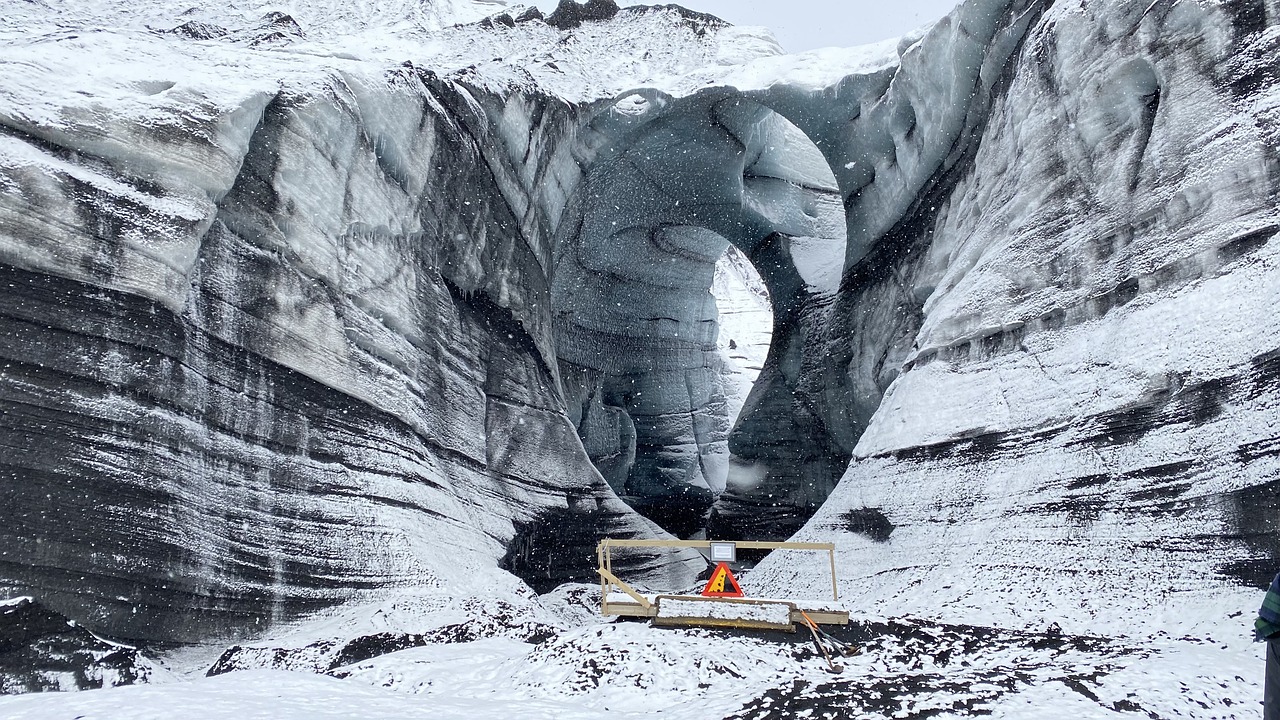
Hiking in Katla ice cave is perhaps the best winter activity in Iceland; so it’s something that you absolutely MUST do if you’re here in January!
Located in South Iceland ( day trip-able from Reykjavik or Vik ), Katla is a natural structure (although it looks completely out of this world!) on the Kötlujökull Glacier.
Created from fire and ice, the cave extends through the glacier and is lined with ash, which has been collected over years of volcanic eruptions.
Taking a step into this cave is a quintessential Icelandic experience, and you’ll also get a valuable geology lesson from your guide!
See Diamond Beach with sand and ice!
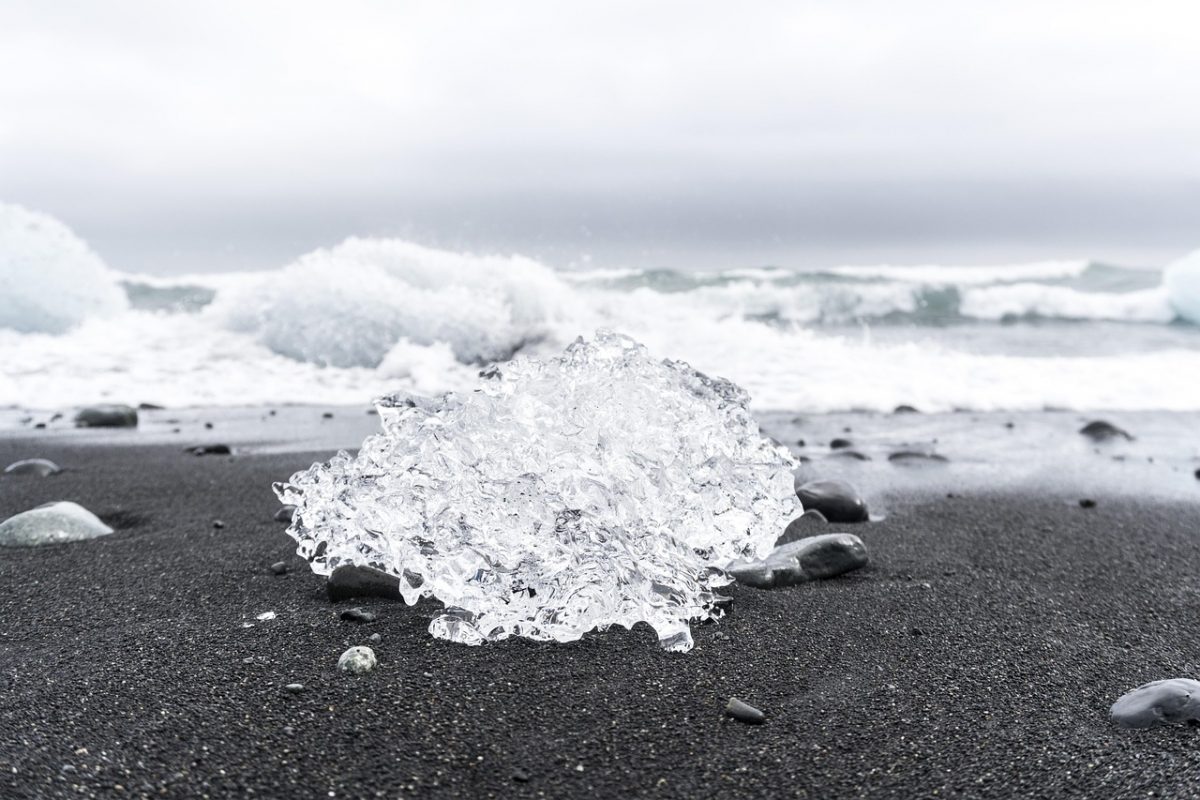
Diamond Beach in winter is absolutely breathtaking.
Located on the south coast of Iceland, this beach draws tourists throughout the year for its black sand and sparkling ice – in fact, its jewel-like appearance is how the beach got its name!
Surrounded by towering glaciers and ice formations, Diamond Beach truly comes alive during winter when snow blankets the landscape and there are countless ice structures on the coastline.
It’s rare to see snow and beach together – this is something that we marveled at while we were here – but at Diamond Beach, snow completely enhances the coastline.
Hang out in the fun village of Vik
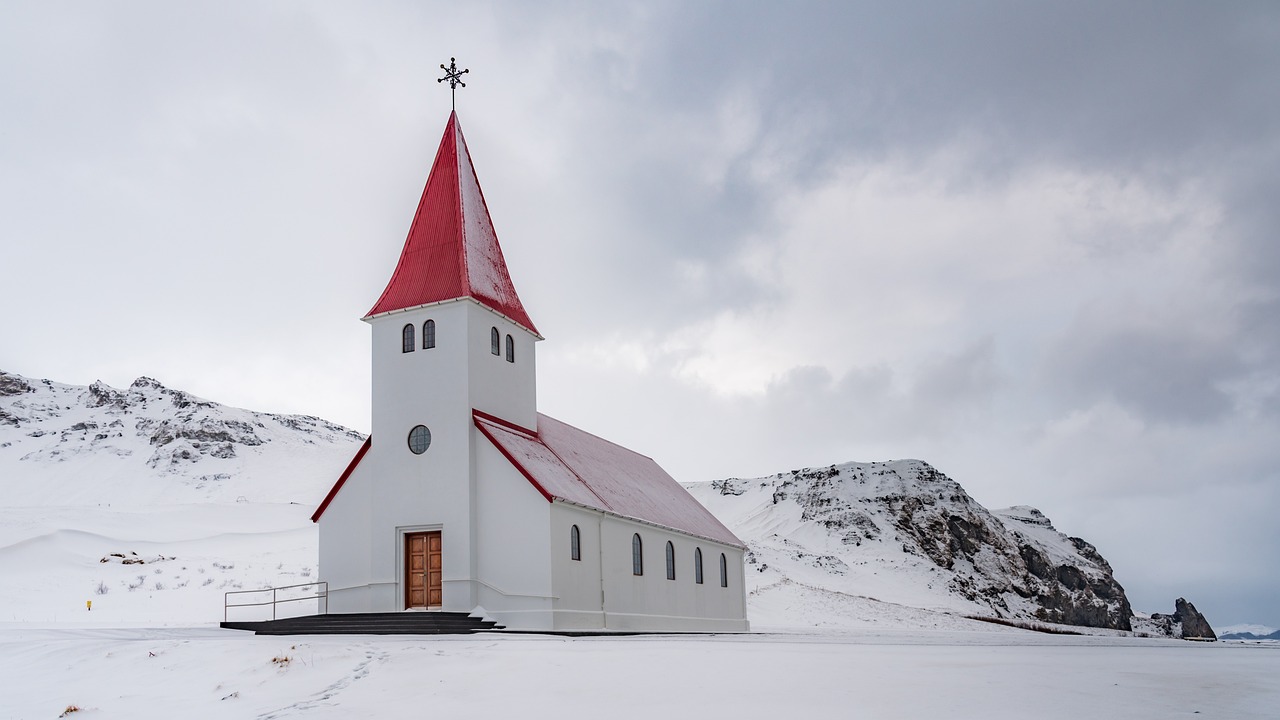
The southernmost village in Iceland, Vik is renowned for its atmospheric charm and stunning natural beauty, incorporating rugged and sweeping coastlines, glaciers, volcanoes, lava fields and black sand beaches.
Vik is known as one of the best spots for whale watching off the Icelandic coast – even in January – and travelers can explore nearby glaciers, caves, and waterfalls among other attractions here.
Foodie adventure walking tour in Reykjavik
Reykjavik’s a premier destination for foodies from around the world, with Icelandic specials including fresh fish and lamb – most of Iceland’s cuisine is meat or fish-based due to the lack of land for farming.
Take a foodie adventure walking tour to try out these delicious cuisines, with stops at some of the country’s best eateries.
Fagradalsfjall volcano
If you fancy hiking in Iceland, head to Fagradalsfjall volcano on a hiking tour.
The view from the top of the volcano is spectacular and the route is both easy and safe, with no technical skills required.
You’ll probably experience some snow in January, but if you go with a tour guide you’ll tackle the paths in a safe and effective way.
From the summit, you can see over half of Reykjavik, including its snowy mountains as well as stunning geothermal areas.
The hike itself is about two miles long, making it relatively short but still doable for anyone looking for a challenging day tour!
The Meradalir volcano hiking tour
The Meradalir volcano hiking tour allows adventurers to experience the breathtaking views of Iceland’s bubbling craters and stair-stepped valley walls.
Located in the majestic northwestern Valley, this hike takes you and your group through a landscape of raw and untouched nature.
The tour provides education on volcanic geology and includes plenty of chances to learn about Icelandic folklore.
Have a drink in Reykjavik’s magic ice bar
Reykjavik’s Magic Ice Bar is one of the best places to visit in the city centre.
Sitting close to the Hallgrimskirkja church, the ice bar is in the heart of the city; there are also branches in other Nordic countries.
Inside, you can enjoy drinks served in authentic Icelandic glacially-sourced glasses at sub-arctic temperatures.
It’s called the “Magic Ice Bar” and it boasts a variety of sculptures made from blocks of clear crystal ice, underlit with calm blue lighting.
From delicious cocktails and craft beers to an atmosphere so unique it just has to be experienced to be believed, Reykjavik’s Magic Ice Bar is the perfect way to take in the charm that is Iceland in January!
Explore the Raufarhólshellir Lava Tunnel
Located on the Reykjanes Peninsula, a peninsula sitting out from the side of Iceland, the Raufarhólshellir Lava Tunnel is a geological wonder.
The majestic tunnel was created by an ice-covered lava flow that traveled from the volcanoes many thousands of years ago. Nowadays, it is home to one of Iceland’s largest lava tubes.
When you visit this beautiful site on a tour like this one , you’ll experience the mesmerizing magnificence of this natural beauty firsthand, particularly the enormous sculpted rocks and exhilarating hallways filled with unique stalactites.
Hike on Skaftafell glacier
If you’re visiting south Iceland in the winter, don’t miss exploring the Skaftafell glacier!
From walking along towering ice columns and rugged crevasses to gazing in awe at massive glacial walls, exploring the glacier means you’ll venture into a world of multiple colorful and unique fragments of nature.
You can do a guided tour with a knowledgeable guide; which will offer an educational experience about how geology has created this dramatic environment.
Jokulsarlon glacier lagoon
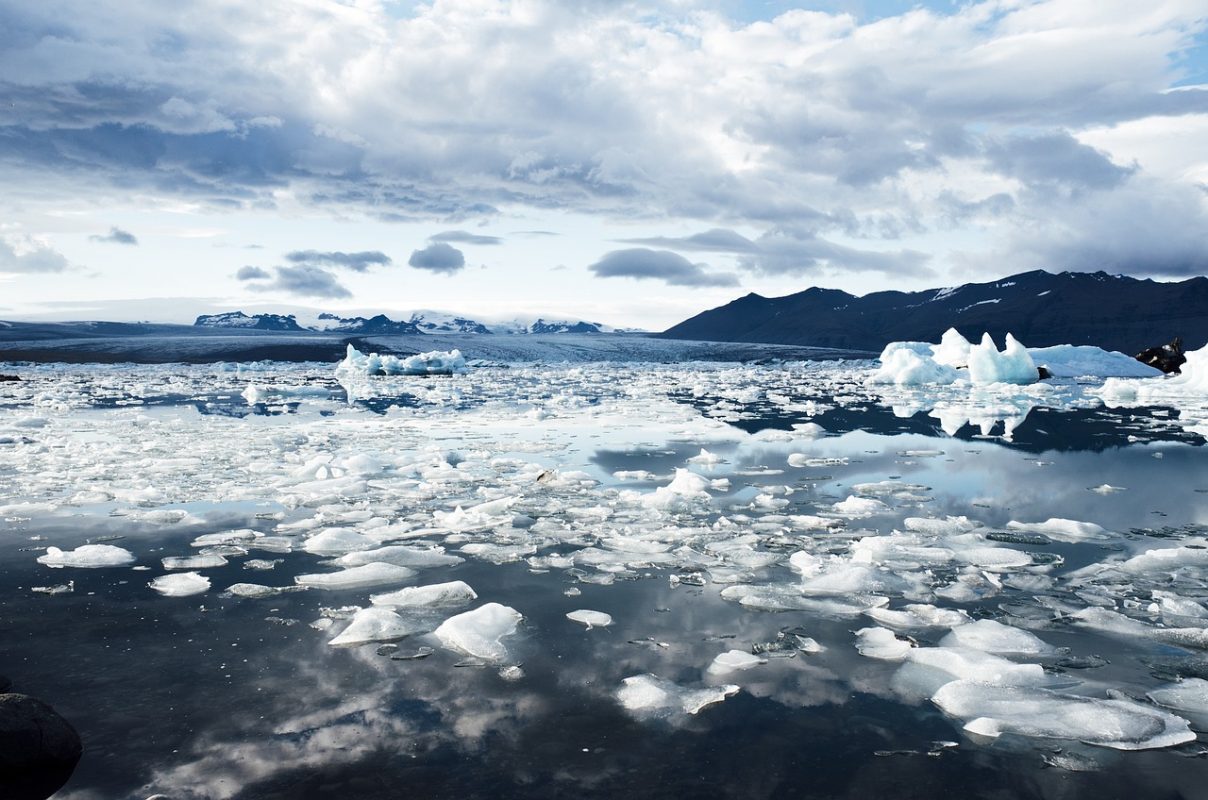
Jokulsarlon Glacier Lagoon is an iconic landmark in Iceland renowned for its beauty and prime location.
Situated near the edge of Vatnajökull National Park, it is one the best places to visit in Iceland in January because was created by melting glacial ice from Europe’s largest glacier, Vatnajökull, which towers some 8,100 feet above sea level.
A few decades ago Jokulsarlon was home to just a few floating icebergs but today more than 200 icebergs float on the lagoon.
This gives visitors an amazing view of turquoise water and spectacular blocks of ice!
This is a constantly changing landscape, largely due to the fact that glaciers are sadly disappearing. However, it remains one of the best places to visit in the Icelandic winter!
Click here to read more about a tour of the Jokulsarlon Glacier Lagoon.
Skiing and snowboarding in Iceland
While Iceland isn’t one of the most famous skiing destinations in Europe (it certainly has the weather for it, but it doesn’t have enough towering mountains!), there are a few slopes where you can try out the sport!
Bláfjöll is one of the most accessible places to ski in Iceland; it’s only 25 minutes away from the city centre. With 14 lifts, it has a variety of slopes for both downhill and cross-country skiing.
It’s not able to open every day (it depends on the amount of snow and wind) but as it’s so easy to access from Reykjavik, it’s definitely worth checking the opening times and status if you’re a keen skier!
There are also a few skiing areas in North Iceland , which see colder weather than the Reykjavik area. These ski slopes are open from November to May! You can see more information about the resorts here .
What’s Iceland like in January?
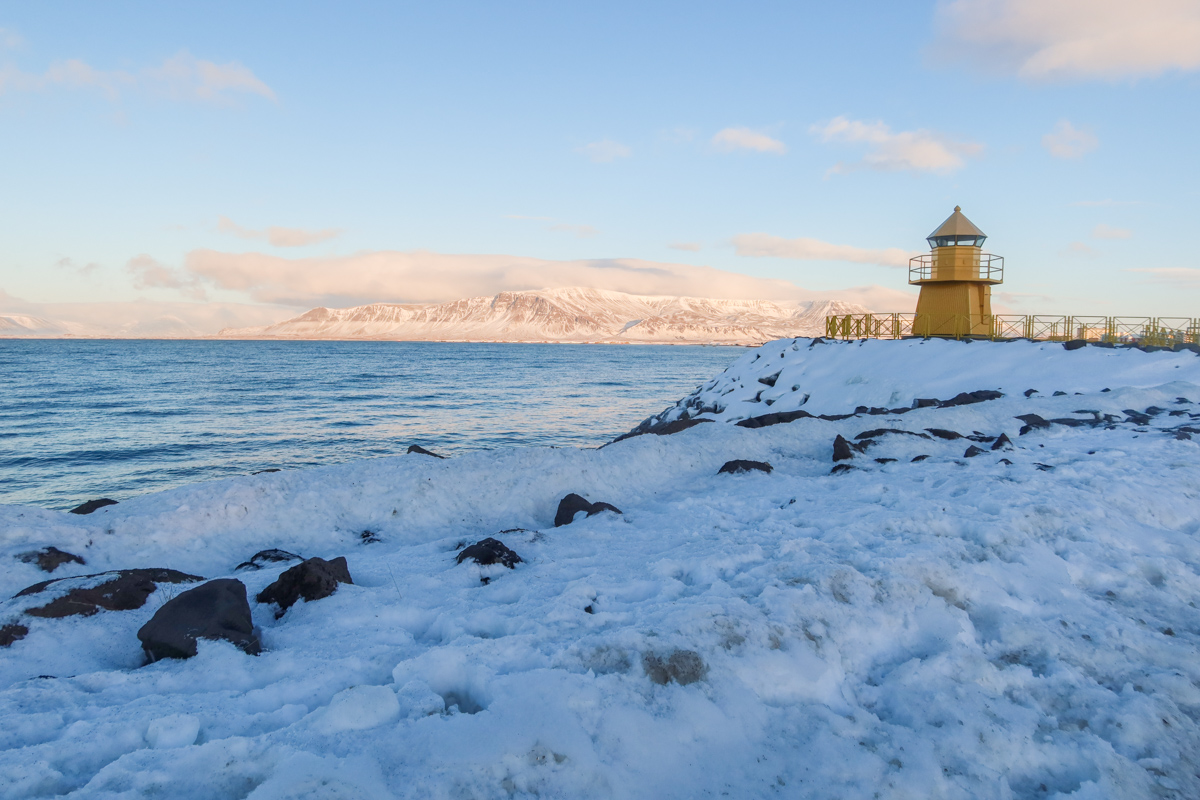
January in Iceland is often snowy and windswept, but its beauty is remarkable.
There are up to 20 hours of darkness each day, but with sunrises and sunsets stretching over 90 minutes each and the bright moonlight dancing off the snow, it feels like a true winter wonderland.
January is an ideal time to see the Northern Lights, with long hours of darkness making them more visible.
Plus, you can take a stroll around Reykjavik’s city center, enjoying the charm of the city as it gradually wakes up before you.
Weather in Iceland in January

Even though this is the middle of winter, temperatures remain quite mild due to its coastal location.
In Reykjavik in winter , temperatures usually hover around 5°C – -5°C (32°F-37°F) – although, when I was there, the temperatures plummeted to -10°C/ 14°F!
In Thingviller National Park, the temperatures reached as low as -18°C; although we did have sunny weather for most of the time.
It can be sunny and brisk, but you might also experience light snow, snowstorms, drizzle (if the weather’s above freezing) or torrential rain!
So expect it to be cold, but otherwise, expect the unexpected.
If you’re planning on driving, there will likely be icy roads and maybe even some road closures. If you aren’t comfortable driving in icy conditions, I highly recommend doing guided tours instead .
Make sure that you check the weather forecast before heading to Iceland so you can pack adequately!
FAQs about visiting Iceland in January
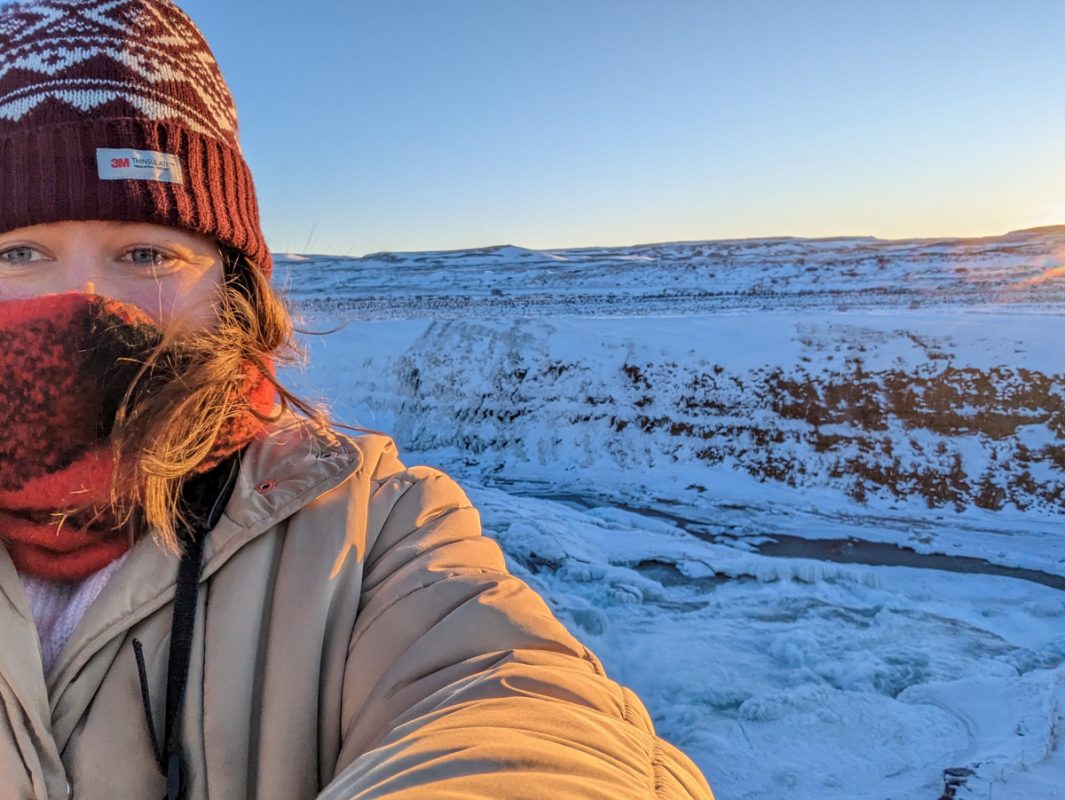
Is Iceland cold in January?
Yes, Iceland is very cold in January.
Temperatures range from 5°C to -20°C; it’s usually milder in the city, but can be colder in the interior.
The wind can make the temperatures feel even colder, and you might experience snow blizzards, drizzle or even torrential rain in January!
If you’re wondering “ when does it snow in Iceland ?” – you’re very likely to encounter it in January, although if it’s particularly warm in Reykjavik the city itself might be snow-free.
What clothes should I wear in Iceland in January?
If you’re visiting Iceland in January, bring heavy, warm clothing. It’s best to pack layered outfits such as thermals, long-sleeved shirts, sweaters, scarves, gloves, waterproof pants, and a good warm coat or ski jacket. Wear insulated shoes with good traction for walking and hiking on icy trails.
How much daylight does Iceland get in January?
Iceland gets around for hours of daylight at the start of January. This increases dramatically throughout the month, with up to seven hours of daylight at the end of the month. It’s worth visiting even in the darkest days, due to the spectacular sunsets and darkness-themed activities!
Can you see whales in Iceland in January?
You can see whales in Iceland in January; some humpback whales stay in the waters all year round, and you might also find minke whales and killer whales. You can see them on a whale-watching tour that departs from Reykjavik harbor.
Is it dark in Iceland in January?
Yes, it’s dark for much of the day in Iceland in January – although you’ll experience more light toward the end of the month. However, the festive lights are very atmospheric, and if you devote your hours of daylight to seeing Iceland’s natural attractions, you’ll have a very worthwhile trip!
What is Iceland like in January?
Iceland in January is synonymous with cold weather and dark days, but it’s worth visiting to experience this unique phenomenon and observe local life! The country is one of the happiest in the world, and when visiting Iceland in January you’ll experience how to be content even in the darkest times.
Does it get light in Iceland in January?
Yes, it gets light in Iceland for around four hours at the start of January, and seven hours at the end. There is usually still enough daylight to enjoy Iceland’s best attractions, especially as it stays quite light after the sun sets.
Is it worth going to Iceland in January?
It’s definitely worth visiting Iceland in January! You’ll experience a true winter wonderland, with snow spanning the city center and surroundings, dark skies where you can spot the northern lights and have the chance to explore glaciers and ice caves. Iceland in winter is a whole other world!
How cold is Iceland in January?
Icelandic weather can be quite unpredictable in January. It usually snows (if not in Reykjavik then definitely in the inland areas!), and temperatures can plummet to -10°C (14°F) on the coldest days in Reykjavik, although it’s usually around 0°C (32°F). Inland, it’s usually much colder.
Can you see northern lights in Iceland in January?
Yes, January is one of the best times of year to see the northern lights in Iceland; the lights are at their most vivid when the sky is completely dark. You can see them on a boat tour from Reykjavik or in many other locations.
Is Iceland snowy in January?
Iceland can be very snowy in January; it was when I was there! Temperatures are usually below freezing, although snowfall doesn’t happen too frequently. In warmer years, there might be no snow in Reykjavik, but you’ll always find it in the country’s interior.
Where should I stay in Iceland in January?
In the winter months, I’d recommend basing in Reykjavik, so you’re close to the city’s many all-season attractions and can do day trips from the capital. You could book an Iceland Air package holiday ( see my full review here ) or reserve flights and accommodation independently – we stayed at Reykjavik Lights, here’s my full review of the hotel .
What should I pack for Iceland in January?
Here are a few suggested things to pack for Iceland in January :
- heavy ski jacket and salopettes
- thick socks
- waterproof hiking boots
- waterproof gloves
- warm hat and scarf
- good camera
- power banks
- a thermal flask
- lip balm and moisturizer
- a reusable water bottle
Are you ready to visit Iceland in January?

If you don’t let cold temperatures put you off, all of these things to do in Iceland in January can be incredibly rewarding.
Take in the natural wonders of the Golden Circle, look out for solar activity on a northern lights tour or even partake in a glacier hike to take in one of the true wonders of Icelandic nature; all of these and more are waiting for you on a January trip to Iceland!
Claire Martin
Claire is an expert in exploring Europe in the winter! She's from the UK and has been to over 20 countries on the continent in the winter season. She loves every bit of Europe in the cooler months, including finding winter sunshine in Spain, skiing in the Alps and the charm of the Nordic countries in the festive season.
Leave a Reply Cancel reply
Your email address will not be published. Required fields are marked *
Save my name, email, and website in this browser for the next time I comment.
- Search Please fill out this field.
- Manage Your Subscription
- Give a Gift Subscription
- Newsletters
- Sweepstakes
- Destinations
These Are the Best Times to Visit Iceland
Here are the best times to visit Iceland for ideal weather, fewer crowds, and more.
:max_bytes(150000):strip_icc():format(webp)/Brandon-Presser-97a4675f1bb3487b88f06e5e2234eac6.jpeg)
Elizabeth Rhodes is a special projects editor at Travel + Leisure , covering everything from luxury hotels to theme parks to must-pack travel products. Originally from South Carolina, Elizabeth moved to New York City from London, where she started her career as a travel blogger and writer.
:max_bytes(150000):strip_icc():format(webp)/elizabeth-rhodes-25083778bc654f69b30ce8417affc82c.jpg)
Over the last decade, Iceland has become one of Europe's "it" destinations thanks to its ethereal — and highly photogenic — landscapes featuring ancient glaciers and rugged fjords.
Before you book your flight to this popular island nation, you'll want to think about everything you want to see and do on your trip because the time of year can determine what's available. Some attractions, like Iceland's famous hot springs , are open all year, while natural phenomena like the northern lights and midnight sun are best viewed during specific months. Here's a breakdown of the tourist seasons in Iceland:
- High Seasons: June to August and late December
- Shoulder Seasons: September to October and May
- Low Season: November to April, excluding holidays
Read on to learn about the best time to visit Iceland for whale watching, northern lights spotting, and more.
Irjaliina Paavonpera/Travel + Leisure
Best Times to Visit Iceland for Smaller Crowds
The busiest months in Iceland are June, July, and August, when most natural attractions are open and easily accessible. Iceland can stay relatively warm through the first week of October, so planning a September visit can be ideal since most crowds have thinned as children return to school. May, too, provides ample daylight for sightseeing, warmer temperatures, and fewer crowds.
The off-season between November and April is ideal for those looking to escape the hordes of tourists, as long as you don't mind the dark (by mid-winter, expect only five or six hours of daylight). Though some roads are closed, it's a glorious time to enjoy hot springs, backcountry skiing, and tours by snowmobile or jeep. You'll also have a better chance of spotting the northern lights. Tourism tends to pick up again during the holiday season, so avoid December if you're looking for a crowd-free vacation.
Courtesy of Visit Iceland
Best Times to Visit Iceland for Good Weather
During the summer months — July and August — the temperature in Iceland hovers around 50 to 55 degrees Fahrenheit, making it a popular time to visit. And June, with its 24 hours of daylight, sees just about as many tourists as the peak of summer. But even during this season, rain and intense wind are not uncommon. The island's fickle climate often means you can experience all four seasons in a single day.
The weather remains pleasant in September, with temperatures between 43 and 52 degrees Fahrenheit. May is similar, but if you're keen on exploring some of the more remote hills and fjords, it might not be the best time to visit, as some roads remain closed while they thaw from winter's snowy cover. For serious hikers, the best time to visit Iceland is during the summer, when all the mountain roads and famous trails are open and accessible.
Best Times to Visit Iceland for Lower Prices
Getting to Iceland can be relatively affordable, especially compared to other European destinations. Travelers from the United States and Europe frequently find flight deals — keep an eye out for sales on Icelandair and low-cost airline Play to save even more on your journey.
Accommodations, tours, attractions, and meals can be pretty pricey throughout the year, but you might be able to save money by visiting during the off-season, which is typically late fall through early spring, excluding December. Summer is usually the most crowded and expensive time to visit.
Best Time to Visit Iceland for the Northern Lights
You'll need three essential factors to see the aurora borealis: darkness, clear conditions, and a surge in solar activity. The northern lights are often elusive and can easily be marred by transient clouds. To avoid disappointment, travelers should never plan their trip to Iceland solely for the northern lights because the island's weather is too capricious (statistically, there are more clear nights in Yellowknife, Canada , for example.) The best way to optimize your chances of seeing the northern lights in Iceland is by visiting from mid-October through March, when you have extended hours of darkness, and by getting out into the countryside to reduce ambient light pollution.
Best Time to Visit Iceland for Whale Watching
According to Icelandic marine biologist Edda Elísabet Magnúsdóttir, the peak months to go whale watching in Iceland are June and July. During the summer, Reykjavík sees higher numbers of minke whales and dolphins, while orcas congregate in West Iceland along the Snaefellsnes peninsula during the first half of the year.
In northern Iceland, you'll have a wider window to enjoy visits from humpbacks, minkes, and dolphins, which ply the Atlantic from May to August; a few humpbacks even stick around until the end of the year. Blue whales pass through in the summer, too. For best results, head to the charming small town of Húsavík , where you can spot more than 20 species of whales on boat tours that leave from the harbor.
Best Time to Visit Iceland's Hot Springs
Hot springs are intrinsic to Icelandic culture for social as well as wellness benefits. Reykjavík's public pools are open year-round (and are especially invigorating during the dead of winter), but Iceland also has hundreds of hidden "hot pots" that tap directly into the geothermal activity under its lava-ridden surface.
Expert Icelandic mountaineer and cofounder of Midgard Adventure , Sigurdur Bjarni Sveinsson, offers the following advice for hot water hunters: "Check them out during September or, even better, the first half of October, when they're all still accessible by mountain road, but the crowds of tourists have significantly died down."
For travelers who want to visit the Blue Lagoon , the most famous geothermal spa, the best time to visit is during the off and shoulder seasons, when crowds are thinner.
Worst Time to Visit Iceland
Thanks to Iceland's stunning landscapes and seasonal natural phenomena, there's really no bad time to visit. Northern lights seekers flock to the country during the darker winter months, while visitors chasing more daylight opt for summer. Of course, those traveling in the spring and fall can take advantage of more moderate weather and daylight, so the best time to visit Iceland depends on what you want to see and do during your trip.
That said, the warmest months of the year are easily the worst time to visit if you're hoping to avoid the onslaught of tourists. July and August see the highest number of travelers, with big-ticket attractions like the Blue Lagoon, Golden Circle, South Coast, and Jökulsárlón being particularly overrun. If you're planning to visit during that time, consider exploring more remote corners of the island like the Westfjords or East Iceland, which have their own cache of fjords, vistas, and waterfalls that are just as impressive as the natural attractions surrounding the capital — if not more.
Related Articles
Chase the Midnight Sun: Iceland and Canada tours available now!

Iceland in January — The Ultimate Guide
Discover the best things to do in iceland in january.
- Iceland in January
- Temperature in January
- Top Things to Do
- What to See
Reykjavik in January
- Before Visiting
Related Tours
Related blogs.

Iceland in January — the holiday hoopla has died down and the most popular attractions are quieter than usual. This can only mean one thing: you’ll have Iceland all to yourself!

If you ask us, January is the best month to escape the crowds and warm yourself up with Iceland’s burning wine, Brennivín. There are also a lot of cool winter activities to do like ice caving, snowmobiling, and hunting the Northern Lights.
Read on and find out more about the best things to do in Iceland for January 2020.
Is It Worth Going to Iceland in January?

Iceland in January is the best time for mind-bending ice cave adventures.
- Fewer Tourists — January is Iceland’s calmest month. This may be because most people plan their winter holidays for December. Thus not many people travel to Iceland in January. This month is a great time to take advantage of normally crowded attractions like the Blue Lagoon.
- Best Time of Year for Winter Activities — January is cold, which means excellent conditions for glacier adventures. Also, it’s one of the best months to chase the Northern Lights.
- Best Time to Taste Traditional Icelandic Foods — In January, Icelanders celebrate the midwinter feast Thorrablot. The celebration is marked with unusual Icelandic delicacies such as fermented shark and pickled ram testicles. You won’t find these on most menus!
- Great Flight Deals — Flight prices in January are quite cheap. And if you book well in advance you might get a great deal! The same holds for accommodation prices.
Iceland Temperature in January
The average temperature in Iceland in January is -1°C (31°F). So, Iceland in January is not as cold as you might think. In fact, New York’s winter temperatures are normally lower than Iceland’s capital Reykjavik. Thanks to the Gulf Stream’s warm waters Iceland in winter is surprisingly mild.

Iceland in January is snowy but the weather is milder compared to winter in New York.
Temperatures in Iceland in January rarely drop below -10°C (14°F).
- Average high: 3 degrees Celsius (37 degrees Fahrenheit)
- Average low: -3 degrees Celsius (27 degrees Fahrenheit)
Iceland’s winds in January can get very strong, however. Keep in mind that it can feel a lot colder when the wind is blowing. So pack everything you need to keep yourself warm.
January receives a lot of snow. There is no experience quite like bathing in Iceland's famous hot springs while it snows. However, you can also experience sleet, hail or rain. Your waterproof clothes will be your best friends!
Always check the weather forecast for storms as it might affect driving conditions. Don’t let strong winds and icy roads to ruin your dream trip!
Top Things to Do in Iceland in January
Visit a natural ice cave.

A visitor explores the brilliant blue ice cave in Vatnajökull, Europe’s largest glacier.
Want to explore the world’s most wonderful ice caves? No problem. Iceland in winter is perfect for ice-caving adventures. And low January temperatures ensure that the structure of the ice caves remains intact. So what are you waiting for?
Take a Crystal Ice Cave tour and delve into a shimmering ice cave buried beneath Europe’s largest glacier , Vatnajökull.
Oh, and bring your best camera — Iceland’s crystal ice caves are a photographer’s dream.
Go on a Thrilling Snowmobile Tour

Iceland in January is covered with a thick layer of fresh glistening snow, which means it’s the perfect time to conquer snowy terrain. Snowmobiling is the best way to explore Iceland’s largest glaciers. Most snowmobiling tours take place on the mighty Langjokull, the closest glacier to Reykjavik.
Thanks to Iceland’s glaciers, snowmobiling is a year-round activity. But, boy oh boy, nothing compares to the fresh powder in January. So hop on a snowmobile and prepare for the ultimate thrill!
Trek Across Europe’s Largest Glaciers

Glacier hiking expedition on the majestic Sólheimajökull Glacier in South Iceland
Have you always wanted to hike an ancient glacier? This is your chance to conquer the world’s best. Iceland is home to Europe’s largest glaciers and you can visit them year-round.
So why trek them in January? Well, Iceland’s glaciers are covered with fresh blue ice in January. You’ll see these white giants glittering at their best.
Combine glacier hiking and sightseeing along Iceland’s South Coast on our Sólheimajökull Glacier & South Coast Tour . We’ll pick you up from Reykjavik, so forget about maps.

Snorkel Between Two Tectonic Plates at Silfra
That’s right, snorkeling in Iceland in January is a thing. Thanks to modern dry suit gear, you can enjoy the wonderful ice-cold underwater world with ease. The most popular snorkeling place in Iceland is Silfra, a deep crack between the North American and Eurasian continents.

Snorkeling in Iceland in January is one of the most extraordinary experiences you can have.
Silfra was voted one of the top five things to do in the world by Trip Advisor’s 2019 Travelers’ Choice . The water temperature in Silfra remains 2-4°C (35-37°F) year-round. Picture yourself snorkeling between two tectonic plates in the middle of winter. Pretty incredible, right?
Check out our top-rated Silfra Snorkeling Tour and get your ticket to the depths of the sea today!
Looking for an out of the ordinary adventure? Find our Silfra Snorkeling & Horseback Riding Tour . With an expert guide, you’ll snorkel between two tectonic plates, then explore Iceland on an Icelandic horse. It’s the winter adventure of a lifetime!

Horseback riders travel on the black sand beach in the peaceful village of Vik.
Iceland in January: What to See
The northern lights in january.

Aurora Borealis shines over the plane wreck of a US Navy airplane on Sólheimasandur black sand beach in South Iceland.
The chances of seeing the Northern Lights in Iceland in January are incredibly high. This is because January has just a few hours of daylight. With longer nights, it’s easier to catch the lights. For the best views of the dancing lights, you’ll want to get away from the city lights.
Feeling inspired? Wrap up warm in plenty of layers and chase the great aurora on the exclusive Northern Lights Tour from Reykjavik !
The Golden Circle
The Golden Circle in January becomes a true winter wonderland. This world-famous sightseeing route connects Iceland's most impressive sites.
Visit Thingvellir National Park , where you’ll witness the tearing apart of the Eurasian and North American tectonic plates. Iceland’s Althing — the oldest parliament still in existence today — was founded at the site in 930 AD. Thingvellir looks even prettier under a sheet of snow.

UNESCO Site Thingvellir National Park looks even more beautiful in winter.
Beat the winter chill at the Geysir Geothermal Area , the site of spouting hot springs and bubbling pools. The site is home to Strokkur, Iceland’s most active geyser. Strokkur sends vast jets of steaming water up to 100 ft (30 m) high every ten minutes!

Strokkur in winter is a sight to behold. The geyser hurls boiling water up to 100 feet in the air.
All the Christmas presents are opened. But one is still waiting for you in Iceland in January. It's the spectacular cascade of Gullfoss Waterfall , the final stop on the Golden Circle. In January, Gullfoss is partly frozen. To see these falls glistening with ice is an unmissable experience!

A fresh blanket of snow gives Gullfoss Waterfall that fairytale look.
Golden Circle tours are easily done in one afternoon. So it’s a great option during short days. If you’re intrigued by Iceland’s natural wonders, check out our Golden Circle, Glacier Snowmobile & Northern Lights Day Tour from Reykjavik .
Reykjavik doesn’t suffer from a post-holiday drop-off. There are plenty of fun and interesting things to do in Reykjavik in Iceland in January. Iceland’s capital bustles with modern museums and lively bars. Cafes here are perfect for escaping the bitter cold. The snowy streets of Reykjavik in January could prove to be a big Instagram hit.

With snow-capped roofs, Reykjavik bustles with trendy cafes and lively bars in winter.
After a day spent outdoors, you can warm up with a cup of hot chocolate or Brennivín, Iceland’s signature drink. Brennivín is made from fermented potatoes and spiced with caraway seeds. It has the nickname “Black Death” and is a must-try, especially in winter!
Local Insider Tip: Dress in layers to handle temperature changes as you go from cold streets to heated museums and cafes.
Iceland in January: Events To Look Out For
Iceland in January doesn’t sleep. It offers plenty of entertaining events and festivals for visitors to enjoy. Let’s take a look!
Prettándinn (January 6)

Icelanders love to celebrate the thirteenth day of Christmas with spectacular bonfires.
Prettándinn marks the end of Icelandic Christmas season. Prettándinn is known as the thirteenth day of Christmas and is celebrated on January 6th. On this day, the lines between our world and the supernatural realm are blurred. It’s a time of talking animals and clairvoyant dreams. Icelanders love to mark Prettándinn with bonfires and fireworks.
Thorrablot (late January to mid-February)

Traditional Icelandic delicacies await you in Iceland in January. Hungry?
Thorrablot (Þorrablót) is an Icelandic midwinter festival that has roots in the Viking Age. If you want to try traditional Icelandic food, late January is a great time to pig out. During Thorrablot, Icelanders gather to eat old-fashioned Icelandic delicacies such as fermented shark, lamb heads, and pickled ram's testicles. Bon Appétit!
Dark Music Days (late January)

Reykjavik’s sparkling Harpa concert hall with different colors every day.
Dark Music Days, or Myrkir Músíkdagar, is a contemporary music festival, which takes place at Reykjavik’s cutting-edge Harpa concert hall. The festival brings together national and international performers. It’s a fantastic opportunity to get acquainted with the latest music trends.
The Reykjavik International Games (late January)

The Reykjavik International Games makes Reykjavik a prime spot for sports fans.
Interested in sports? You'll go wild for the Reykjavik International Games. It’s a big multi-sport event, which takes place in the Laugardalur Park in Reykjavik. During the games, Iceland’s elite athletes compete in various fields, from fencing and martial arts to skiing and dancing. You’re sure to find your favorite sport to watch!
Things to Know Before Visiting Iceland in January
Daylight hours in iceland in january.
When planning a trip to Iceland in January, keep in mind that January only experience 4-7 hours of daylight each day. So it’s better to start your day early!
In early January there is about 4 hours of daylight. On the 1st of January, the sun rises at around 11:19 and sets at around 15:43.
However, the days are getting significantly longer throughout the month.
In late January there is about 7 hours of daylight. On the 31st of January, the sun rises at around 10:12 and sets at around 17:11.
What Clothes to Wear in Iceland in January?

Iceland’s weather in January can bite but there is nothing a good clothing can’t solve.
Dress warmly as January is one of Iceland’s coldest months. Always plan your outfit according to the forecast. On the coldest days, a heavy winter coat and sturdy hiking shoes are key!
Here is a handy list of what to bring to Iceland in January:
- Thermal underwear
- A good waterproof jacket
- Sturdy hiking shoes
- Good gloves
- Bathing suit for hot springs or snorkeling at Silfra
If you don’t have what you need, we can loan it to you. You can always rent sturdy hiking shoes and waterproof clothing during the booking process.
Driving Conditions in Iceland in January
January is a wonderful time to visit Iceland. But all drivers should keep in mind that roads in Iceland in winter can be rough and require a 4x4 vehicle. Strong winds, ice, and storms might dramatically affect driving conditions.

Driving in Iceland in winter requires special preparation but promises unforgettable adventures.
In January, snow can cause many roads to close. Always check road and weather conditions on en.vendur.is and www.road.is .
If you’re not experienced driver, don’t attempt to drive in winter for safety. If you decide to drive in winter, make sure your car is fitted with snow tyres. Also, don’t forget to pack shovels, food and water.
The safest way to explore Iceland in winter is to join a tour with an experienced guide who will take you to your favorite destinations.
Tips to Visit Iceland in January
- It gets dark at around 15:00 in January, so start your day early to make the most of it.
- Visit in late January, if you want to have more hours of daylight.
- If you visit early in January, you can still catch a glimpse of festive Christmas decorations and celebrate the thirteenth day of Icelandic Christmas.
- If you’re renting a car, always make sure to check weather and road conditions. Keep in mind that mountain roads are closed in winter.
- January is a quiet month. However, booking your tours in advance is always recommended. Seats tend to sell out quickly!
Best Trips to Iceland in January 2020
To get the very best of your visit to Iceland, check out our hand-picked itineraries packed with top Iceland experiences.
Best for Winter Lovers: Glacier Snowmobile & Ice Cave from Reykjavik
On this exciting day tour, enjoy Iceland’s true winter — January — to the fullest! Ride a snowmobile on the majestic Langjokull Glacier and step into the ethereal blue ice cave. No experience is necessary for this adventure and we provide you with everything you need — top-notch snowmobile, safety equipment, and expert guides to help you step-by-step.
Best for Aurora-Seekers: Northern Lights Tour From Reykjavik

A stargazer gazes in wonder at the Northern Lights on the Reykjanes Peninsula.
If you’re visiting Iceland in January, you’ll want to go chasing the Northern Lights. On this tour, head into the Icelandic countryside and see the great aurora in all its glory! Your guide will take pictures of you under glowing skies — so you can bring a keepsake home!
Best 3-Day Itinerary: 3-Day South Coast - Golden Circle, Jökulsárlón, and Ice Cave

An explorer marvels at the glistening ice cave within Vatnajökull Glacier.
Prepare yourself for the most amazing 3 days in Iceland in January. Explore the Golden Circle covered in a blanket of snow. Be wowed by Jökulsárlón Glacier lagoon filled with giant icebergs. Step into a natural ice cave and gaze at astonishing ice formations. Your entire trip will be unforgettable!
Best 6-Day Itinerary: The Ultimate Ring Road Vacation Package from Reykjavik

Diamond Beach on the South Coast of Iceland is a magical place to be in the winter.
Choose a 6, 7, or 8-day itinerary and discover the best of Iceland. Circle the whole country and embark on a number of thrilling adventures. Go glacier hiking , ice caving , and chase the Northern Lights . Winter in Iceland can’t get any better!
What have you planned for your trip to Iceland in January?
Best Seller

6-Day Ring Road Tour Around Iceland

"Into the glacier" - World's Largest Ice Tunnel

Crystal Ice Cave Tour in Vatnajökull Glacier with Super Jeep ride

Iceland Ring Road Itinerary

The Best Geothermal Pools in Iceland

Glacier Activities Not To Miss This Winter

The 21 Best Hikes in the World

16 Popular Movies and TV Shows That Were Filmed in Iceland

9 Arctic Animals You Can See in the North

3 Day South Coast, Golden Circle and Ice Cave Tour

Magical Auroras - Northern Lights Tour with minibus

5-Day Iceland Winter Itinerary
Explore the best of iceland with this 5-day winter itinerary.
From spectacular landscapes to witnessing the northern lights, Iceland in winter is an experience of a lifetime. Traveling to this winter wonderland is surely going to be an otherworldly adventure.

The Best Time to Visit Iceland for Cheap
Discover how to explore iceland on a budget.
Iceland is one of the most popular travel destinations for travelers with adventure-filled bucket lists, but the cost is a common concern. Lucky for you, we have created a handy guide on the best time to visit Iceland if you are on a budget...

How to Spend 3 Days in Iceland
3 days in iceland, in reykjavik and beyond.
Worried that three days won’t be enough to enjoy Iceland? Think again. While most of us would prefer a few months to explore Iceland, you can still accomplish a whole lot in three days! All that’s required is some careful planning.
Get exclusive deals and a taste of Iceland, Canada, Scandinavia & Baltic States straight to your inbox

The Best Time to See the Northern Lights in Iceland

When Is the Best Time to See the Northern Lights in Iceland?
What is the best month to see the northern lights in iceland, when can you see the aurora borealis in iceland, can you see the northern lights in reykjavik, what are the best conditions to see the northern lights, 1. strong solar activity, 2. clear skies, 3. as little light as possible.
- Iceland’s Northern Lights Season
Can You See the Northern Lights in Iceland During Winter?
Can you see the northern lights in iceland during autumn and spring, can the northern lights be seen in the summer, what time of night is best to see the aurora borealis in iceland, what else can i do to make sure i see the northern lights in iceland, 1. avoid urban areas when northern lights hunting, 2. extend the length of your holiday, 3. travel across iceland, 4. check the weather forecast for northern lights, 5. be well-prepared and patient.
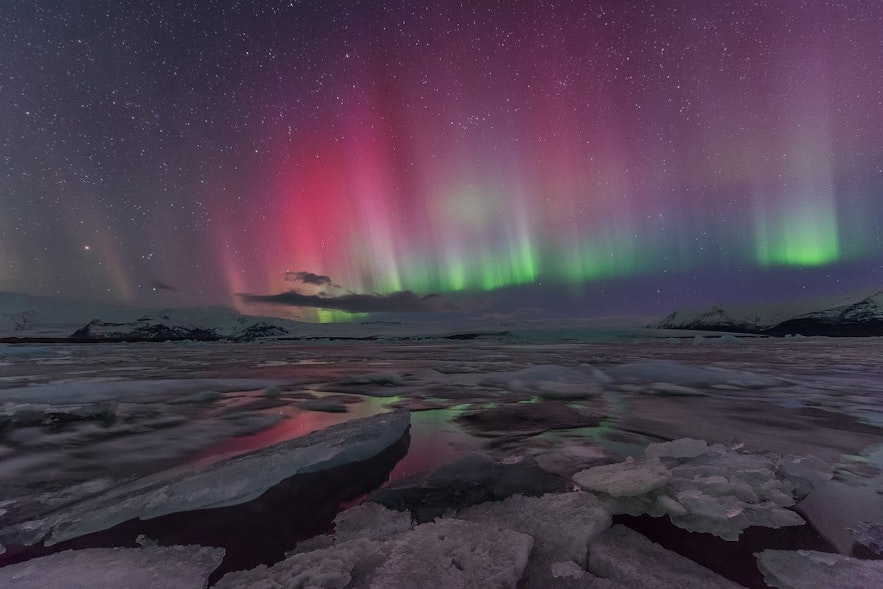
Learn the best time of year to see the northern lights in Iceland. Find out which are the best seasons and months for viewing the aurora borealis in Iceland.
The northern lights are one of nature's most magical sights, but they're also one of the most unpredictable. Maximize your chance of seeing nature’s most spectacular light show with this complete guide before embarking on a northern lights tour or renting a car on Iceland's biggest travel marketplace.
Iceland’s northern lights are one of its major attractions, but the aurora borealis are fickle. They’re only visible under certain conditions, at certain times of the year, and only with enough solar activity. Knowing when you can see the northern lights in Iceland is essential for ensuring you have the best chances of a once-in-a-lifetime viewing.
Top Northern Lights Tours & Holidays
2 day ice cave tour with south coast waterfalls & jokulsarlon glacier lagoon, 3-day northern lights tour of iceland’s golden circle & south coast with ice caving & glacier hiking, 8-day guided northern lights winter tour of the complete ring road of iceland.
- Get to know more about the aurora by reading Northern Lights in Iceland
- Find out all you need to know about Northern Lights Photography
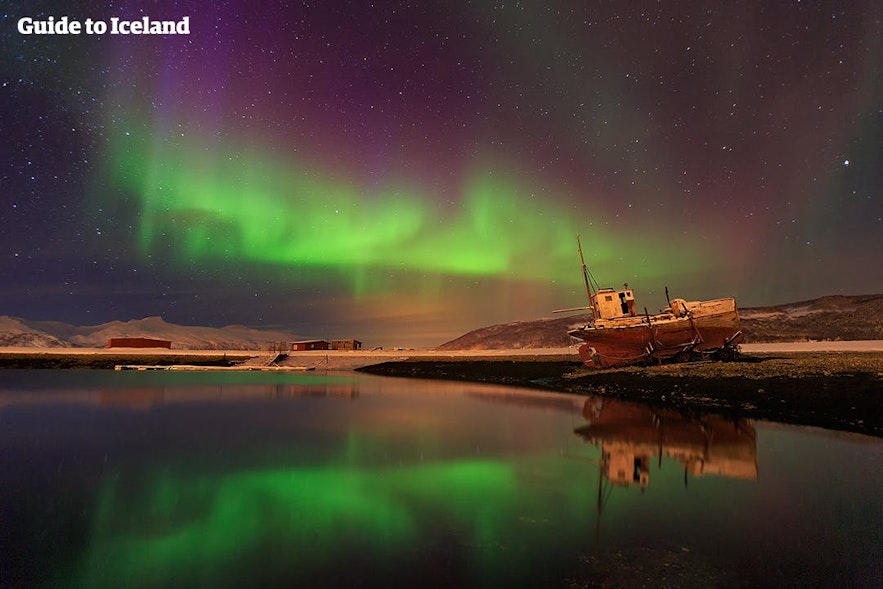
The best time to see aurora borealis in Iceland is between September and April. It’s when the nights are dark enough to see the aurora.
Iceland only gets 4-5 hours of daylight in midwinter, providing endless opportunities to hunt for aurora borealis during that time.
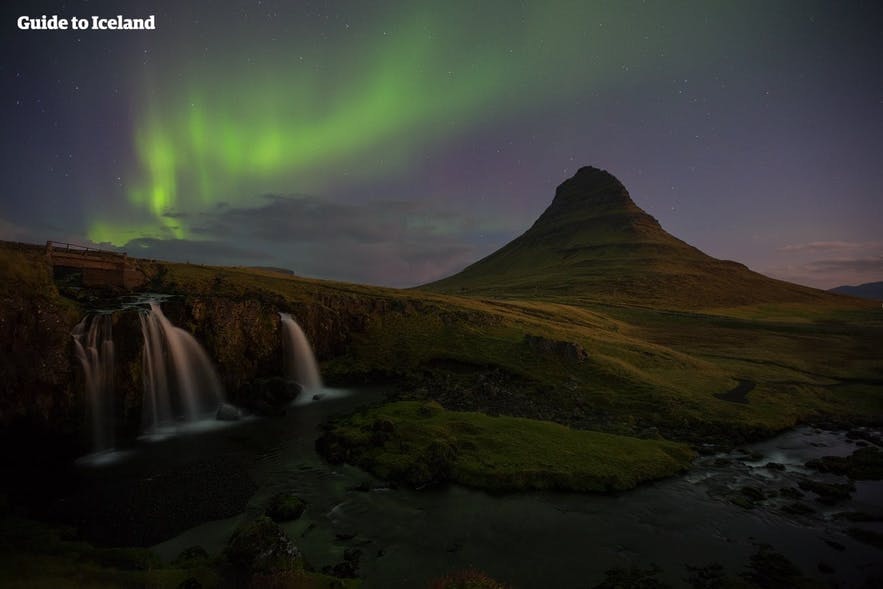
Northern lights tours run between September and April. While there’s no particularly optimum time between this range, the nights are the darkest from November to January. This means you can seek the aurora in Iceland from late afternoon until nearly noon the next day, which provides perfect conditions to photograph the northern lights .
This makes January the absolute best time to visit Iceland for the northern lights, although you have a good chance to spot the aurora borealis in Iceland until April. Then it’s a long wait until September.
- See also: Best Winter Activities in Iceland
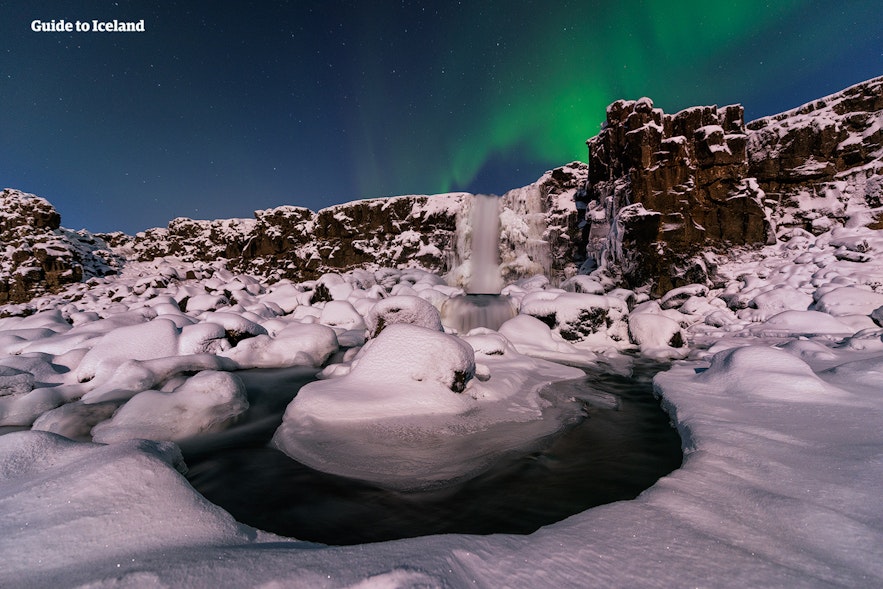
Another advantage of coming in midwinter is that you can see Iceland under a blanket of snow and make the most of Iceland’s other winter phenomena, most notably exploring the crystal blue ice caves , which are only found in a few other places worldwide.
The northern lights appear whenever there’s solar activity, but we can only spot them when it’s dark. Therefore northern lights tours only run in the winter months as the longer nights make the aurora borealis easier to spot.
In general, northern lights are visible between late August and mid-April in Iceland. But that also depends on several other factors. For the best time to go to Iceland for the northern lights, it’s best to aim for the weeks around the winter solstice.

Photo from Mesmerizing 25-Minute Northern Lights Show at Perlan Museum in Reykjavik
Though the urban light pollution usually hampers visibility, you can sometimes see the northern lights from the city center of Reykjavik. There are also areas within and around the city where the lights are more visible. Look for parks and coastal areas, like the Grotta nature reserve or the Sun Voyager sculpture, that are more isolated.
If you want some unique northern light experiences while in Reykjavik, you can combine a northern lights tour with a visit to Aurora Reykjavik , an exhibition dedicated to the aurora borealis. Alternatively, check out the award-winning Northern Lights Show at the Perlan Museum observatory!
- For more, check out the Best Places to See the Northern Lights in Reykjavik
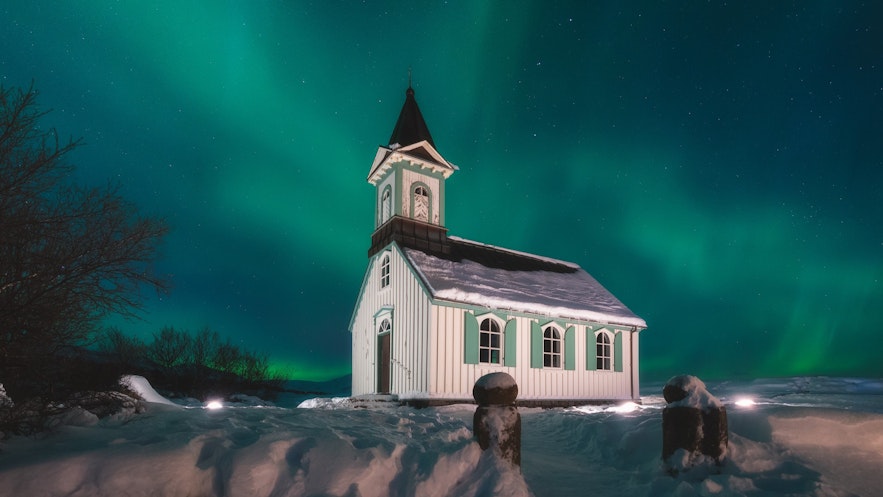
The solar wind is the reason behind the appearance of northern lights. The Kp-index forecast is the measurement unit used to indicate the level of solar activity. The optimum level is above three, and you can check this on the Aurora Forecast in Iceland.
The Icelandic Meteorological Office also has an aurora forecast on cloud covers in Iceland to help you find the best place to spot northern lights.
The darker it is, the easier it is to spot aurora borealis. You can still see the northern lights in Reykjavik and other cities, but the best results are from the remote countryside. See our tips for finding aurora borealis yourself in Iceland , including how to see the northern lights in Reykjavik.
So there is no straight answer to when you can see the northern lights in Iceland since it isn’t just dependent on the season or month but also the meteorological and solar conditions.
Iceland’s Northern Lights Season
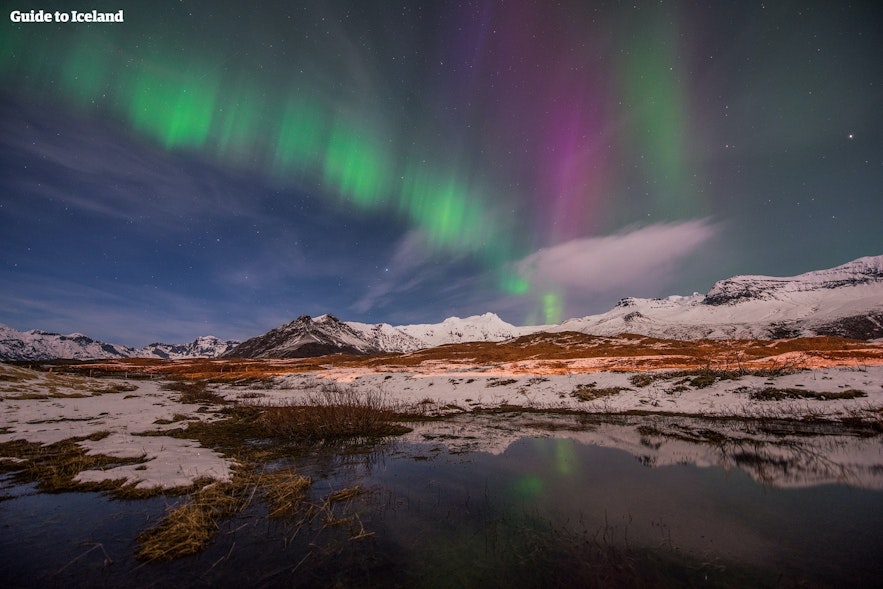
The best time of the year to see the northern lights in Iceland is undoubtedly the winter months. However, throughout these months, Iceland endures its worst weather.
Clouds can block the sky, and therefore the aurora borealis, for weeks at a time. Storms are also more common this season, occasionally leading to the cancellation of tours or the closure of main roads.
There are still plenty of winter activities in Iceland you can enjoy. You can go ice caving , snowmobiling , and glacier hiking before setting out to explore the northern lights each night.
Iceland’s weather is milder in autumn and spring (if still very unpredictable), meaning less chance of cloud cover, although note that the window of opportunity for northern lights hunting is smaller due to the increased daylight hours.

However, many summer tours extend into these months, allowing you to do more when the auroras are not visible. The Thrihnukagigur Inside the Volcano Tour continues until October and will enable you to descend into and explore a vast, unbelievably colorful magma chamber.
Whale-watching from the whale-watching capital of Europe, Husavik, begins in March and lasts until November, providing you the chance to marvel over the giants of the deep.
Keep in mind the best time for northern lights in Iceland is the winter months. However, seeing them in late autumn and early spring is still possible.
In the summer equinox weeks at the end of June, the sun never sets in Iceland. Instead, it circles the sky, touching the southern horizon but never quite sinking below it. The brightness of this ‘ Midnight Sun ’ entirely obscures the northern lights. Through the end of May, the entirety of June and July, and the beginning of August, the nights are still too bright to see the auroras.
- See also: The Midnight Sun in Iceland
Despite this, you can still see the aurora borealis faintly during the short hours of darkness at the very beginning and end of summer. Usually, they will be seen dimly against a dusky sky, often making for a uniquely beautiful display considering how vivid the colors of Iceland’s sunsets can be.
Even so, you have much less chance of seeing Iceland’s aurora borealis during these times, as they will need to be particularly intense to be visible, and there’s a much smaller window of opportunity to seek them. Suppose you want to see the aurora borealis in Iceland while still enjoying relatively mild weather and the option to partake in most summer activities. In that case, it’s recommended you come in September.
Top September Tours
- See also: Iceland in September
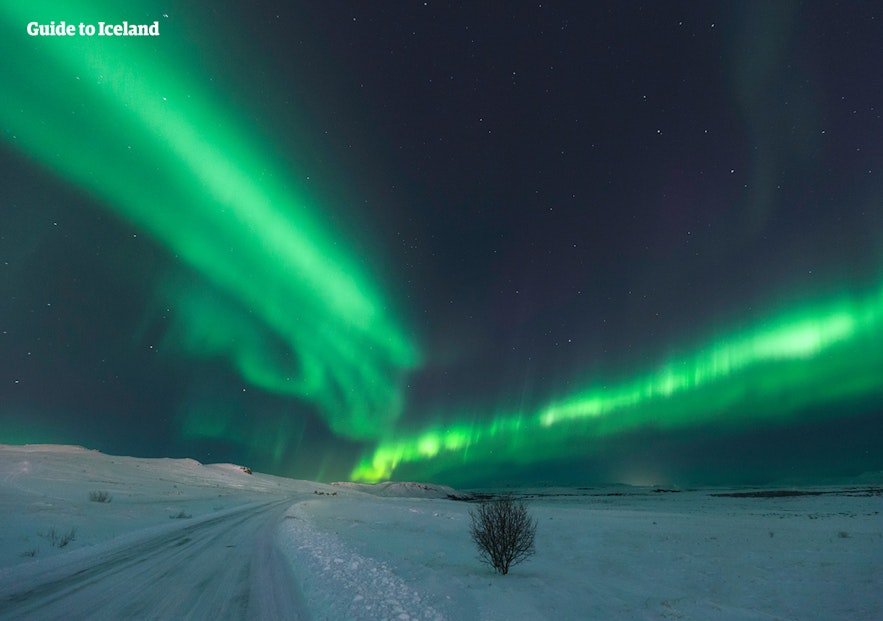
You can see the aurora borealis in Iceland whenever the sky is dark. Therefore, in December , they may be visible from three in the afternoon until nine in the morning. However, due to the Earth’s rotation, atmosphere, and magnetosphere relative to Iceland’s position on the globe, they are most likely to be seen between 10 PM and 12 AM.
This is when most northern lights tours set off. It also means that when the tours end, you’ve searched through the optimal time and back home early enough that it won’t compromise your plans the next day.
If you’re renting a car in Iceland and taking a winter self-drive tour tailored to the aurora borealis, you can search for the northern lights throughout the night. But you should remember to avoid sunrise and sunset when light pollution significantly dims them. If you are out well into the early hours hunting for the auroras, it’ll be noticeably colder, so dress accordingly.
Top Winter Self Drive Tours
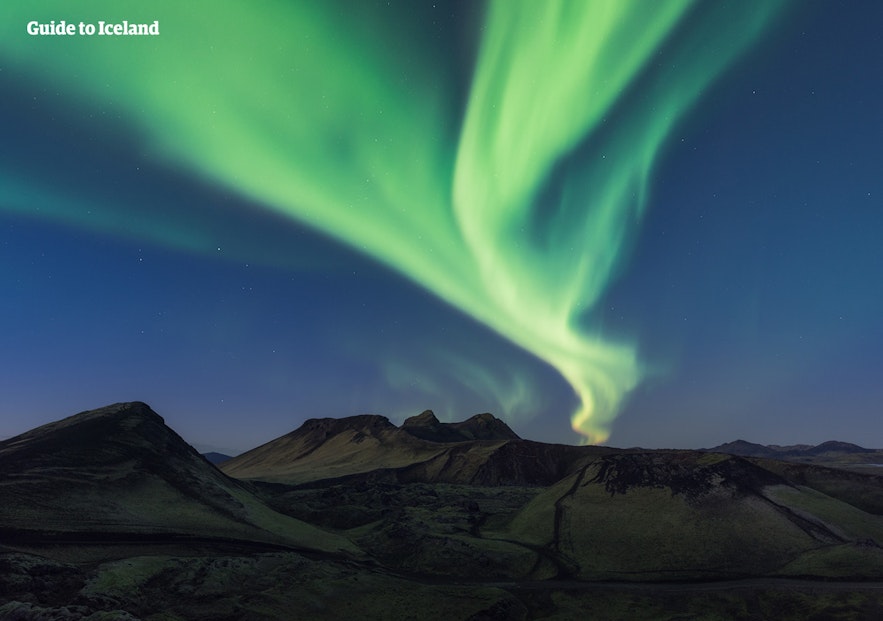
Witnessing the northern lights in Iceland always requires some luck. Some travelers dead-set on aurora hunting may encounter cloud cover or a lack of solar activity every night of their holiday. Others, traveling for one night in August , might be blessed with a fantastic show without even looking for it.
Other than waiting for a clear winter’s night, there are several ways to optimize your chances of enjoying a fantastic display of the aurora borealis in Iceland.
Just hoping you see a northern lights display without laying any groundwork is probably not the wisest option. There are several easy steps you can take to increase your chances:
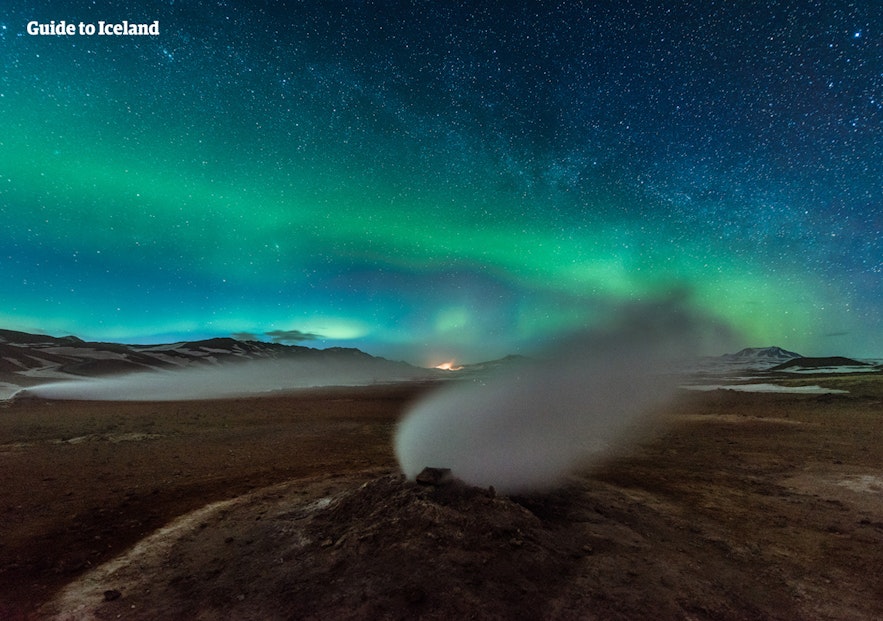
All lights have the same dimming effect on the auroras as the sun. If you’re in Reykjavik and want to see the northern lights, you must move away from the light pollution. You can take a bus to the Seltjarnarnes Nature Reserve , which is fairly dark compared to the rest of the city. However, you are more likely to achieve better results by booking a tour or driving out into the dark surrounding landscapes.
If you are on a guided package or self-drive tour, your route will take you out into the reaches of Iceland’s nature, maximizing your chances of catching a show every night.
If traveling to Iceland for just a weekend, you only have two or three nights in which to go aurora hunting. Considering the unpredictable weather and fickle nature of the aurora borealis, you’re not setting yourself up for success.
You’re statistically more likely to see the northern lights by staying in Iceland for an extended time.
A two-week-long vacation spent in different parts of the country will significantly increase your chances of a lucky night in perfect conditions.
Travelers could also consider spending much or all of their holiday in North Iceland . The nights here are longer, and the sky is usually less cloudy, providing increased opportunity. During the northern lights season, the north is also less busy than the Reykjavik area, allowing you to avoid the crowds at the most scenic viewing spots, such as the marvelous Myvatn lake or frozen waterfall Godafoss .
Iceland’s weather website has regularly updated pages revealing the predicted and current cloud cover around the country, allowing you to plan to reach the areas with the clearest skies. The aurora forecast measures from zero to nine, with three and above considered promising.
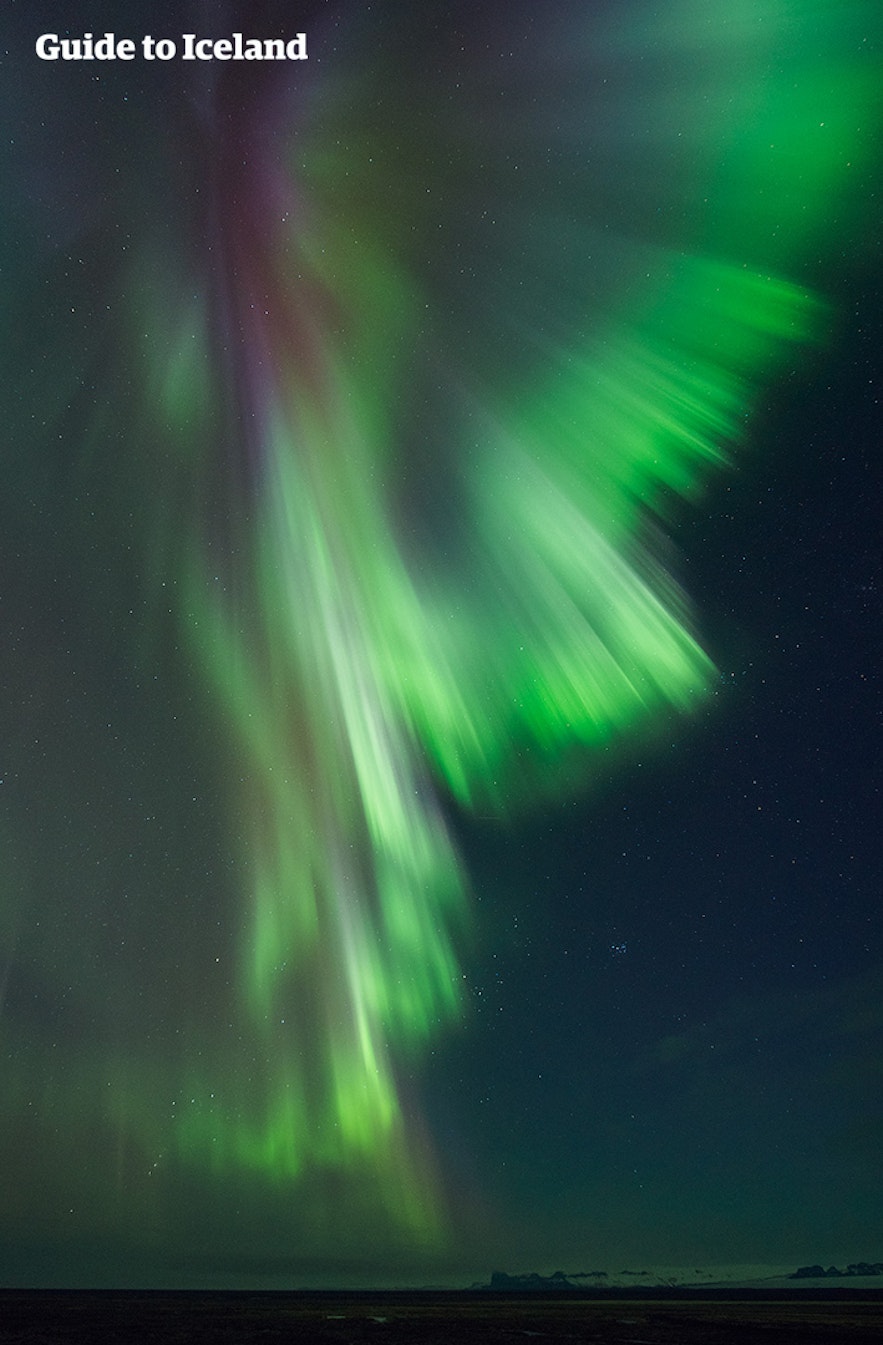
It'll take several minutes for your eyes to adjust to the darkness of Iceland's winter nights, so stay a while at each spot, even if the sky appears clear. The northern lights can also begin at any moment, so don't rush away if they aren't immediately active.
Make sure you have many layers of warm clothes - and perhaps some hot cocoa -so you can comfortably wait for the auroras as long as you need. When it comes to northern lights hunting, just a little bit of patience can lead to the most incredible rewards, which no doubt you will remember for the rest of your life.
Do you have any other questions about hunting the northern lights in Iceland? What time of year are you planning to visit? Are you considering a self-drive trip or taking a northern lights tour? Log in to Facebook to see or add to the comment section below!
Popular articles

Guide to Iceland | The Story of the Leading Travel Agency of Iceland

The Complete Guide to the Midnight Sun in Iceland

Top 20 Most Beautiful Waterfalls in Iceland

22 Photos of the Aurora in Iceland

Mountains in Iceland
Other interesting articles.
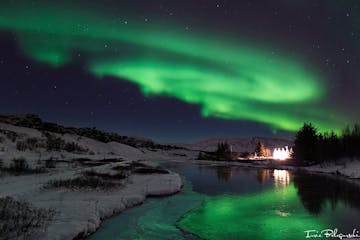
How to Photograph the Northern Lights
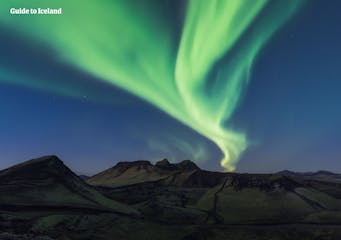
FAQ About the Northern Lights in Iceland | Science & Mythology
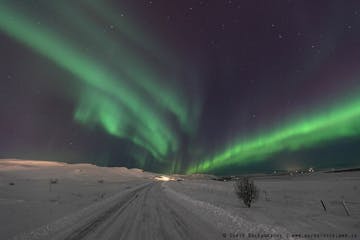
The Best Northern Lights Hotels in Iceland

Download Iceland’s biggest travel marketplace to your phone to manage your entire trip in one place
Scan this QR code with your phone camera and press the link that appears to add Iceland’s biggest travel marketplace into your pocket. Enter your phone number or email address to receive an SMS or email with the download link.
Top things to do in Iceland
Book your complete trip with the best companies only

Visit a Live Volcano

Visit the Blue Lagoon

Go on a Road Trip

Do the Golden Circle

See the Glacier Lagoon

South Coast Tours

Find the Northern Lights

Explore an Ice Cave
Best time to visit Iceland

The best time to visit Iceland is between September and March to see the Northern Lights, or between June and August for summer activities. While travel to Iceland may depend on your desired itinerary, generally, the best time to visit is during the summer. During this time, you’ll experience warmer temperatures and long days of sunlight, known as the spectacular midnight sun. While the summer boasts green countryside and animal spotting, the winter is the best time for the Northern lights and the country’s famous geothermal spas when they may not be as busy!
However, if you’re planning a trip to see something specific, such as the puffin or whale migrations, you’ll need to visit during a specific time of year. We've broken down some main factors to consider before choosing when to travel to Iceland.
The phenomenal cosmic light show, known as the aurora borealis or the northern lights, is a natural event that occurs from late September to late March. The long and dark winter nights make it an ideal time to visit, however, because it is a sporadic event, a definite sighting can't always be guaranteed. You may be more likely to see the lights during the equinoxes that occur around the 21st/22nd of March and September.
Iceland’s famous Blue Lagoon is a year-round natural geothermal pool that is said to have healing properties and is situated among a scenic Icelandic landscape. This mineral-rich seawater contains a mix of silica, algae and other bioactive elements that can be particularly beneficial for certain skin conditions.
While the lagoon is open all year, if you’re hoping to visit with slightly warmer weather, you may want to visit in the summer months (May to August). That said, many travellers love to visit the springs in the winter months to be surrounded by the beautiful snowy hills of the region while they relax in the outdoor lagoon.
The Icelandic coastline is famous for its whale activity due to the cold waters and favoured feeding grounds of the local marine life. Between April to September is the best time to visit Iceland for whale watching as this is when the whales migrate north for the summer months. Keep a look out for humpback, minke, fin, sperm or even blue whales! You might even see other marine species such as orcas, dolphins, seals or harbour porpoises.
Best for: Þorrablót Mid-winter Festival and ice caves
While mid-winter weather and short days may deter some travellers, the colder months are also perfect for ice cave exploration and catching a glimpse of the Northern Lights. However, if you’d like to stay out of the weather, why not partake in the honouring of the Icelandic ancestors during the Thorrablot festival? While visiting in January, join locals on a historical Icelandic food tour that includes foods such as hangikjot (flavoured smoked lamb) or brennivin (a local distilled beverage).
Best for: Winter Lights Festival and Northern Lights
February is one of the best times to visit Iceland for some exciting food and cultural events. The two festivals, Winter Lights and Food & Fun are hosted annually by the capital Reykjavik and can add spark some joy in the coldest and wettest months of the year! But keep a watchful eye out for the Northern Lights.
Best for: Northern Lights, winter sports, Iceland Winter Games and the Annual Beer Festival
The longer and brighter winter days of March make it an advantageous time for winter sports. If you’re looking to downhill or cross-country ski, snowboard, snowshoe or hike the terrain, the nearest mountain is only a 20-minute drive away from Reykjavik.
Best for: puffins and golden plover migration, The Golden Circle and smaller crowds
April marks the start of the spring season in Iceland and the breathtaking return of several local bird species, including the world-renowned puffins and golden plovers. While the locals celebrate the first day of summer shortly after April 18th, this month is a perfect time to visit for lower off-season prices and fewer tourists. Remember that there may still be an assortment of rain, snow, hail or shine, so pack accordingly.
Best for: whale watching, nature adventures and long days
May in Iceland sees the end of the cold winter months, however, temperatures still sit between 1-11 degrees Celsius although there is less chance of snow. Towards the end of May, there can be up to 20 daylight hours which makes it a great time to do some fun outdoor adventures. Why not take a tour through the lava caves, hike your way across a glacier, snorkel or scuba dive in Icelan's pristine waters or even horseback ride along the countryside?
Best for: midnight sun, Hafnarfjörður Viking Festival, National Holiday of Iceland, Fisherman’s Day and the opening of some highland roads
Summer has arrived! With summer comes longer days and the peak travel season so prices are higher and attractions are busier. June is one of the best times to explore the natural wonders of the Icelandic countryside. However, with a great array of cultural, music and environmental festivals, there’s something for every interest. The end of May to the start of June is also the best time to see the famed midnight sun phenomenon in Iceland so make sure you bring a good sleeping mask!
Best for: Braðslan, nature photography and long days
July is the busiest tourist month of the year for Iceland. With sunshine, greenery and longer days, it’s a perfect time to engage in the bustling city life or explore the vibrant natural scenery. If you’re looking for a slightly less crowded time, try to book in for the start of the month before the local schools are on break.
Best for: Reykjavik Pride, Reykjavik Culture Night, National Festival, Verslunarmannahelgi, Þjóðhátíð and wilderness exploration
Visiting Iceland in August usually ensures full access to the country’s wilderness as inaccessible areas in winter are now fully open. As one of the hottest months, the weather in August - while still unpredictable at times – is best for exploring the rugged and idyllic terrain of the glaciers, volcanoes, hot springs and waterfalls of the Icelandic wild. If nature isn’t your thing, the local scene has plenty of events and attractions to fill your itinerary.
Best for: fewer crowds and mild weather
September marks the end of the busy summer months but temperatures can still fall between 5-10 degrees Celsius. With the bulk of tourists on their way home, you’ll find lower prices and smaller lines for attractions. This is a great time to go if you’re looking to surround yourself with great music or film. Note that some highland roads will be closed by the end of the month for winter.
Best for: Northern Lights and berry picking
See the vibrant autumnal colours that blanket Iceland during October as the temperatures lower and leaves drop. As the colder months set in, plan for the Northern Lights as they can easily be seen at this time of year, especially when away from city areas without cloud cover.
Best for: hot springs, ice caves and Northern Lights
November brings winter into full steam with a drop in temperatures and daylight hours. Winter is often the most scenic time to visit one of Iceland’s many hot springs and relax in the white-blanketed scenery. With the drop in temperatures comes the reformation of the ice caves making November a perfect time to transverse the chilly blue caves and stunning glaciers.
Best for: New Year’s Eve, frozen waterfalls, glacier exploration, Christmas villages and festive lights
Looking to party into the new year? Iceland’s eclectic music scene and picture-perfect Christmas villages can provide you with day-to-night entertainment. While December is known as one of the coldest and windiest months, the Northern Lights are often viewable during this time. Just note that some hotels, services and attractions are closed during the winter.
Let's create an exclusive trip for your group.
Chill out: Beat the summer heat with these cool escapes
Why 2024 is the best year to see the northern lights
How the Icelandic hot dog became an international icon
Iceland’s Folklore: 4 mythical creatures that make the scenery come alive
Top 12 things to do in Iceland
6 of the best hikes in Iceland
10 ways to get closer to nature with Intrepid
In sickness and in health: How I ended up getting married on an Intrepid Iceland trip
We earn a commission for products purchased through some links in this article.
The best solo travel destinations, according to a long-time solo traveller
Travelling alone can be one of life's most rewarding experiences, says Tracey Davies, editor of 101 Singles Holidays

Solo travel is having a real renaissance right now. According to American Express’ latest Global Travel Trends report , 69 per cent of travellers are planning to go it alone this year, with women in the post-45 age bracket leading the charge. There are many reasons women choose to travel on their own: separation from a partner, a sabbatical from work, seeking empowerment and freedom, or simply wanting to do things their own way for a change.
So, if you’re looking for a yoga retreat in Spain , want to explore the Golden Triangle in India , or even snuffle for truffles in the forests of Slovenia , there are a million and one solo holiday ideas to garner inspiration from. Here are some of my favourites…

History in Edinburgh , thronging nightlife in Glasgow, heather-strewn glens in the Highlands – Scotland is a brilliant place to explore, period. Solo adventures to be had in Scotland could include a walking holiday in Glencoe, monster-spotting in Loch Ness or island hopping around the Hebrides .
See the best of the Highlands on a four-day Good Housekeeping tour this July, which includes a ride on the world-famous Jacobite steam train from Fort William to Mallaig. The train passes the stunning slopes of Ben Nevis, numerous dazzling lochs and the 21-arch Glenfinnan Viaduct (pictured), made famous by the Harry Potter film franchise.
Other highlights of this tour include a ride on the Falkirk Wheel boat lift and a cruise along the Firth of Clyde on the PS Waverley, the world's last ocean paddle steamer.

Spain hits the top spot as one of the easiest places to travel solo. It has Mediterranean beach resorts, buzzing cities abundant with cool bars and restaurants (like Granada, pictured), and small towns and picturesque villages that are perfect for pottering.
Add in a straightforward and reliable transport network, a plethora of solo accommodation options and friendly residents, it's easy to see why Spain is a great choice for a solo sojourn.
The Healthy Holiday Company offers numerous wellness trips throughout Spain. One of the best for solo travellers is Shanti Som, a small, boutique retreat in Andalusia. With just 15 rooms it offers an intimate experience plus has a yoga pavilion and gorgeous little spa that offers different treatments and therapies. FIND OUT MORE

Italy is incredibly welcoming to the solo traveller. Have you read the book or seen the movie Eat, Pray, Love ? Our hero Elizabeth Gilbert fell in love with the country’s great food, romantic language and utterly charming locals. Italy's also an easy country to get around in, thanks to its excellent transport network.
One of my favourite cities in Italy is Bologna (pictured). Known as La Grassa ('the fat one'), the northern city is a mecca for gastronomes . As well as feasting on hearty pasta dishes and locally-made wine, Good Housekeeping's six-day foodies tour (which begins and ends in Bologna) visits producers of Parma ham, balsamic vinegar and Parmesan, and includes an Italian cooking class in the neighbouring city of Modena.
FIND OUT MORE

Considered one of the safest countries in the world, Norway is the perfect destination for solo travellers, especially those looking to embrace friluftsliv , the Norwegian concept of enjoying the great outdoors.
Like other Nordic countries, Norway is incredibly well organised, efficient and easy to traverse. It also has a fantastic, solo-friendly dining scene with a focus on home-grown, seasonal produce.
Norway is one of the best places on earth to witness the Northern Lights , so join Good Housekeeping on this fantastic 12-day Norway cruise with no single supplement.
Departing November 2024 , you'll sail on a Hurtigruten ship, stopping off at the UNESCO-listed port of Bergen, the Lofoten Islands and Tromsø. As you cross the Arctic Circle, the chances of spotting the aurora borealis are almost guaranteed.
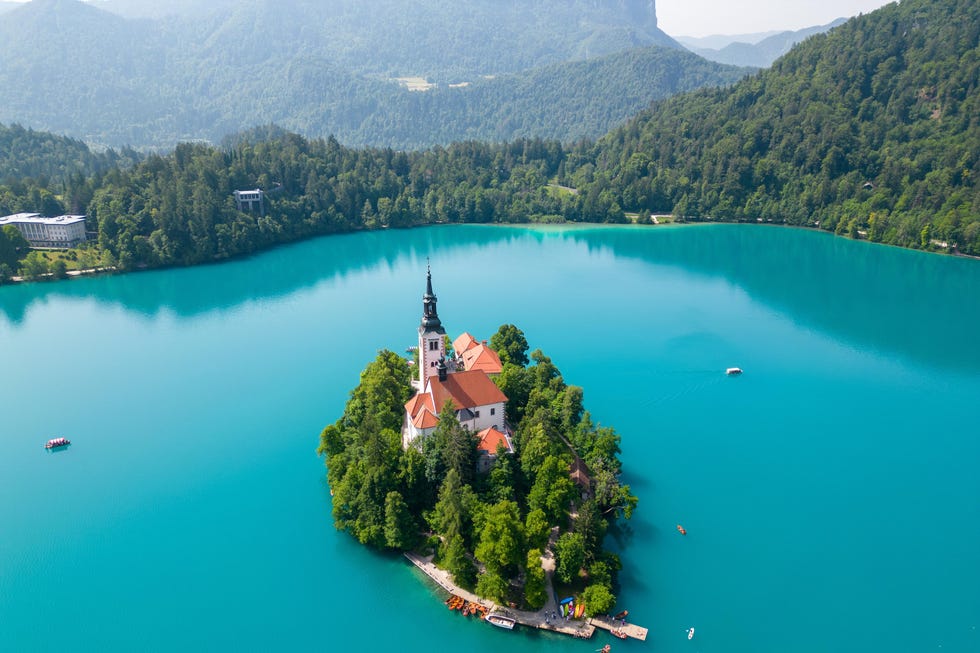
Famously welcoming, Slovenia is the perfect destination when travelling alone.
Bordering Hungary, Italy, Austria and Croatia , this small but mighty country is relatively straightforward to explore, thanks to its efficient transport system. The fact that there's also plenty to see and do – and that most people speak English – means it should be on any solo adventurer’s must-visit list.
This six-day guided Slovenia adventure , departing in October 2024, is a great introduction to Central and Southeastern Europe. The trip begins and ends in Ljubljana, Slovenia's cobblestoned capital, and includes tours of Triglav National Park, Lake Bled (pictured) and the UNESCO-listed Skocjan caves.
You’ll also enjoy wine tasting in the Vipava Valley and an afternoon learning about the art of truffle hunting.

For the original Shirley Valentine experience, look no further than Greece and its beautiful islands. Greece is ideal for solo travellers, whether you want to hoover up the ancient history in Athens or hop around the islands, relaxing on beaches and dining Shirley-style in traditional tavernas.
With an abundance of sprawling beach resorts, white-washed fishing harbours and rugged mountain villages to pick from on the islands, the hardest part is choosing which one to visit.
If you're looking to explore your creative side, check out learning holidays company Skyros . Staying in a rustic eco-lodge, this week-long holiday on Skyros (pictured), in the southern Sporades, includes creative writing sessions, stand-up comedy workshops and relaxing yoga classes.

As our closest continental neighbours, France is a good place to start when venturing abroad solo. It's easy to get around, dining alone is welcomed and the French are very accustomed to tourists.
Follow in the footsteps of Claude Monet on this four-day Good Housekeeping holiday taking in Paris and Giverny. Great for single travellers with a passion for art, the base for the trip (departing in July 2024) is the four-star Château de Montvillargenne in the heart of the Chantilly forest.
Excursions include a visit to Château de Chantilly and the market town of Senlis plus a guided tour of Monet's gardens in Giverny (pictured) led by gardening expert and writer Paula McWaters.

Considered to be one of the most captivating landscapes on the planet, Iceland is a must for any adventurer, including those going it alone.
With incredibly welcoming locals, Iceland is known as the Land of Fire and Ice, and offers visitors the chance to bathe in hot springs, climb sheer glaciers or come face-to-face with feisty volcanoes. To see this vast landscape in style, it's well worth joining a group tour (ideal for solo travellers) or hiring a car.
Soak in the famous Blue Lagoon (pictured), see the Skógafoss waterfall and hike up the Sólheimajökull glacier on an exhilarating five-day tour of Iceland. Hosted by Regent Holidays , this is a great option for solo travellers aiming to tick off a range of Iceland activities.

India was one of the first countries I ever travelled around alone (talk about throwing myself in at the deep end!) and while it was challenging in parts, it was also rewarding and transformative.
Whether you're looking to hike the Himalayas, 'find yourself' through yoga and meditation on a retreat or marvel at the Taj Mahal, India's unique culture and vibrancy is bucket list-worthy.
One of the easiest ways to explore India on your own is on an escorted tour. Solos Holidays itineraries are made specifically for the single traveller, and their Splendour's of Rajasthan tour explores the Golden Triangle of Jodhpur, Jaipur and Agra. Highlights include seeing the Taj Mahal at sunrise (pictured) and visiting the Amber Fort in the Aravalli Hills.

Gorgeous white beaches, rugged national parks and perhaps the prettiest medieval walled city in the world (hello, Dubrovnik ), Croatia is one of my favourite places in Europe to explore by myself.
Croatia is an easy country to get around, whether you want to go island hopping by ferry, catch a coach along the Adriatic Coast or hire a car to explore the country’s rugged interior.
If you want to see Croatia with a some like-minded folk, consider booking an escorted tour with Just You , a solo holidays specialist. Their Croatia and the Markarska Riviera trip focuses on the Dalmatian Coast and is bookended by stays in Zadar and Dubrovnik. It also includes a brilliant boat trip to Hvar and Brac (pictured), and a visit to Krka National Park.
More travel ideas:
- The best cruises for 2024
- Venice's hidden gems
- The 2025 holidays worth booking in advance
- The best mother-daughter holiday ideas
- Amazing holidays with celebrity guests

@media(max-width: 64rem){.css-o9j0dn:before{margin-bottom:0.5rem;margin-right:0.625rem;color:#ffffff;width:1.25rem;bottom:-0.2rem;height:1.25rem;content:'_';display:inline-block;position:relative;line-height:1;background-repeat:no-repeat;}.loaded .css-o9j0dn:before{background-image:url(/_assets/design-tokens/goodhousekeeping/static/images/Clover.5c7a1a0.svg);}}@media(min-width: 48rem){.loaded .css-o9j0dn:before{background-image:url(/_assets/design-tokens/goodhousekeeping/static/images/Clover.5c7a1a0.svg);}} Travel
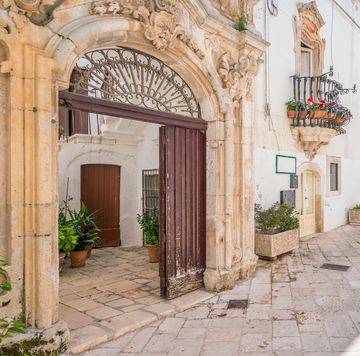
The best luxury hotel offers

14 of the most stylish weekend bags

The best Lake Como hotels
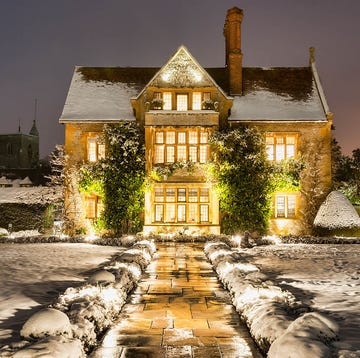
18 best Christmas hotels in the UK
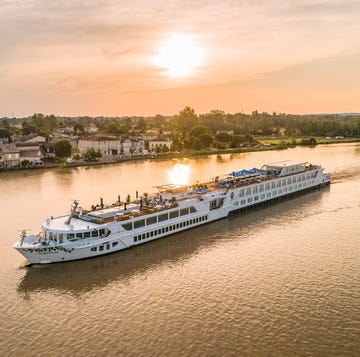
An ultimate guide to Bordeaux river cruises
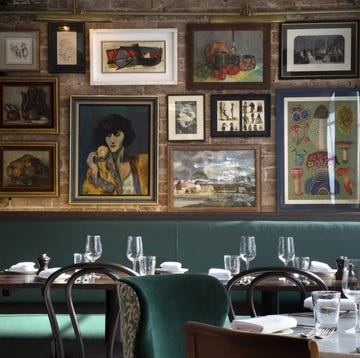
19 restaurants with rooms for gourmet getaways

The best luxury train holidays

The best hotels in Rhodes
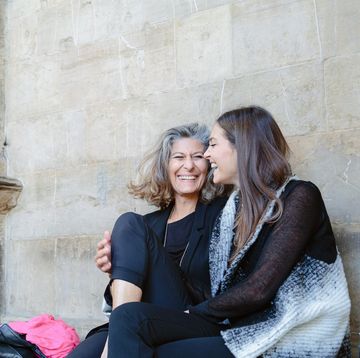
11 of the best mother-daughter holidays for 2024

Greece holiday destinations: Best places for 2024
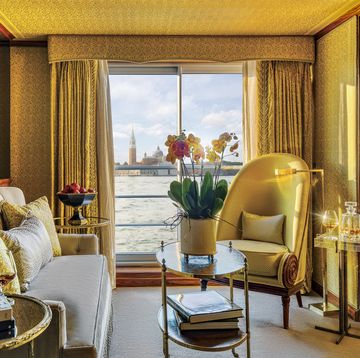
A look inside Uniworld's opulent suites
‘Overtourism’ crackdown enters Iceland as the country plans new measures to prioritize locals over hot-spring-obsessed visitors

Iceland has a complicated relationship with tourism.
Home to hot springs and volcanos, Iceland has sought to lure tourists with its stunning natural attractions. This set off a meteoric rise in visitor numbers, soaring from less than 500,000 in 2010 to an expected 2.3 million this year. While that’s created a cash cow for Iceland’s tourism industry, it’s also created fresh housing troubles for those who call the country home.
But the country has had enough. It now wants to clamp down on “overtourism” with taxes and higher fees to curtail tourist numbers while not harming a lucrative sector of its economy.
“We are trying still to mold the taxation system for the tourism sector for the future,” Icelandic prime minister Bjarni Benediktsson told CNBC on Monday.
A possible new measure would be similar to surge pricing, wherein a higher tax would be charged during peak travel than at other times of the year—although this is still in the works, Benediktsson added. He also said a “sustainability balance check” was considered to look after Iceland’s nature and local communities.
Earlier this year, Iceland reintroduced a tourist tax that it scrapped during the COVID-19 pandemic. The modest fee—around 600 Icelandic krona ($4.34)—applies to hotels, campsites, cruise ships, and other forms of accommodation. While Benediktsson sees the measure as an “important decision,” he also thinks more must be done.
“We would like to lean more towards a system where the user pays. As I see it, we would want to go more toward accession fees to the magnets, as we call them, around the country,” the prime minister said.
Tourism is important to the Icelandic economy, as it derives 8.5% of its GDP from the sector, according to data from Statistics Iceland . From Game of Thrones fans to Blue Lagoon enthusiasts, Iceland has piqued the interest of many. The number of visitors has increased in the last few years despite interruptions like the COVID-19 pandemic and volcanic eruptions .
At the same time, locals have wrestled with finding homes to rent as more are swept into short-term rentals for visitors. Prices have also increased with higher interest rates , often pricing tenants out.
Iceland isn’t alone in resisting overtourism: Venice recently imposed a $5 short-term visitor fee that could help curb footfall in a city that’s famously swamped with tourists for much of the year.
Given the interest in the historic Italian city, Venice collected €37 million ($39.6 million) from tourist taxes last year.
On the other hand, Spain has included a new fee that reflects on hotel bills, contributing toward a fund for heat pumps and solar panels at schools.
“So far we have spent these taxes on compensating the impact tourists have on the city, including cleaning services, safety, and public transport,” Jordi Valls, Barcelona’s head of economic and tourism promotion, told Bloomberg in February. “This year we’ve decided to go a step further and spend the tax on financing public services from a climate point of view.”
It’s unclear whether these charges will turn away enough visitors to solve the issue of overtourism and its consequences. In Venice, for instance, the new charge hasn’t depressed visitor numbers just yet. Locals have also protested against the tourist tax policy, arguing it might not have as much of an impact.
With the pandemic in the rearview mirror, thousands of more tourists are expected yearly in Iceland. The country has the tall task of finding policies that strike a balance: encouraging tourists to still come to the city, while limiting their numbers and prioritizing the locals.
Latest in Lifestyle

Spain cracks down on smartphones for children, as statistics reveal one in five toddlers aged 3 or 4 own a smartphone

How a German Olympian helped take on CrossFit to build Hyrox, the next-generation fitness race with 34,000% growth

An Austrian heiress, who supports taxing the rich and doesn’t believe in philanthropy, just wrote away a large chunk of her $27 million fortune

Portugal may have cracked down on golden visas after a housing crunch—but repeat visitors who stay at an Airbnb are still very welcome

How to travel on a budget in Europe this summer? Use a roaming eSIM to avoid data fees
Most popular.

Bank of America tells Detroit’s Big 3 they can’t make money in China and should just leave the hypercompetitive car market ‘as soon as they possibly can’

Billionaire Melinda French Gates endorses a presidential candidate for the first time ever

Sleuthing L.L. Bean heiress discovered trees at her seaside home in Maine had been poisoned—now her neighbors have been fined $1.7m for their new ocean view

Nvidia stock surge: How much a $1,000 investment 10 years ago would be worth today

Brexiter and British billionaire, Jim Ratcliffe says Europe’s chemical industry is ‘finished’ and can’t compete with the U.S.

Five men were convicted for running Jetflicks, a low-cost streaming service that amassed more TV shows than Netflix, Hulu, and Amazon Prime combined

IMAGES
VIDEO
COMMENTS
It's one of the best months for experiencing many of Iceland's top attractions, such as ice caving, glacier hiking, and aurora hunting. Read on to discover the best things to do in January, learn about the temperature and weather, with tips for seeing the northern lights, and more. January is one of Iceland's darkest and coldest months.
While the beginning of the month is still as warm as July, temperatures start to go down by the end of the month. August is the best time to go to Iceland if you do not mind the crowds due to the fairly standard daylight hours. The sun sets around 9 PM and rises around 5 AM. August has the least cloudy days as well.
Iceland's winter weather is often described as harsh, but the temperatures are not as low as one might expect. Average lows are around freezing point, however, strong winds can make it feel much colder. January is the windiest month in Iceland. In the capital city of Reykjavik, temperatures typically range from -5°C to 5°C (23°F to 41°F ...
Therefore, for a winter trip, it's best to choose a home base and do day trips as weather permits. 2. You Might See the Northern Lights. During January in Iceland, northern lights hunting season is in full swing. January is one of Iceland's darkest months of the year, with only about 4-5 hours of daylight.
Additionally, the shorter days in January mean there are fewer hours of daylight, with sunrise typically occurring around 11 am and sunset around 3:30 pm, which can limit the amount of time you have to explore Iceland's beautiful landscapes. Another con of visiting Iceland in January is the potential for hazardous road conditions.
Here are my tips! General Iceland Weather in January : Temperature: Temperatures in Iceland in January typically range from about -5°C to 1°C (23°F to 34°F). However, temperatures can be lower, especially in northern and inland areas. Northern Lights: January is a great month for Northern Lights viewing.
January is a fantastic time to visit Iceland. It is one of Iceland's coldest months and usually the time of year were we experience the most amount of snow. But it also is one of the best months for northern lights. January tends to be slightly less expensive then the summer high-season for accommodation, flights and sometimes even tours and ...
June to August is the best time for outdoor recreation. While there's no good weather guarantee, this is your best chance of sun and warmish temperatures. Late June to early August is when most Icelanders go on vacation, filling up campgrounds wherever the best weather is forecast. This is the height of the tourist season - and height of ...
The average temperature in Reykjavik in January is between 1°C and -1°C (between 30°F and 33°F). The coldest temperature ever recorded in Reykjavik was -10°C (14°F). I think it's safe to say that no one wants this to be on holiday in Iceland when the weather decides it wants to beat its record.
The best weather in Iceland occurs in the summer, however, it can still be unpredictable. Iceland's temperatures in summer can be as low as 41 F (5 C) but as warm as 77 F (25 C) during this time of year. On average, Iceland's weather in summer is between 50-59 F (10 to 15 C).
For camping enthusiasts, the best time to visit Iceland is during the summer months, particularly from June through August. This period offers milder weather conditions and extended daylight hours. All the camping sites around the country, including those in more remote highland locations, are generally open and accessible during this period.
August is one of the best times to visit Iceland. It is the warmest time of the year to travel the Arctic Circle, and summer temperatures average around 15°C. Days are similar to most of the Northern Hemisphere, with the sun rising between 5 a.m. and 6 a.m. and setting between 9 and 10 a.m.
The Weather in Iceland in January You need to be prepared for icy roads in Iceland in January How to Travel Around in Iceland in January. ... While the warmer summer months are the best time to see species like minke whales, fin whales and humpback whales, as well as seabirds, dolphins and porpoises, winter is the best time for anyone wanting ...
Iceland weather in January. While the average temperature falls between -1°C - +1°C, it can range anywhere between -10°C and +5°C. January is one of those months in which it snows the most and the days are the shortest. Since gulf streams are the migrating factors for the temperature in Iceland, the water brought to the island is warm.
The best time to visit Iceland is during the summer, when the terrain is passable even in the more remote areas of the country. Iceland is located close to the Arctic, but the effect of the Gulf Stream means that it has a milder climate than many other places at the same latitude. Even with that mild climate, winters can be harsh, but summers ...
Outdoor lovers and hikers consider the best time to visit Iceland is July and August where temperatures are moderate and there are plenty of activities on offer. And February, March, September and October (spring and fall in Iceland) are considered the best months to visit Iceland by those seeking to see the Aurora Borealis.
Best times to visit Iceland for good weather. The ideal time for favorable weather in Iceland is the summer season, extending from late June to September. Temperatures during this time range from 12°C-20°C, and the sunny setting in Reykjavik is a delight to experience.
While it may be one of the best times of year to visit the country and view the auroras, keep in mind that it is also the most popular time of year for tourism. During December, most of the lodgings will be fully booked. January Considerations for January Northern Lights in Iceland: During the month of January, the skies are clearer than any ...
Situated near the edge of Vatnajökull National Park, it is one the best places to visit in Iceland in January because was created by melting glacial ice from Europe's largest glacier, Vatnajökull, which towers some 8,100 feet above sea level. ... January is an ideal time to see the Northern Lights, with long hours of darkness making them ...
Best Times to Visit Iceland for Good Weather. During the summer months — July and August — the temperature in Iceland hovers around 50 to 55 degrees Fahrenheit, making it a popular time to ...
Best 3-Day Itinerary: 3-Day South Coast - Golden Circle, Jökulsárlón, and Ice Cave. An explorer marvels at the glistening ice cave within Vatnajökull Glacier. Prepare yourself for the most amazing 3 days in Iceland in January. Explore the Golden Circle covered in a blanket of snow.
This means you can seek the aurora in Iceland from late afternoon until nearly noon the next day, which provides perfect conditions to photograph the northern lights. This makes January the absolute best time to visit Iceland for the northern lights, although you have a good chance to spot the aurora borealis in Iceland until April.
The best time to visit Iceland is between September and March to see the Northern Lights, or between June and August for summer activities. While travel to Iceland may depend on your desired itinerary, generally, the best time to visit is during the summer. During this time, you'll experience warmer temperatures and long days of sunlight, known as the spectacular midnight sun.
The best solo travel destinations, according to a long-time solo traveller Travelling alone can be one of life's most rewarding experiences, says Tracey Davies, editor of 101 Singles Holidays By ...
Home to hot springs and volcanos, Iceland has sought to lure tourists with its stunning natural attractions. This set off a meteoric rise in visitor numbers, soaring from less than 500,000 in 2010 ...